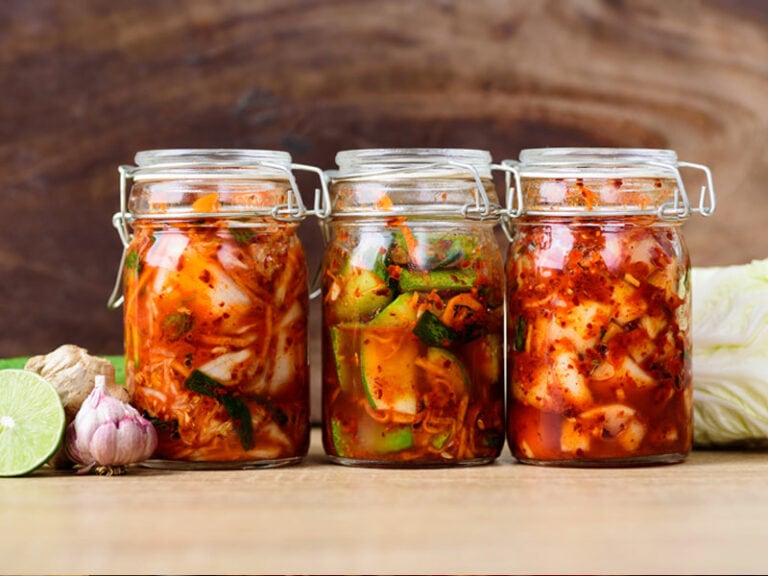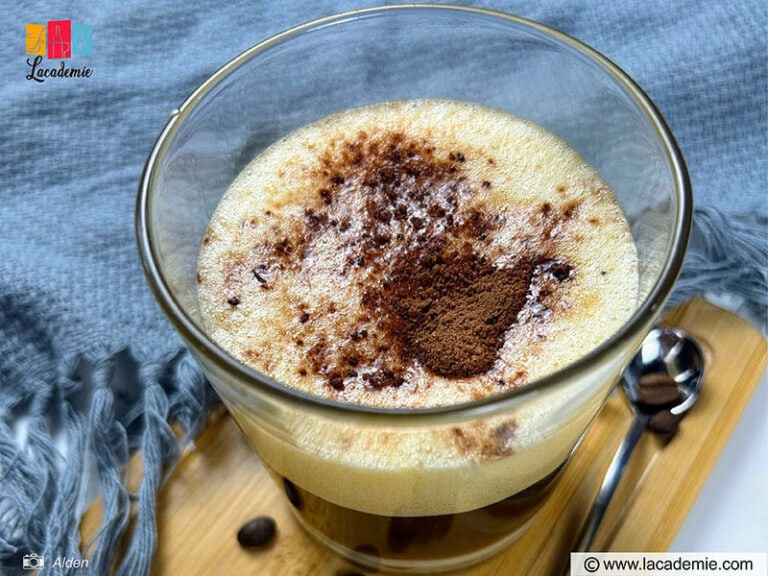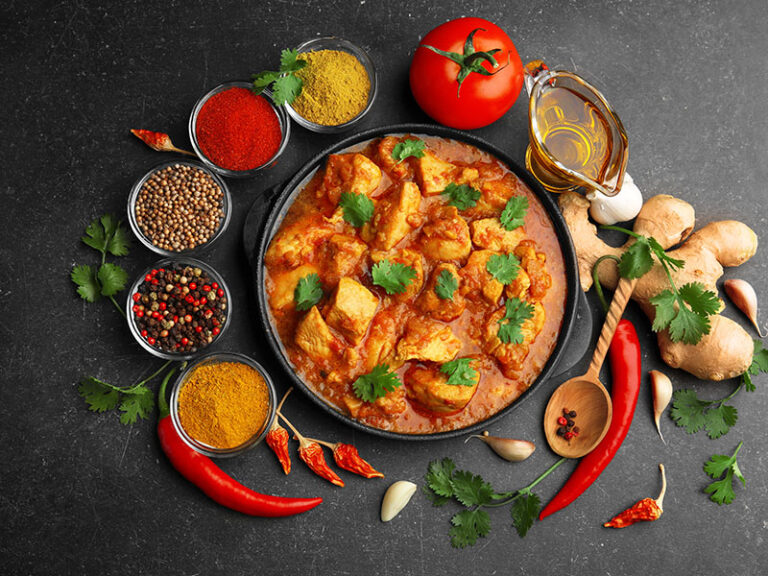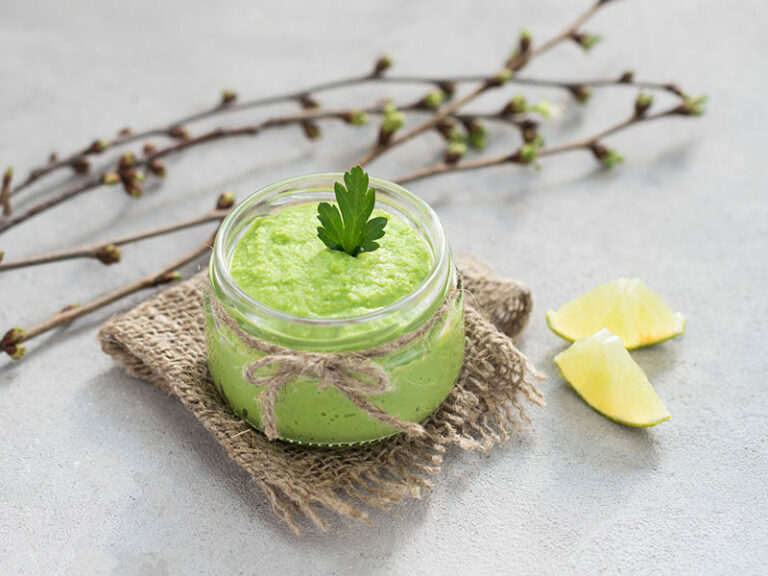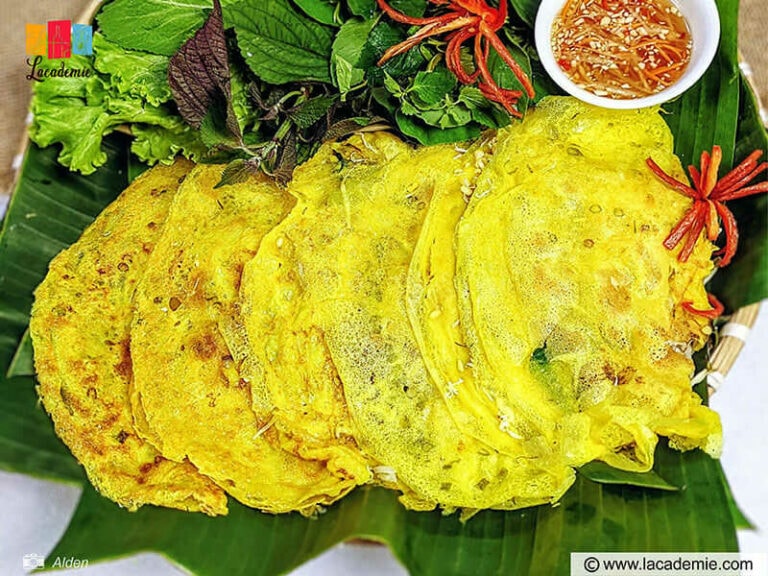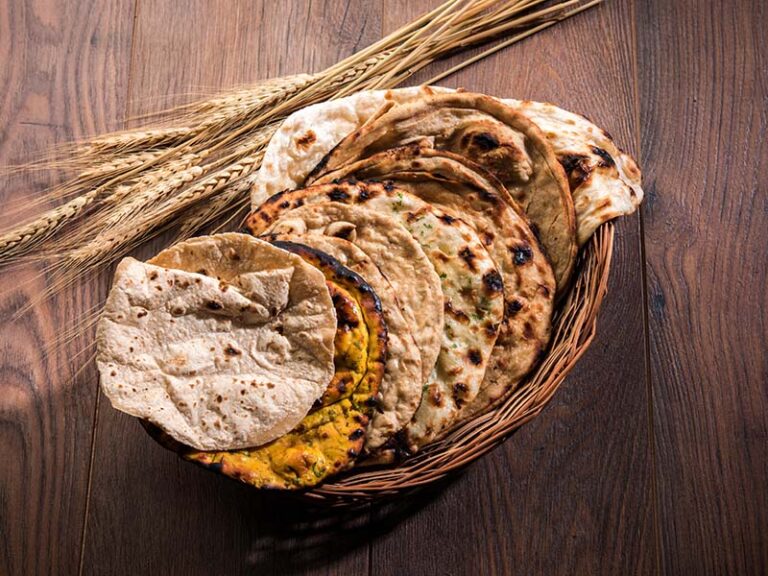Asian street foods are more than just quick bites; they’re a delicious journey into the soul of their respective cultures. Throughout this exploration, you’ll learn about many classic Asian dishes, traditional cooking techniques, and the stories these delights tell.
With this, you’ll not only satisfy your taste buds but also expand your culinary horizons and cultivate a deeper appreciation for the vibrant Asian cooking culture. Let’s check them out!
- In Japan
- In India
- In Vietnam
- In China
- In Taiwan
- In Turkey
- In Thailand
- In Indonesia
- In Hong Kong
- In Singapore
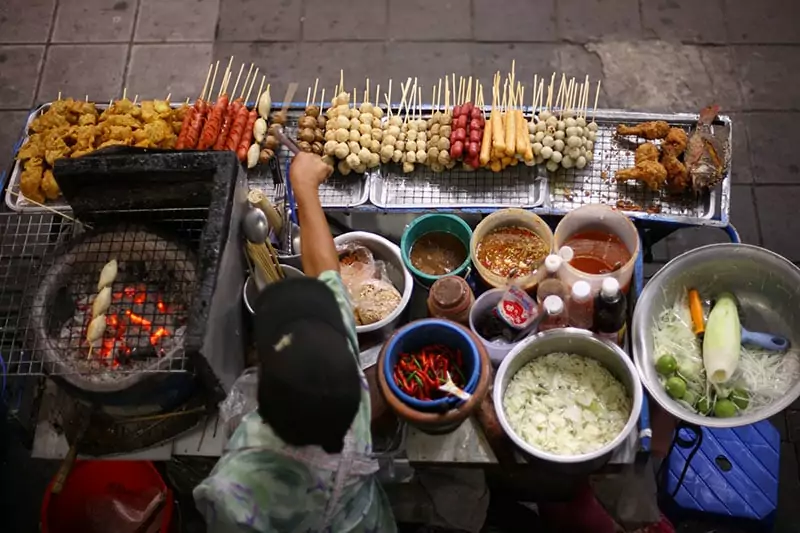
In Japan
1. Tsukune (Chicken Meatballs)
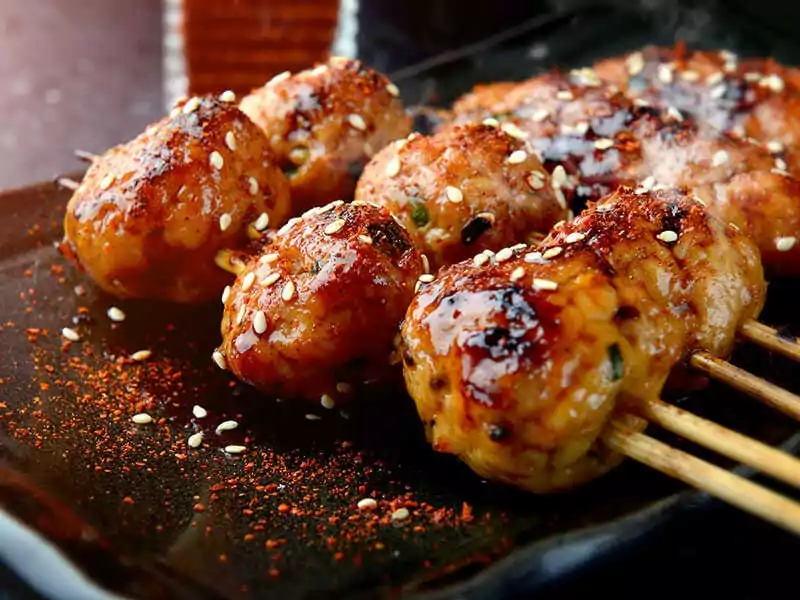
I’m always thrilled by the taste of Tsukune, the Yakitori version of chicken meat. These oblong patties or small meatballs are made from ground chicken, then skewered on bamboo sticks.
They are seasoned with salt and a tare mixture of sake, soy sauce, and mirin. Other components to enhance their flavor are scallions, onions, shiso leaves, garlic, and ginger. With raw egg yolk and toppings for serving, every bite of Tsukune is a flavor burst!
2. Takoyaki (Grilled Octopus Balls)
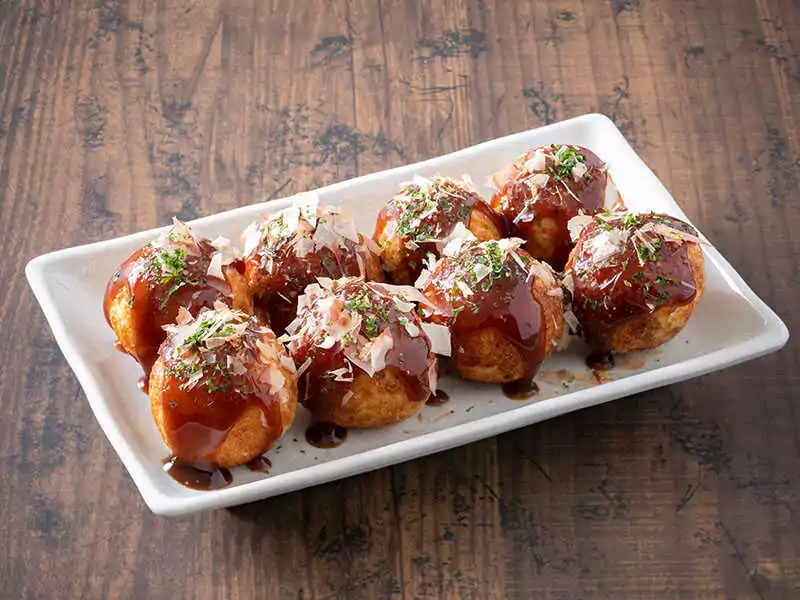
While venturing the bustling food streets of Japan, you can’t miss Takoyaki. Traditionally formed using an iron pan with round molds, the batter is made of wheat flour, soy sauce, and dashi stock, and has a small ball shape.
To cook them thoroughly, the seller uses a bamboo skewer to swirl them around. These dough balls are then topped with tender octopus pieces, scallions, pickled ginger, crispy tenkasu (deep fried flour-batter), and dried fish flakes.
For the best taste, you should top these octopus balls with Japanese mayonnaise, seaweed flakes, and fish flakes (bonito).
3. Taiyaki (Fish Shaped Waffle)
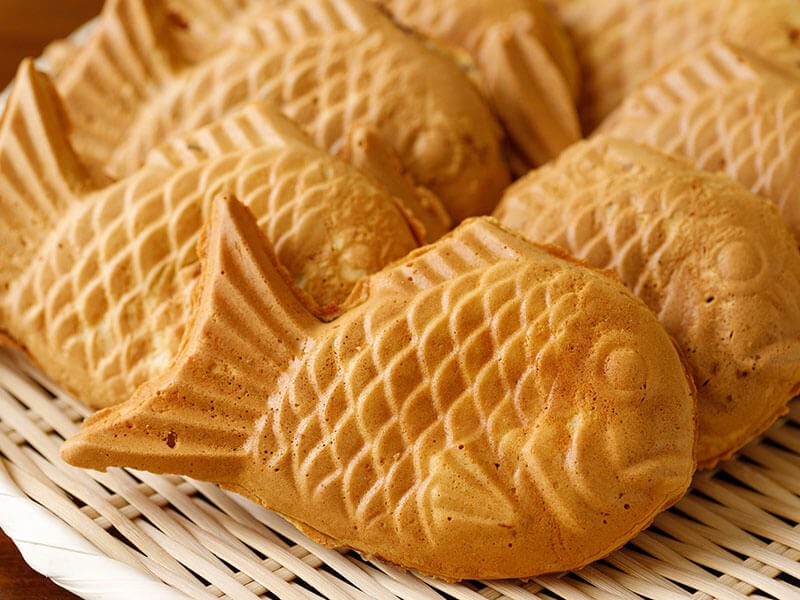
Originating from Tokyo’s Meiji era, Taiyaki, a Japanese fish-shaped cake, emerged as a sensation in 1976.
This Asian-origin cake and dessert is a snack made from flour, filled with azuki sweet bean paste, and baked into a crisp, golden brown shell. Plus, Taiyaki is a bit chewier and denser than a pancake.
It’s usually served warm, creating a comforting experience. From winter festivals to street stands, it’s an accessible indulgence.
4. Nikuman (Steamed Pork Buns)
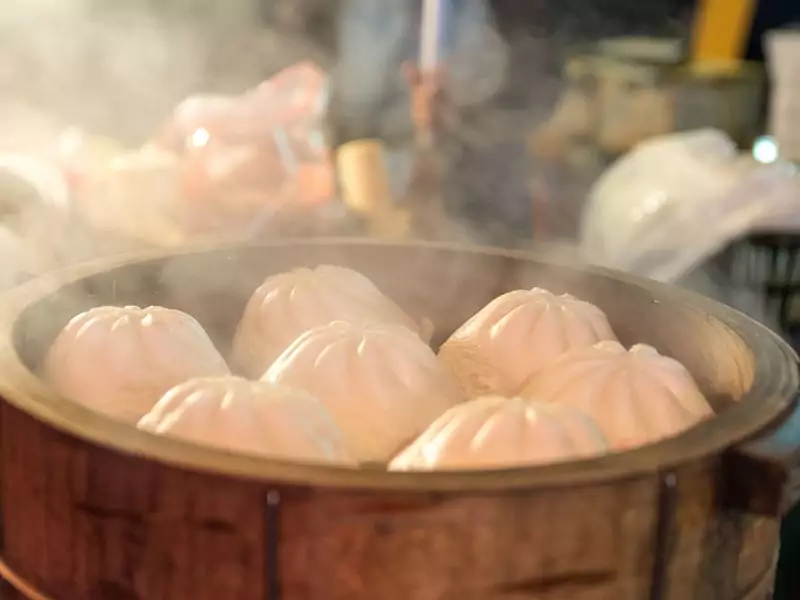
Nothing beats the soft, warm, and juicy Nikuman when the Japanese winter rolls around. Overall, this is a local rendition of the Chinese Baozi. With a mildly sweet, milky-tasting leavened wheat dough, it envelops a flavorful ground pork filling.
This filling also carries a mesmerizing taste, thanks to the combination of various vegetables, soy sauce, and a medley of condiments and spices. No wonder it’s a comforting street food staple during the chilly months.
To buy it, you can find Nikuman buns in Chinese-Japanese restaurants and Japanese grocery stores nationwide.
5. Okoshi
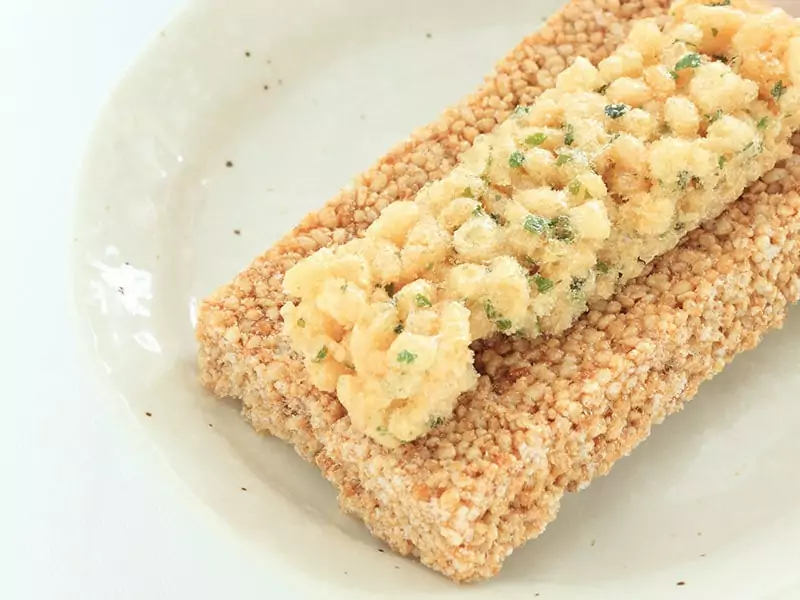
Stemming from Japan’s mid-Edo period, Okoshi represents a tasty tradition. Crafted by roasting rice grains until they pop, they are combined with sugar and butter or corn syrup to bind.
Pressed in trays and dried, these square-shaped snacks are a nod to Japan’s past. Street vendors near Asakusa’s Buddhist temples are a primary source for this treat, with model variants incorporating peanuts, matcha, caramel, chocolate, or sesame seeds.
6. Miso Ramen
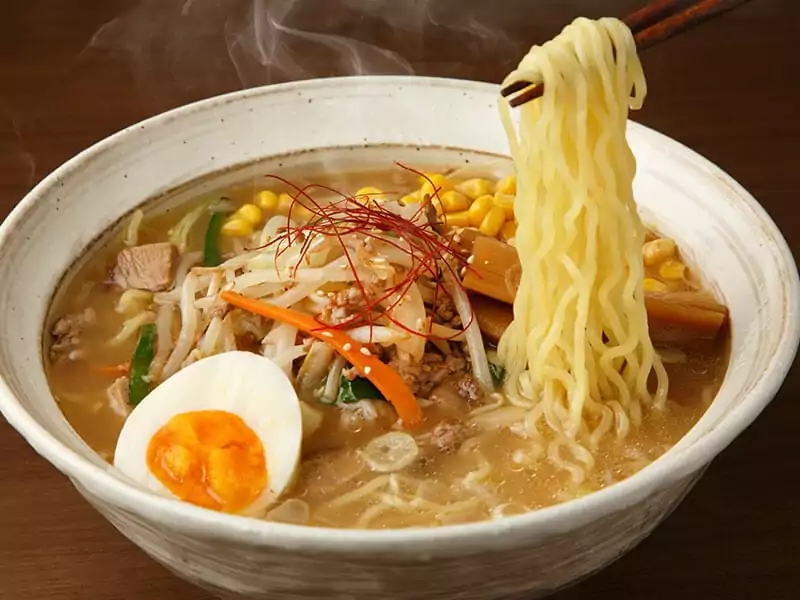
Invented in 1955 in Sapporo, Miso Ramen is a flavorful symphony where miso paste dances with broth and vegetables, producing a rich umami taste with a touch of nuttiness.
Bean sprouts, chopped pork, garlic, sweet corn, and seafood are usually added on top, increasing the complexity of flavor. Moreover, it also brings forth a heightened creaminess.
The ramen, always firm in texture, completes the harmony. I suggest you drop by the Ramen Alley in Sapporo, where dozens of shops honor this tradition.
7. Oyakodon (Chicken and Egg Rice Bowl)
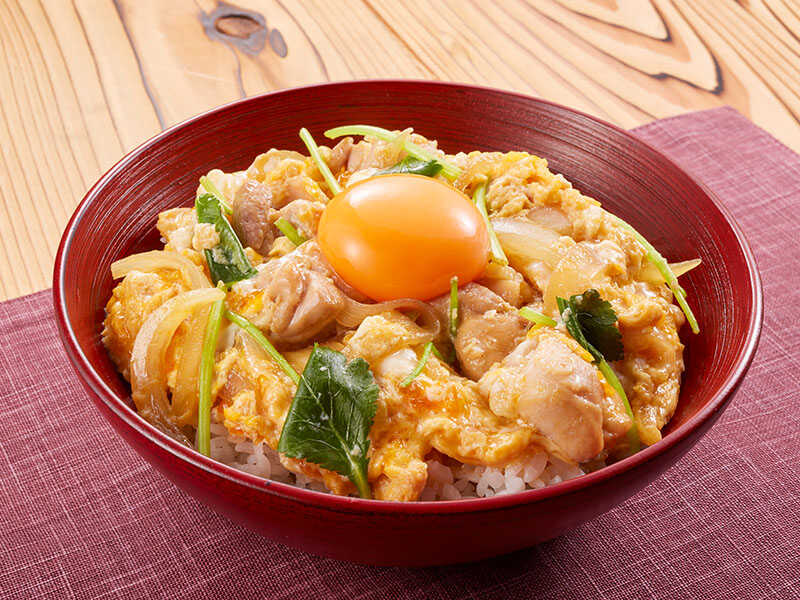
Named for its familial ingredients, Oyakodon is a Japanese dish where chicken and eggs (implying father and child) share a bowl.
This donburi, or rice bowl dish, combines chicken, eggs, and chopped scallions. The cooking process involves pouring raw eggs over rice, during the cooking process, before they solidify fully.
From street vendors to restaurants, it’s a lunchtime favorite. Its popularity also owes much to its easy and quick preparation, making it a reliable choice for a meal on the go.
8. Korokke (Potato Croquettes)
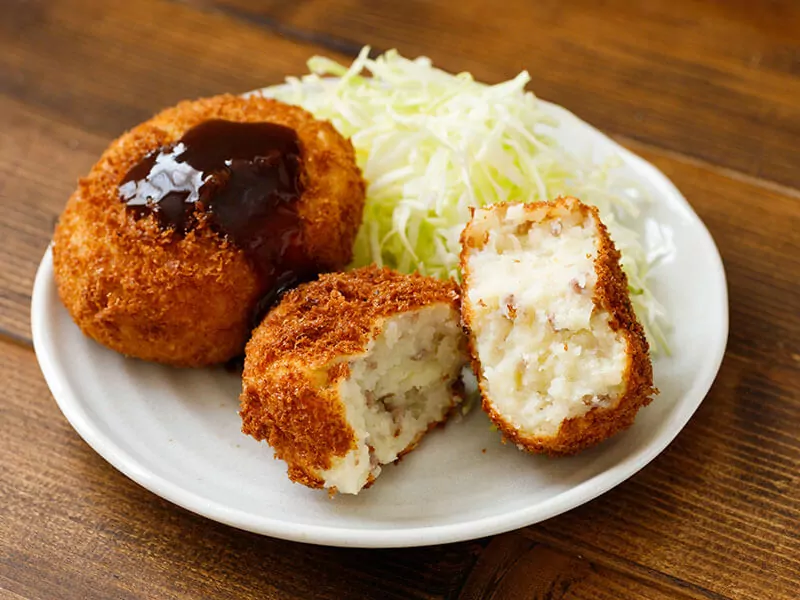
In 1887, Japan embraced the French croquette, transforming it into the beloved Korokke. This versatile dish combines mashed potatoes with various ingredients like meat, seafood, or vegetables, shaped into a patty, and then breaded and deep-fried.
The choice is vast, from potato to curry, cream to okara variants. Once fried, the outer layer turns incredibly crunchy, while the inside remains soft and flavorful. Despite its humble cost, the taste of Korokke is anything but modest.
9. Negima Yakitori (Chicken Skewers)
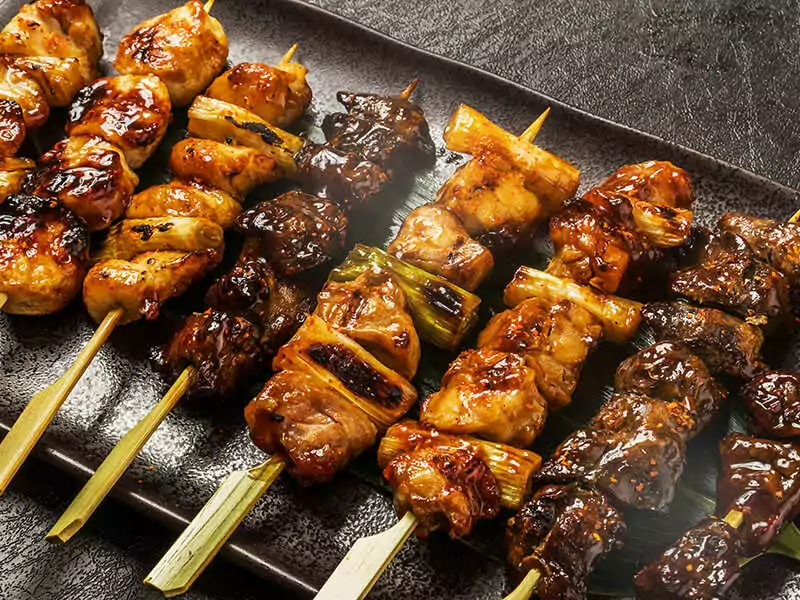
Negima Yakitori is a beloved type of Yakitori in Japan, bringing together sliced chicken thighs or breasts and pieces of green or Welsh onions on a skewer.
An alternating pattern of chicken and onions is a charming characteristic of this dish. It’s seasoned with salt or tare, a subtly sweet soy sauce.
Traditional preparation sees it grilled over charcoal on yakitori grills. Its popularity is evident as it’s a frequent sight in restaurants and izakaya bars.
10. Gyudon (Beef Rice Bowl)
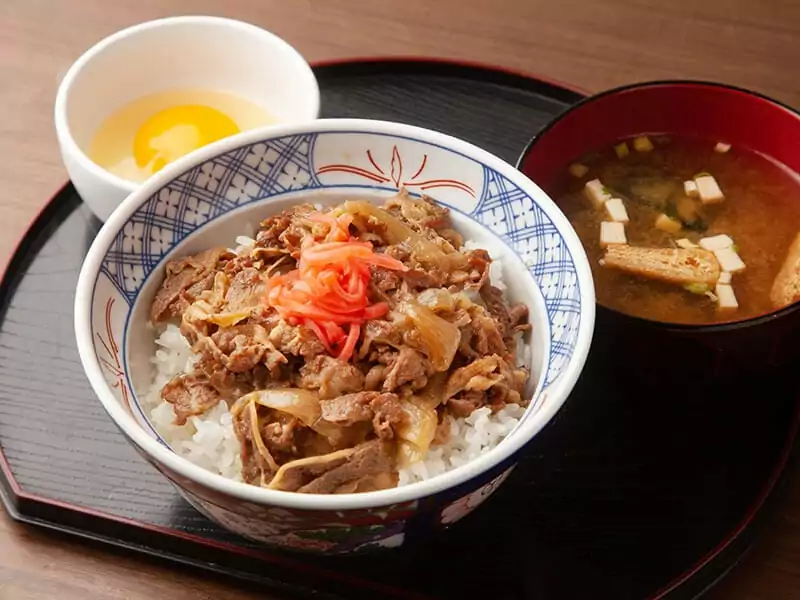
Gyudon, or gyūmeshi, translates to ‘beef bowl’, a deceptively simple name for a richly satisfying dish. The name is a combination of “Gyu” (牛), which means beef, with Don (丼) referring to a bowl of rice.
On top of a bowl of fluffy rice, you’ll find a succulent layer of beef and onions. This combo is marinated in dashi, soy sauce, and mirin, contributing a great blend of umami and salty tastes.
Garnishes like eggs, cheese, or red pickled ginger add depth to Gyudon. With its easy accessibility in Japanese restaurants, Gyudon seamlessly fits into any meal of the day.
11. Karaage (Deep-Fried Chicken)
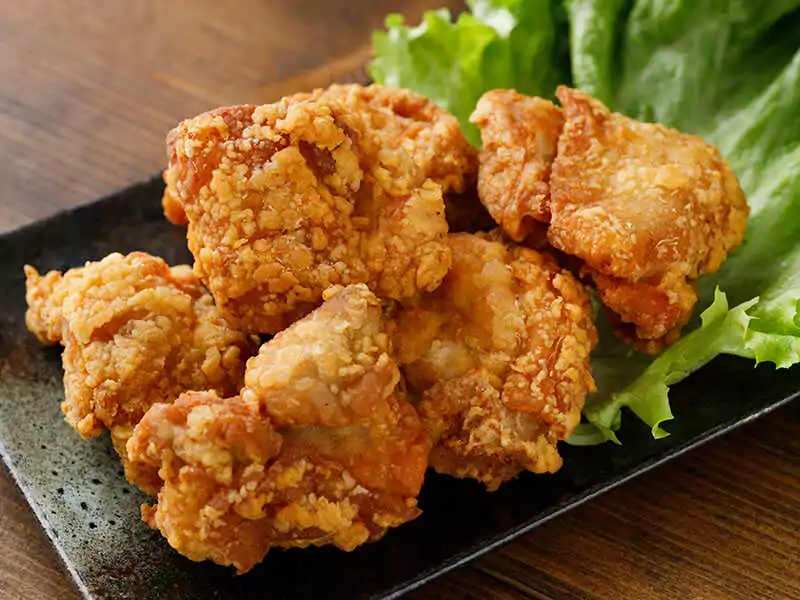
Karaage is the name of a special Asian cooking method from the Edo period in Japan, which is also known as dry-frying.
The chicken, a star of Karaage, is lightly coated in arrowroot starch and then deep-fried to yield a crispy outer surface. Wheat flour, tapioca, or potato starch are viable alternatives for the coating.
Marinating the chicken in sake, soy sauce, and sugar concoction is a recommended step. Finally, locals serve it alongside white Japanese rice and a soup like Miso, Kabocha squash soup, edamame potage, or egg drop for a hearty meal.
12. Yakisoba (Stir-Fried Noodles)
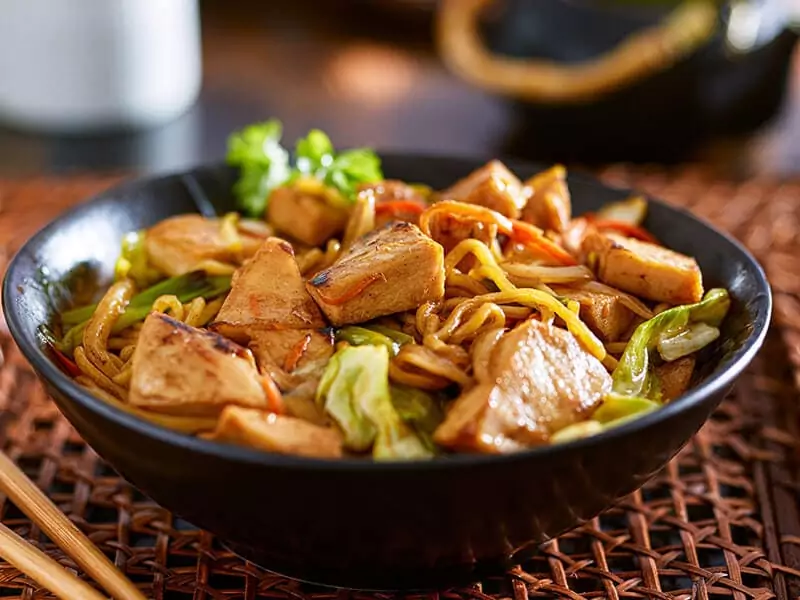
Yakisoba, originating from the 1930s Japanese food stalls, is different from your ordinary noodle dish. Though ‘soba’ in its name, the dish is a dance between ramen-style wheat noodles, bite-sized pork, and different finely chopped vegetables, such as cabbage, onions, bean sprouts, and carrots.
To make it, chefs will cook ingredients over high heat. And when they mingle, it creates a plateful of noodles with a rich, sweet, spicy kick. As a main course or side, Yakisoba always steals the show!
13. Sofuto Kurimu (Soft Serve Ice Cream)
Sofuto Kurimu, known to many as soft serve ice cream, is a Japanese delight made with fresh cream and milk, rendering an irresistibly silky texture.
It comes in an array of flavors that range from old-school chocolate and vanilla to unique ones that only Japan could bring, such as matcha, red bean, wasabi, and even squid ink.
14. Sushi
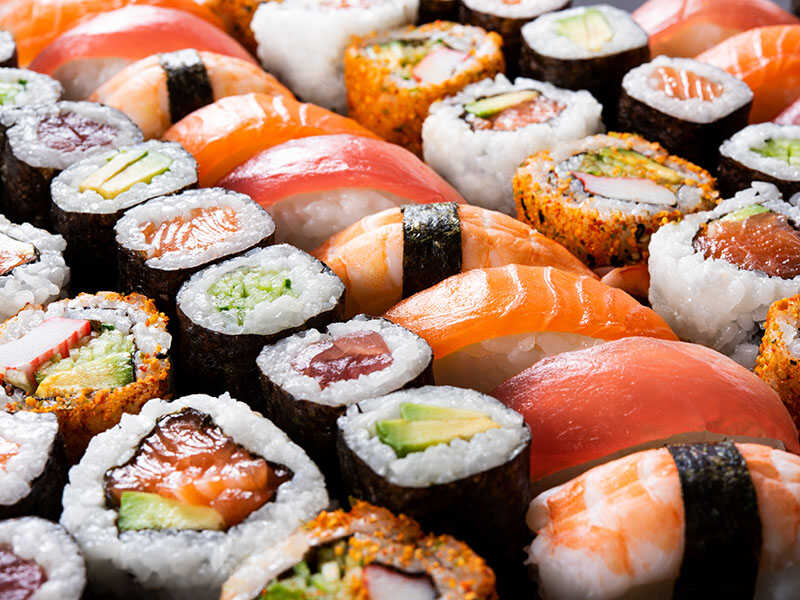
For anyone who appreciates sushi, it’s intriguing to trace its roots back to Hanaya Yohei, the creator of this beloved Japanese delicacy.
Also, the dish has various ways that chefs can present. With its vinegared medium-grain white rice complementing ingredients like fresh seafood and vibrant vegetables, sushi can be as diverse in style as in taste.
But don’t mistake it for sashimi! The appeal of sushi lies in its neutral yet tangy sweetness. Side by side with wasabi and pickled ginger, a sushi plate becomes a craving for millions of American folks.
15. Sashimi
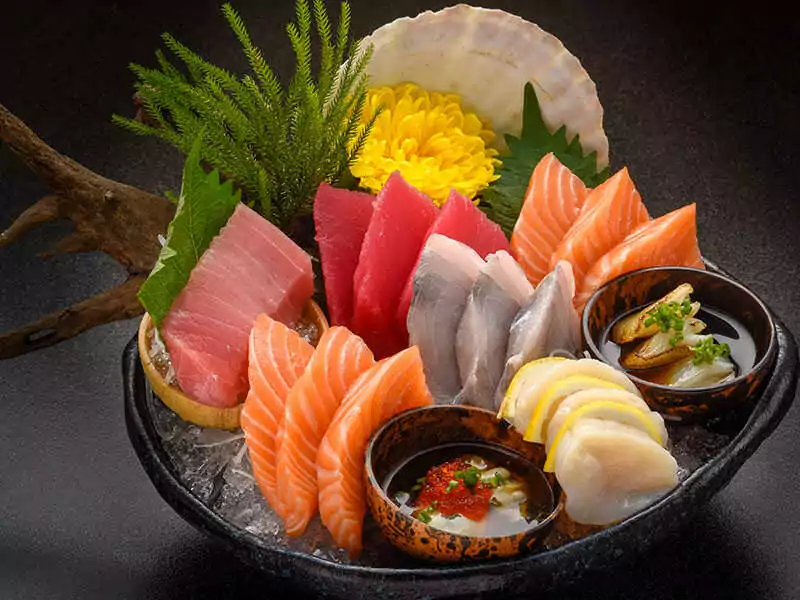
Sashimi is another iconic Japanese delicacy, comprising fresh raw fish or meat sliced thin. This dish, which means “pierced body”, can serve as a formal meal’s appetizer or as the main dish (often accompanied by rice and miso).
The most common ingredients in sashimi are tuna, sea bass, salmon, red mullet, or halibut sashimi, though squid or octopus versions are also enticing to me and others.
Wasabi pairs excellently with sashimi alongside soy sauce; with each bite, the freshness, and slight saltiness are unmistakable.
16. Tempura (Deep-Fried Food)
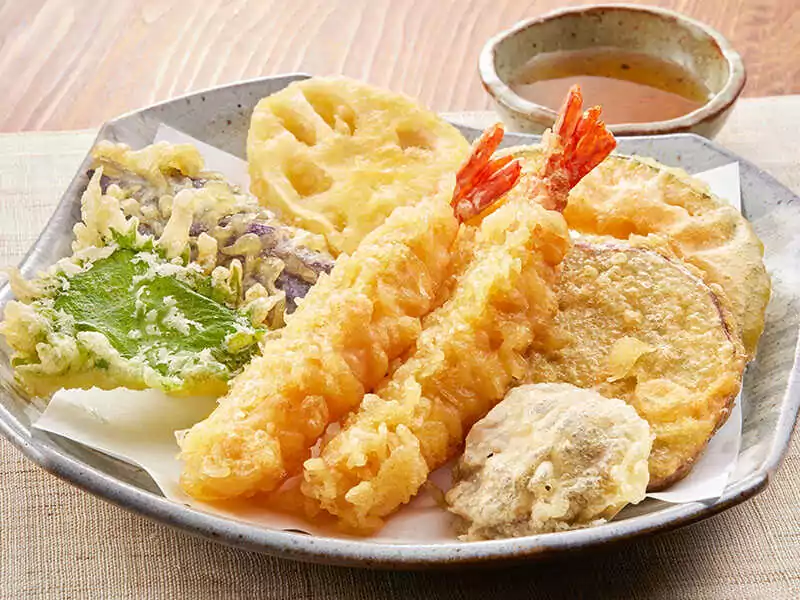
My first bite of crunchy Tempura features a beautiful fusion of flavors. Brought to Japan by the Portuguese, this classic dish is simple battered, deep-fried seafood, meat, and vegetables, with shrimps being the crowd favorite.
The batter, a delicate concoction of iced water, eggs, and soft wheat flour, gives Tempura its signature lightness and crunch. How to eat it as a filling meal? Serve Tempura over a bowl of rice or atop soba noodles and dipped in traditional Japanese soy sauce.
17. Onigiri (Rice Ball)
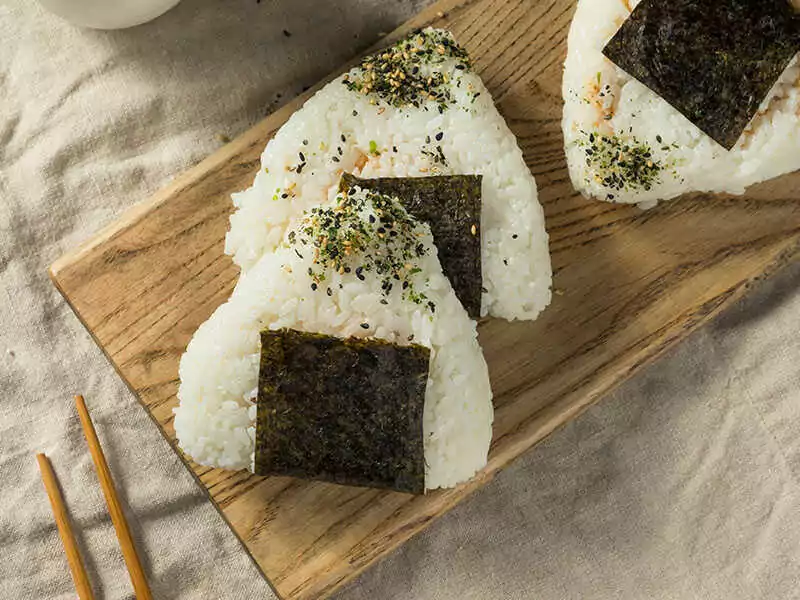
Onigiri, aka omusubi (お結び), nigirimeshi (握り飯), or rice ball, are charming bite-sized treats crafted from white rice. They normally come in triangle or cylinder shapes and are often embraced in a nori sheet.
The traditional fillings are pickled ume, salted salmon, katsuobushi, and more. Yet, I have a soft spot for the classic, creamy mix of salmon or tuna mayo.
Unlike sushi, Onigiri uses plain rice, not vinegared. They are easily customizable, so feel free to make them based on your preference.
18. Donburi (Rice Bowl)
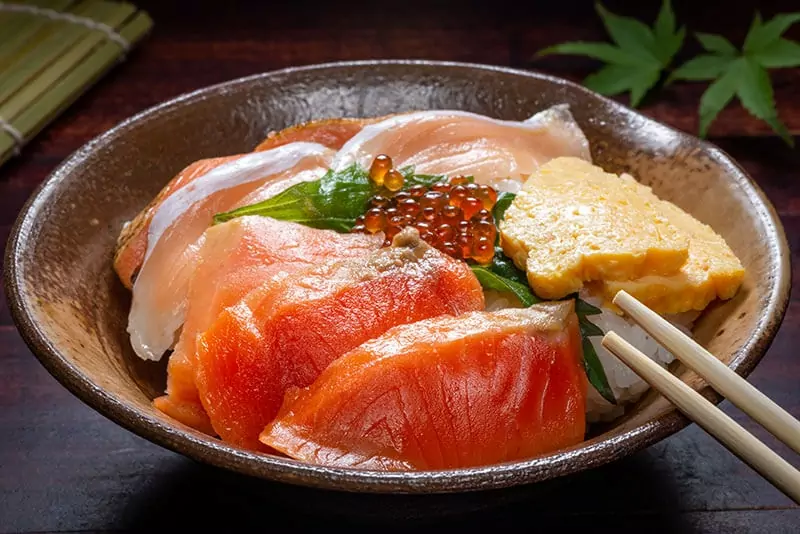
Donburi is another classic rice bowl in Japan, served in an oversized bowl with layers of simmered fish, meat, or veggies atop a mound of steaming rice.
Gyūdon, with its tender beef strips, is a variation of Donburi. Besides it, others feature a mix of vegetables or seafood, so you will always find one to fit your craving.
In India
19. Chaat
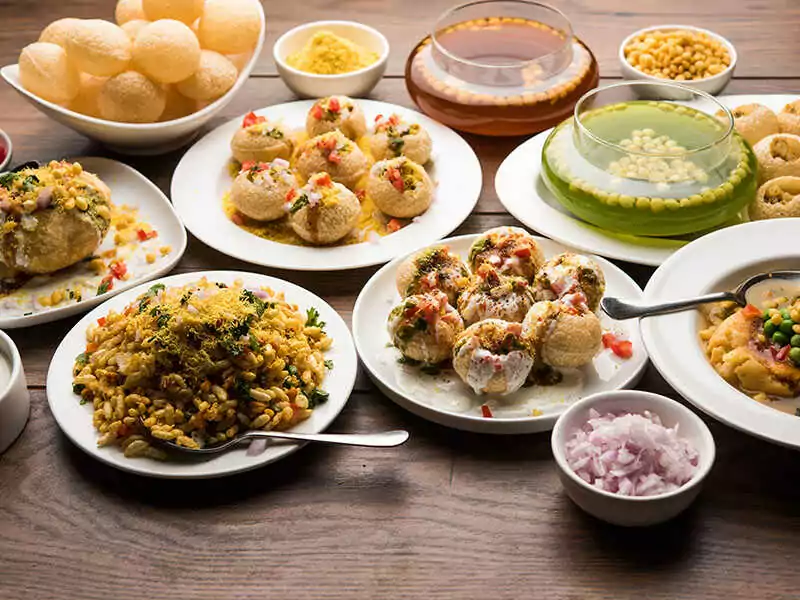
Chaat is an umbrella term for savory snacks sold in South Asia, particularly in India, Pakistan, Nepal, and Bangladesh. On my travels, I’ve seen these goodies sold at roadside stands and food carts, each inviting the passerby with the irresistible look of fried dough.
The authentic Chaat recipe calls for a blend of potato chunks, crunchy fried bread, Dahi Vada (a kind of dumpling), gram or chickpeas, and tangy-salty spices, all crowned by a splash of fiery Indian chili.
The flavors burst with spiciness, tanginess, or saltiness. Plus, some Chaat even indulges your sweet tooth as well. With its diverse fillings, every bite is like unwrapping a surprise gift.
20. Vada Pav (Mumbai Sandwich)
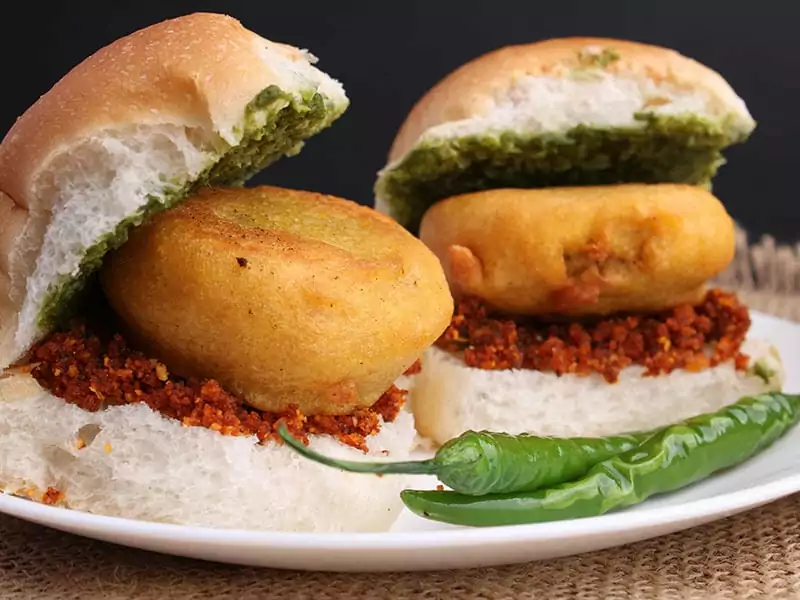
Vada Pav, the soulful Mumbai sandwich, is a story of flavors packed between two soft white bread rolls (aka Pav).
It was a roadside spectacle by Ashok Vaidya near Dadar train station in the 60s and 70s. Today, as a famous veggie fast food across the country, especially in South Mumbai.
The vada element refers to a savory mixture of mashed potatoes infused with spices and then coated in a chickpea batter. This concoction is then deep-fried to a perfect golden brown, creating a crisp exterior enclosing the warm.
For the best taste, it’s served with attractive coriander chutney, tangy tamarind sauce, or sprinkled with fiery dry garlic chutney.
21. Chana Masala (Chickpea Curry)
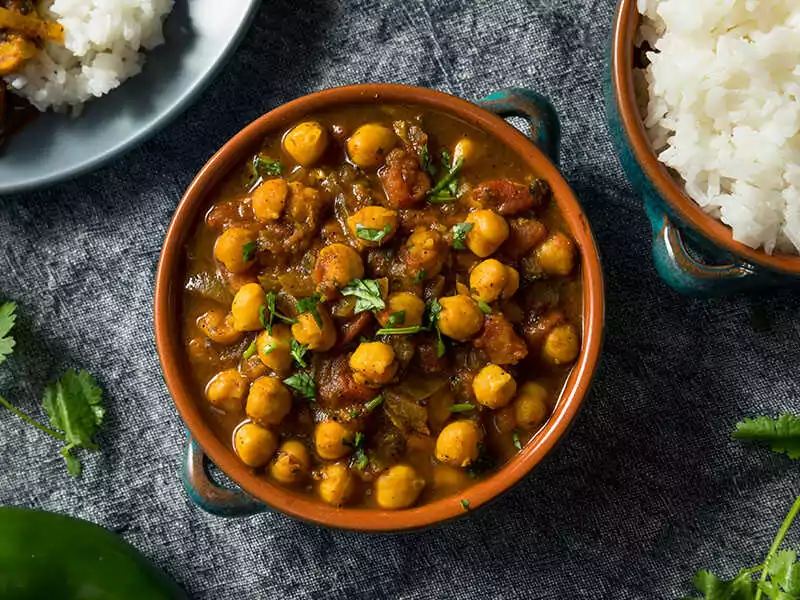
Chana Masala is a specialty from the North of India. It is also one of the most popular vegetarian dishes throughout the country.
It’s a tangy and earthy chickpea curry, often featuring sweet and sour hints due to adding tomatoes. This versatile dish can be a snack, main meal, or breakfast. It’s so well-loved, you can find it everywhere, from streets, beaches to school canteens, and railway stations.
The Pakistani version, Aloo Chole, is equally tempting. Pair it with rice or Indian flatbreads like roti or naan, then top it off with some yogurt or sour cream.
22. Samosa
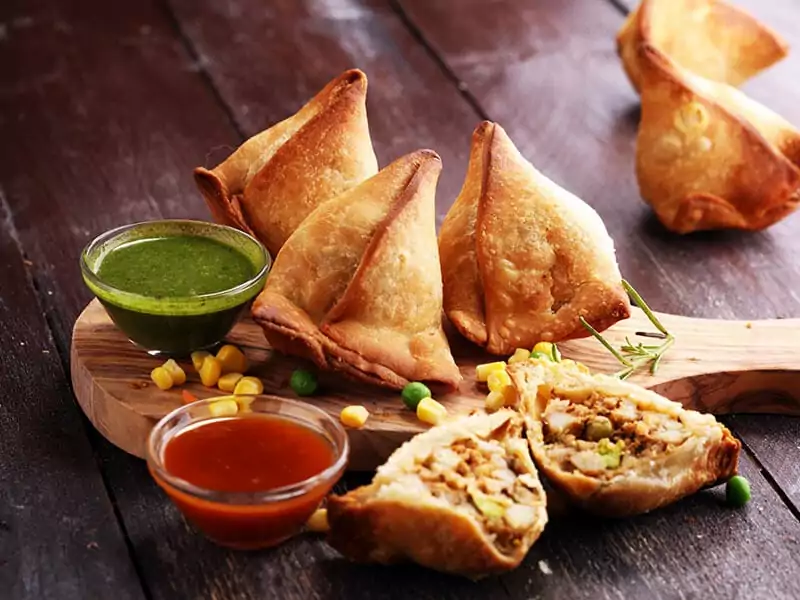
Samosas are iconic deep-fried Indian pastries. It was brought to India along the old Central Asian trade routes.
Golden-brown and crispy, their triangle, cone, or half-moon shapes hide a filling of spiced potatoes, lentils, peas, or ground meat. They are great for serving with yogurt or homemade Indian chutneys. Moreover, there are sweet versions, too!
23. Dosa (Thin Pancake)
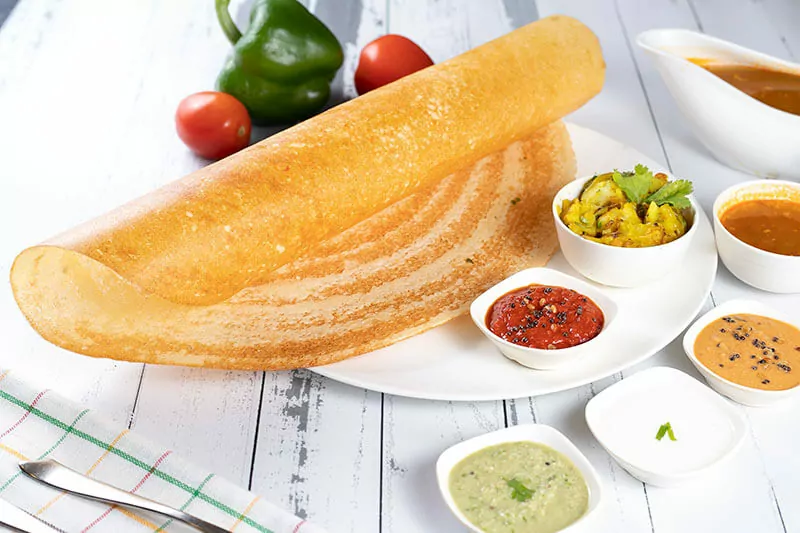
Dosa is a thin pancake that has won over taste buds across South Asia and often appears at street food carts or stalls across India. This is a great creation from the town of Udupi in Karnataka, South India.
It’s made from a well-fermented batter of ground black lentils and rice, resulting in a crispy delicacy yet wonderfully soft. The perfect Dosa batter should not be too thin or thick. It is normally folded or rolled, then cut before serving.
Furthermore, a Dosa can come with fillings like vegetables or cheese. And they are best consumed hot, right straight from the griddle. For more flavors, it is ideal for eating it with chutney and sambar, a vegetable stew.
24. Paratha (Wheat-Based Flatbread)
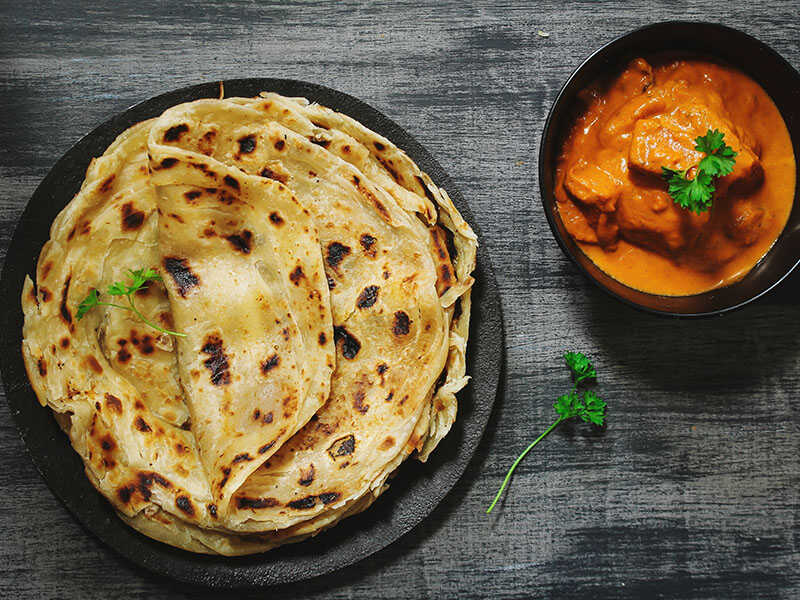
Paratha, a wheat-based flatbread, is a staple in many South Asian households. The name originates from “parat” and “atta,” hinting at its unique, layered texture achieved through ghee-baked dough.
You will see it in various shapes, from round to triangular, square, and even heptagonal. The stuffing mixes exciting flavors with options like boiled potatoes, cauliflower, garlic, ginger, chili, paneer, or radish.
To enjoy this flatbread, it is best to pair it with pickles, yogurt, homemade chutneys, or rich curries. For more information, In Punjab, locals traditionally enjoy it with lassi, a yogurt-based drink.
For homemade ones, the cooking flame is a key characteristic. It changes the texture, such as low for a chewier bite and high for a firmer one.
25. Tandoori Chicken Tikka
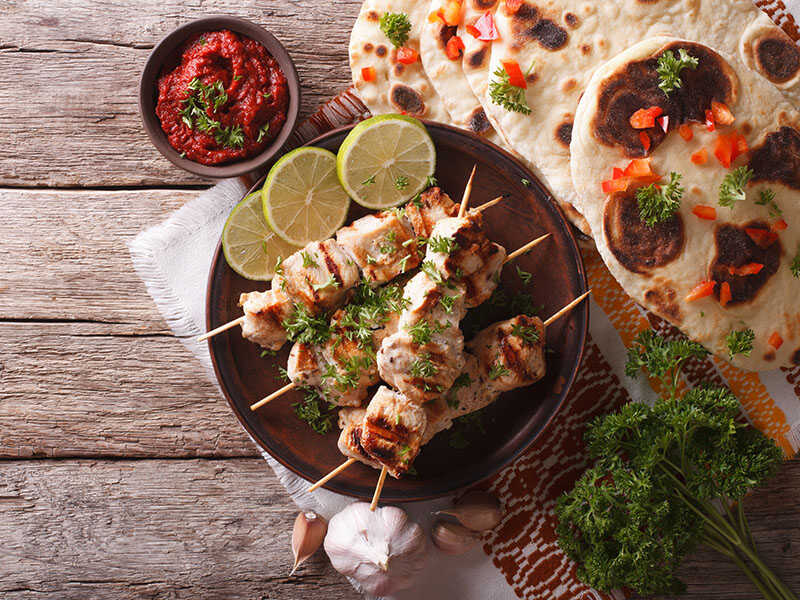
Tandoori chicken Tikka is a delight from the Indian subcontinent. It’s created from boneless chunks of chicken breast, marinated in a spicy blend of chili and garlic, then grilled over an open fire.
These pieces are usually skewered on bamboo sticks. And they are different from your traditional Tandoori chicken, which usually involves cooking half or a whole chicken.
The result is a slightly spicy, earthy dish with a vibrant golden-brown color. To finish, it’s sprinkled with chaat masala and wrapped in flatbread.
26. Jalebi (Funnel Cake)
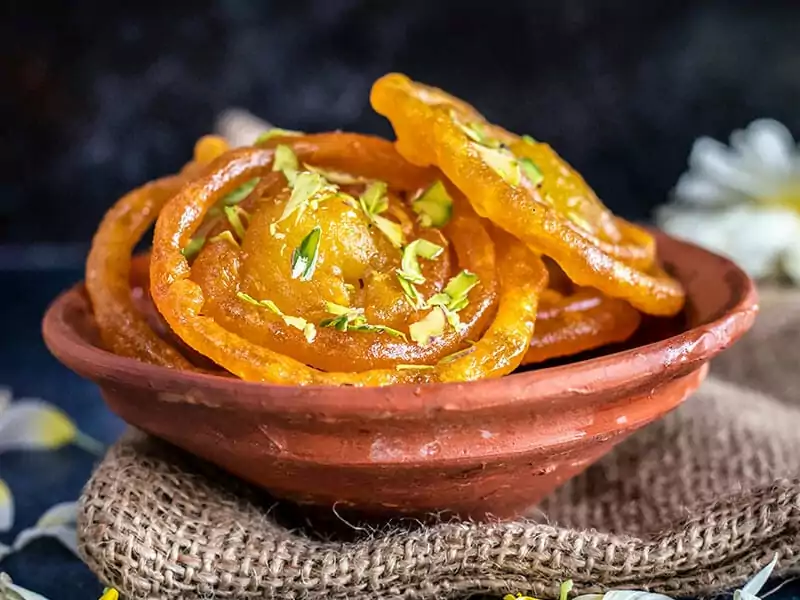
Jalebi is the national sweet dish of India. For decades, this dessert has captivated children and adults, including me, with its sugary allure.
This Indian funnel cake is easy to recognize by its spiral shape. The batter of Jalebi swirls together cornstarch, yogurt, baking soda, and a hint of turmeric. Owning a crispy, chewy texture, it is also made with sticky and gooey syrup.
For making the syrup, Indians use pure sugar sweetness, simmered to perfection at a precise 220°F to 222°F. With the warmth of a freshly-made Jalebi, its sweetness pairs beautifully with a glass of warm milk to kickstart the day.
27. Appam (Rice & Coconut Hoppers)
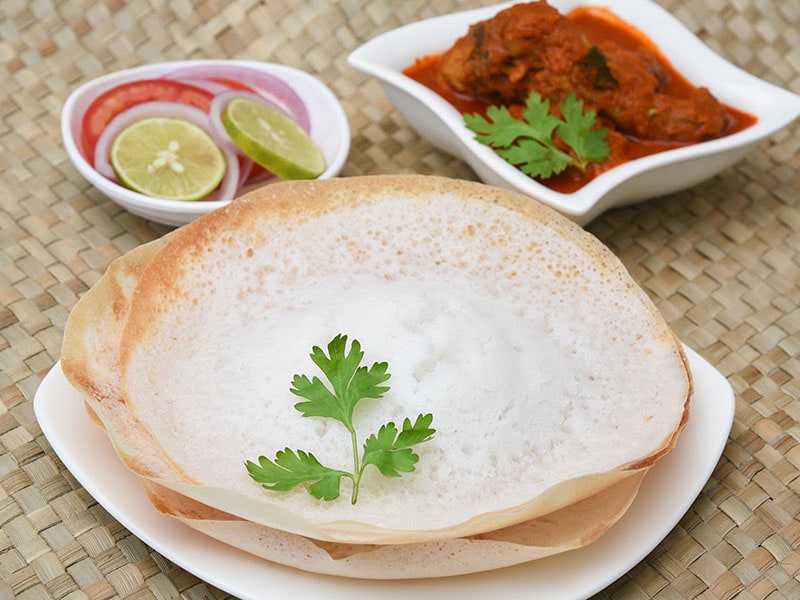
Appam refers to a thin pancake hailing from South India and Sri Lanka, which is also a part of the culinary traditions of Kerala and Tamil.
The recipe calls for a blend of fermented rice batter and coconut milk. This mixture is cooked in a deep pan (aka appachatti), resulting in a bowl-shaped pancake.
Whether it’s breakfast, snack, or dinner, Appam goes well with spicy condiments like coconut milk curry, or can be filled with a range of ingredients, from steamed eggs to vegetables.
28. Pani Puri (Filled Small Puris)
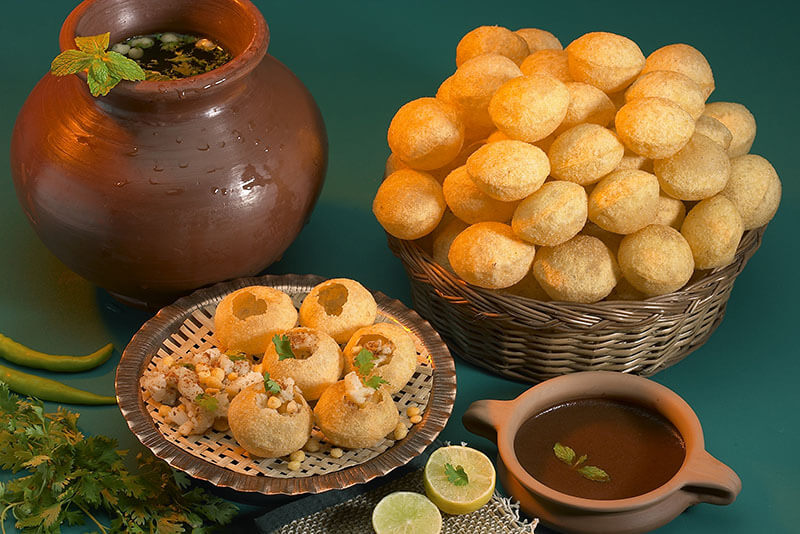
Pani Puri is a snack from the Indian subcontinent. This delicacy is a hollow, deep-fried bread, known by different names and ingredients across the regions.
It cradles a flavorful mix: tamarind chutney, chili powder, chaat masala, potato mash, onion, or chickpeas.
To savor it, dip the stuffed puri in pani or ladle some flavored water inside. The crispness of the Puri and the blend of mashed potatoes, sweet and mint chutneys, chopped coriander, and tangy jaljeera water bring a pack of textures and flavors to your palate.
In Vietnam
29. Phở (Beef Noodle Soup)
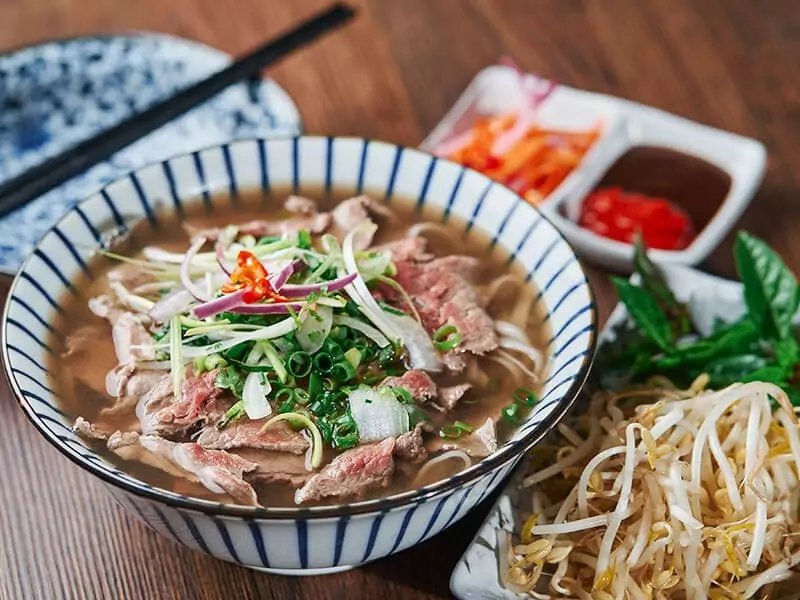
Speaking of the national dish of Vietnam, Pho – beef noodle soup is the top option. It has a rich history dating back to the early 20th century in North Vietnam. It has been popularized globally by refugees post the Vietnam War. It’s also one of two Vietnamese dishes listed in the Oxford Dictionary.
This comforting noodle soup is easy to find everywhere, from street stalls to high-end restaurants in Vietnam. Pho combines savory broth (seasoned with star anise, ginger, etc.), rice noodles, meat (usually beef or chicken), and herbs.
Regular toppings include bean sprouts, lime, chili slices, and condiments like chili and hoisin sauce. Pho styles vary regionally, particularly between Hanoi in the north and Saigon in the south, especially in a broth (Saigon-style Pho is sweeter) with more condiments and herbs.
In Vietnam, locals enjoy Pho as any meal of the day, from breakfast to dinner.
30. Gỏi Cuốn (Fresh Spring Rolls / Summer Rolls)
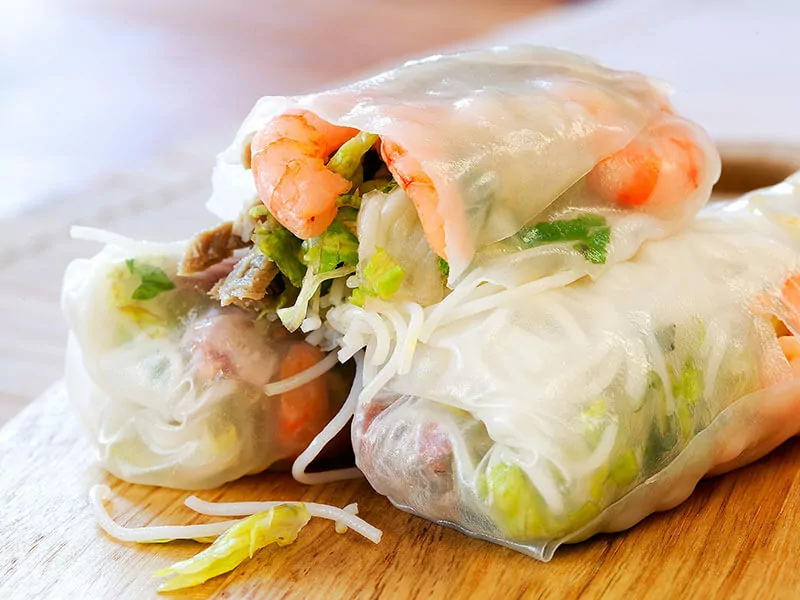
Famed for incredible flavors and textures, Vietnamese fresh spring rolls, or Gỏi Cuốn, is a street food delicacy that has won hearts in Thailand and Laos as well.
It includes cooked pork and prawn, raw vegetables, and rice vermicelli within its translucent rice paper wrapper. Usually enjoyed as a snack, spring rolls are served fresh at room temperature.
These rolls find their perfect companion in a peanut-based dipping sauce, sweetened with brown sugar, soured with rice vinegar, and given a kick with chili sauce.
Alternatively, fish sauce or hoisin sauce can do the trick. There’s also a deep-fried version, known as Chả Giò in the south or Nem Rán in the north, but with different ingredients.
31. Xôi (Sticky Rice)
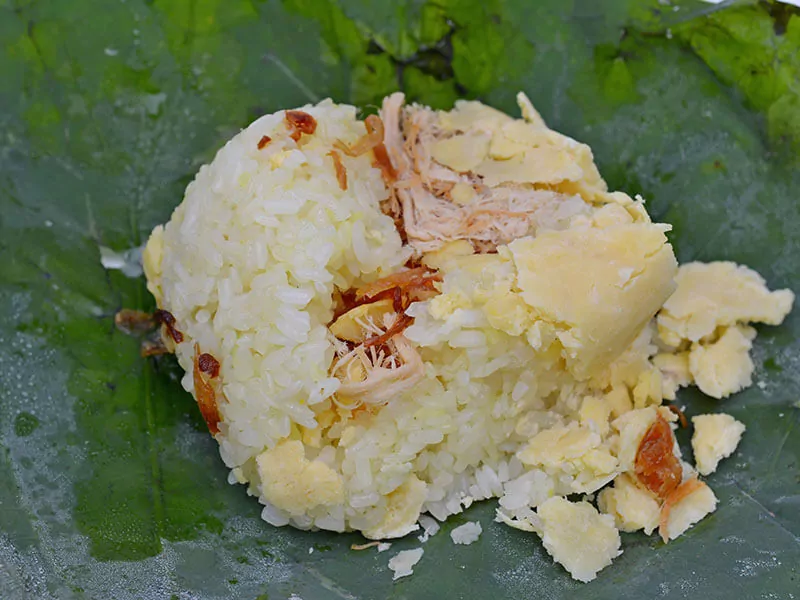
Sticky rice (aka xôi in Vietnamese) is a big term for several dishes made with this ingredient. First, locals soak, steam, and flavor the glutinous rice with other ingredients. The first time I tried Xôi wrapped in a banana leaf – the texture was divine.
Savory versions of Xôi had me captivated, like Xôi Xéo with mung bean paste and fried shallots, and Xôi Gà, which comes with chicken. The flavor profile is a joy to explore, from adding ham, Chinese sausage, and dried shrimp to the punch of garlic, soy sauce, and chili flakes.
Also, the sweet versions are a whole other realm! Xôi Vò, a delight with coconut and sesame, is a favorite. There are more variations to explore, such as Xôi Gấc, Xôi Đậu Phộng, and Xôi Đậu Xanh.
If you have been to Vietnam, I bet you have already enjoyed some authentic Xôi at all times of the day, whether it was breakfast, lunch, or as a snack. Interestingly, in the mountainous areas of northern Vietnam, Xôi is a main dish.
32. Bánh Xèo (Crispy Pancake)
Bánh Xèo, or sizzling pancakes, is named for the sound of the batter hitting a hot skillet. These crunchy delights have a golden hue thanks to a mix of rice flour, water, turmeric, and coconut milk.
Inside, you’ll find sautéed scallions, bean sprouts, shrimp, and boiled pork or beef. It’s pan-fried gently, then folded to keep everything tucked in.
You can dip it in fish sauce for a tangy kick, and it’s eaten with fresh lettuce, herbs, and pickled vegetables. It’s a must to eat it hot for that extra crispiness. To find it in Vietnam, let’s check these beauties at local street vendors and markets.
33. Bánh Mì (Vietnamese Baguette)
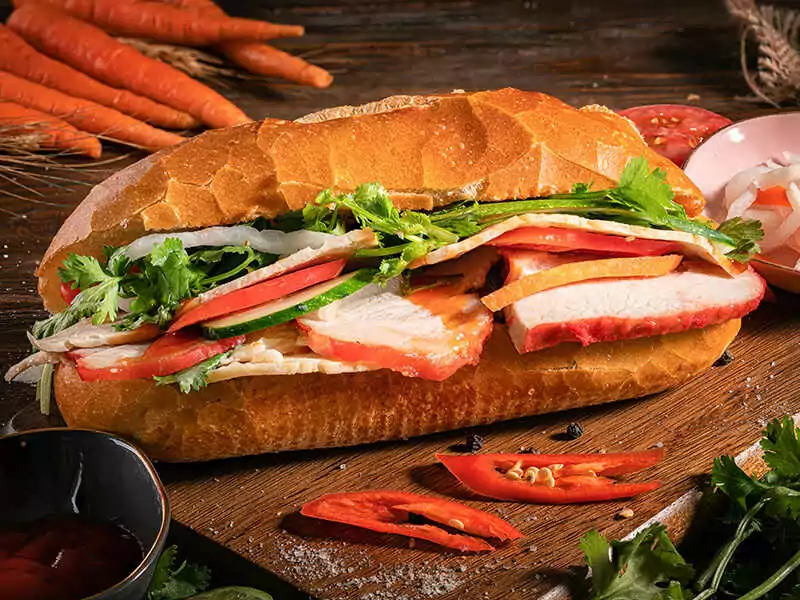
The Vietnamese baguette, also known as Bánh mì, is a very famous sandwich in Vietnam and the world.
It is a fascinating fusion of cultures, a product of French and Chinese colonial influence. The baguette itself was brought over to Vietnam during the colonial period.
Overall, Bánh mì is a warm, crunchy baguette filled with tender, savory pork, balanced with a medley of pickled vegetables, coriander, and a touch of chili and pâté.
Its layers of flavor have a beautiful harmony: the spicy jalapeños, the tangy pickles, the refreshing cucumber, and the lush cilantro. They also contain butter, mayonnaise, or soy sauce to add flavor.
34. Iced Coffee (Cà Phê)

Cà Phê, the Vietnamese iced coffee, is an authentic delight you can savor from street-side vendors, food stalls, and quaint cafes.
Its charm lies in the slow drip of coffee through a small metal filter, known as a Phin, into a layer of sweetened condensed milk waiting patiently at the bottom of the glass. Poured over ice, this rich brew becomes a refreshing pick-me-up.
A dash of coconut milk in Cà Phê Sữa Dừa offers a delightful twist. Try it alongside a Bánh Mì or Bánh Bao, ideally at a tiny plastic table and chair on the pavement, to fully capture the prosperous spirit of Saigon.
In China
35. Jianbing (Crepes)
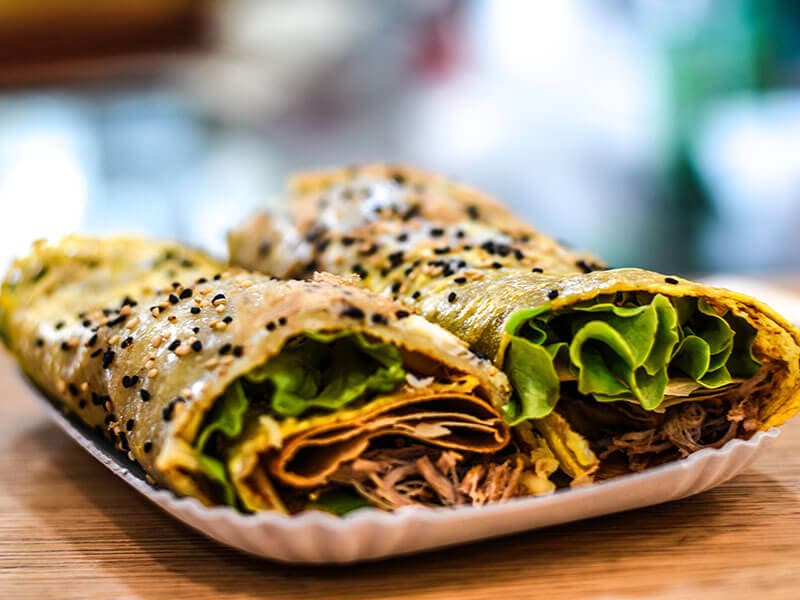
My mornings in China usually started with the comforting scent of Jianbing. This thin, crepe-like pancake, warmed by a hot cast-iron slab, is a breakfast staple among the bustling street food scene.
The batter, a blend of mung bean, black bean, and wheat flour, is spread skillfully with a wooden paddle by vendors who work their magic in the early morning. Adding a layer of eggs onto the pancake brings a burst of flavor and a pleasant textural contrast.
Hoisin, a savory bean paste, or Tian Mian Jiang sauce are great options for the accompanying sauces. The finishing touch is the fillings with a personalized selection of spring onions, mustard pickles, radishes, scallions, cilantro, and the crispy crunch of Bao Cui.
For a protein boost, you might opt for Chinese sausage or chicken.
36. Baozi / Bao (Steamed Buns)
Baozi, also known as Bao, are yeast-leavened filled buns that are an integral part of Chinese cuisine, especially in the north. Their popularity extends beyond China, having been adopted in many Asian countries. They frequently appear at breakfast tables and sometimes as a main meal.
The dough, a blend of flour, yeast, sugar, baking powder, and oil, creates a fluffy, bread-like texture that distinguishes them from dumplings. These buns are versatile, housing a multitude of fillings – be they savory or sweet.
Meat fillings are quite popular, with Cantonese-style Bao cradling char siu pork and Shanghai-style Xiao Long Bao brimming with mincemeat. Vegetable options are plentiful, too.
Sweet fillings like red bean paste, custard, and sugary black sesame seed offer an alternative for those with a sweet tooth.
These buns are typically cooked in a large or small bamboo steamer, a traditional Asian cooking tool. But some versions are pan-fried buns.
Baozi are readily available from street vendors and small takeaway shops, and are served in bamboo steamer baskets.
37. Shaobing (Sesame Flat Bread)
Shaobing, a layered flatbread from Shandong province, has become a cherished snack in northern China. This unleavened bread consists of flour, salt, sugar, vegetable oil, and yeast.
With its many dough layers, each brushed with sesame paste, I find it’s akin to a flattened, savory pastry. They also have fillings made from various components.
If you opt for a savory filling, you can enjoy stir-fried mung beans with egg and tofu. For something sweet, go with the red bean paste.
Breakfast times are special with a filled Shaobing and a cup of tea, while the unfilled variety complements steamed eggs or a meat dish. In Mandarin meals, this flatbread is a good friend in winter to enjoy with hot pot or soy milk.
38. Jiaozi (Chinese Dumplings)
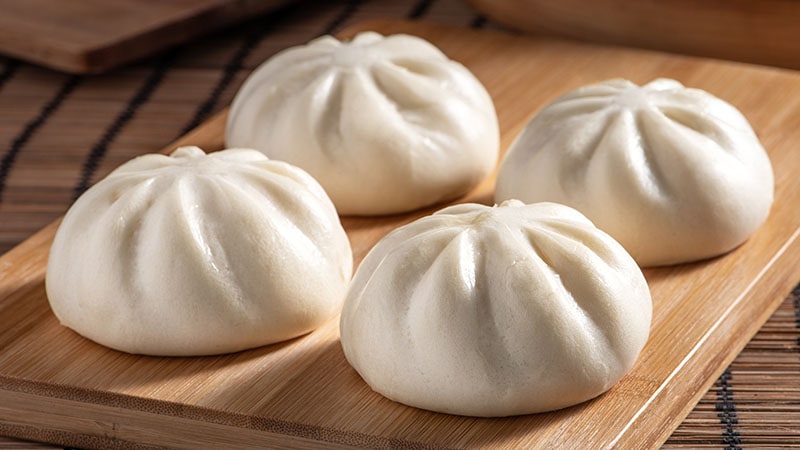
Jiaozi is another type of Chinese dumpling. It is made from a dough containing salt, flour, and water. Typically, the skin of Jiaozi is thinner than Baozi. Fillings range from minced pork, ginger, scallions, and Chinese cabbage, to prawns, chives, and mushrooms.
The traditional cooking methods of these are steaming, boiling, and pan-frying. Sometimes they are served in soup, accompanied by a tangy dipping sauce.
Finally, Jiaozi is believed to bring good luck. That’s why the Chinese love to consume them during Chinese New Year festivities.
39. Rou Jia Mo (Chinese Hamburger)
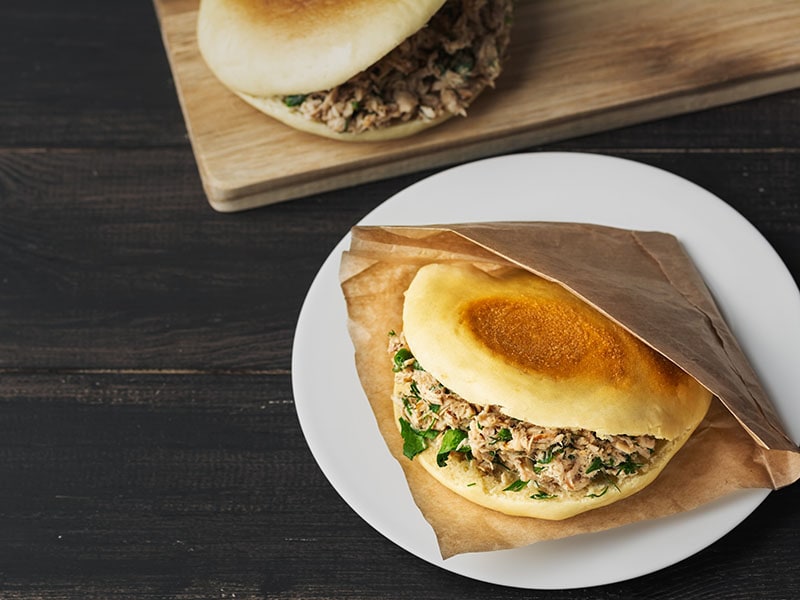
Rou Jia Mo (Chinese hamburger) hails from Shaanxi Province but has won hearts across northwest and northern China. Regarding its history, its bread-making style dates to the Qin Dynasty and the braised pork to the Zhou Dynasty.
For making Rou Jia Mo, the pork belly or mutton filling is braised in a broth rich with over 20 spices and seasonings (onions, ginger, soy sauce, rock sugar, herbs, cardamom, Sichuan peppercorns, cloves, and more), then shredded.
Instead of ketchup, pork gravy and chili sauce/paste give it a pleasant taste. If you have yet to learn what to have for a perfect afternoon snack while in China, try it with tea! On the other hand, Rou Jia Mo is also a hearty dinner.
40. Xiao Long Bao (Soup Dumplings)
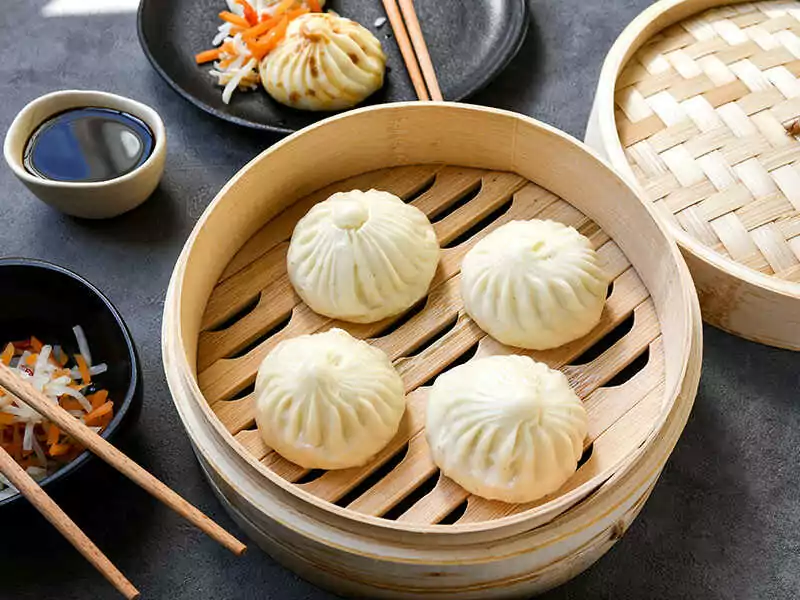
Xiao Long Bao, named after the “xiao long” bamboo steaming baskets they’re cooked in, is a well-loved Shanghainese specialty. Inside the bun is a rich broth mingled with ground pork or other fillings.
Steaming the buns melts the meat aspic within, producing the signature broth. Moreover, Xiao Long Bao has earned its status as a protected national treasure in Shanghai since 2006.
Today, it is available everywhere, from street stalls to high-end restaurants in China, especially in Shanghai.
Quick fact: Xiao Long Bao means “little basket buns.”
41. Chou Doufu (Stinky Tofu)
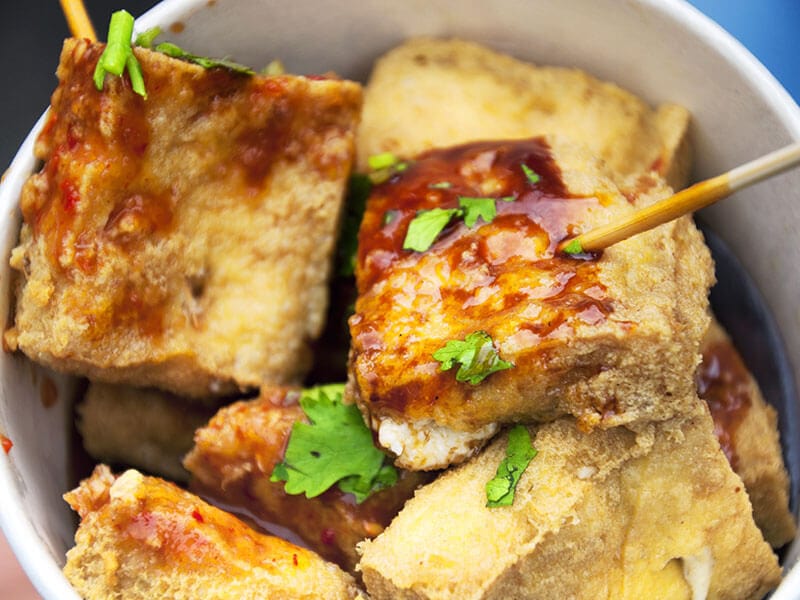
Chou Doufu, or stinky tofu, is a fascinating dish not everyone dares to try. It has a not-too-pleasant aroma shaped by a fermentation process involving soaking bean curd in a distinctive brine for hours to months.
The brine is a blend of fermented milk, vegetables, meat, dried shrimp, amaranth greens, and Chinese herbs. The cooking methods vary – stewing, braising, steaming, grilling, or deep-frying the tofu. For serving, they normally come with a topping of spicy sauces and pickled cabbage.
In China, stinky tofu is easy to buy at bustling night markets. This snack also goes to lunch bars, especially in Changsha and Hanan. There are other variations, such as Zhejiang-style smelly tofu or Hunan-style stinky tofu.
Fun fact: Stinkier means tastier tofu!
42. Guotie (Pan-Fried Dumplings)
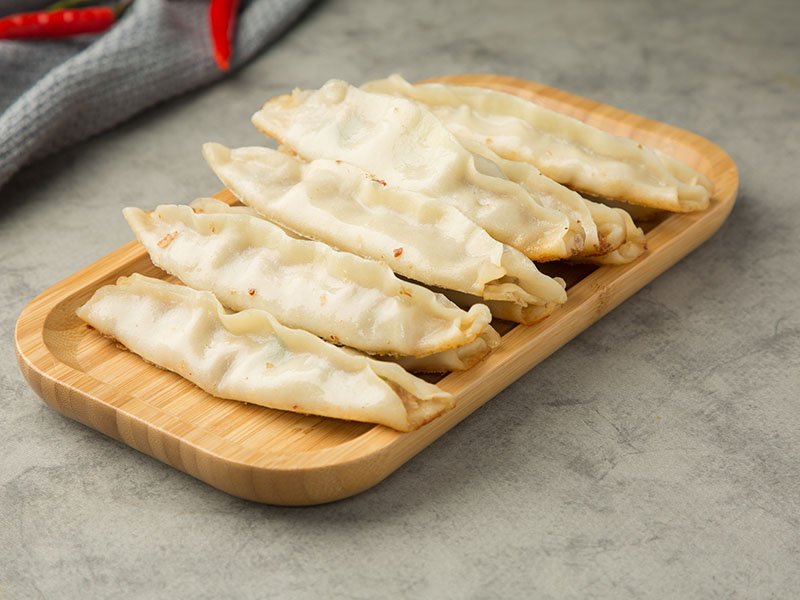
As a culinary tribute to Northern China, Guotie is a pan-fried variety of Jiaozi. The ingredients in Guotie include minced pork, cabbage, scallions, ginger, rice wine, and sesame seed oil.
Guotie is unique in its cooking method, which involves pan-frying and steaming to create a delightful contrast of textures – crispy at the bottom and soft on top.
Typically, it is savored with a tangy dipping sauce. In North America, it is known under another name, potstickers.
43. Tanghulu / Bing Tanghulu (Candied Haws)
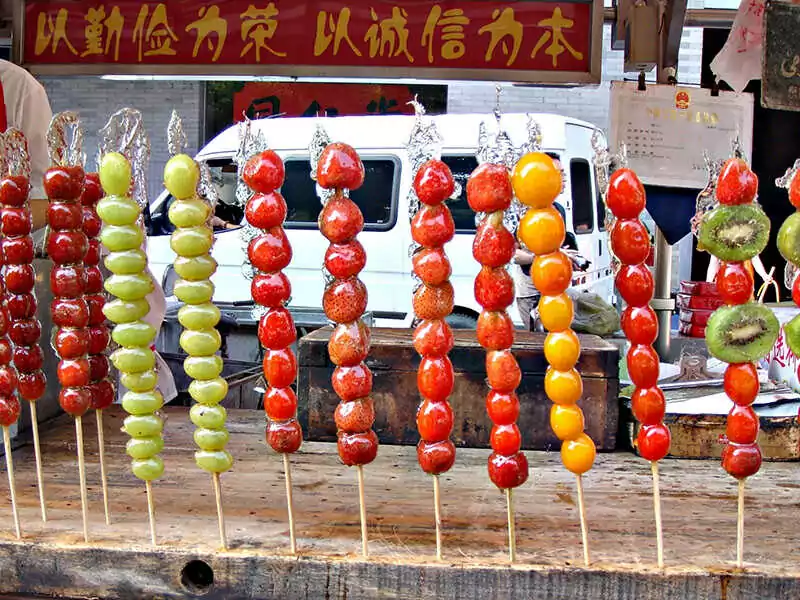
One of my personal favorites from northern China is Tanghulu or Bing Tanghulu. This sweet is a perfect winter snack dating back to the Song Dynasty.
This candied haw treat is simply hard to resist, especially for kids in China. Adorning bamboo sticks, fruits like Chinese hawthorn berries, strawberries, apples, and grapes transform into a sweet and sour delight covered in a crispy rock sugar shell.
From bustling central Beijing streets to the annual Tanghulu Fair in Qingdao, its presence is cherished by many. If you find Tanghulu made with hawthorn fruit, this fruit has potential health benefits, such as aiding digestion, reducing blood pressure, and boosting immunity (1).
44. Tea Egg
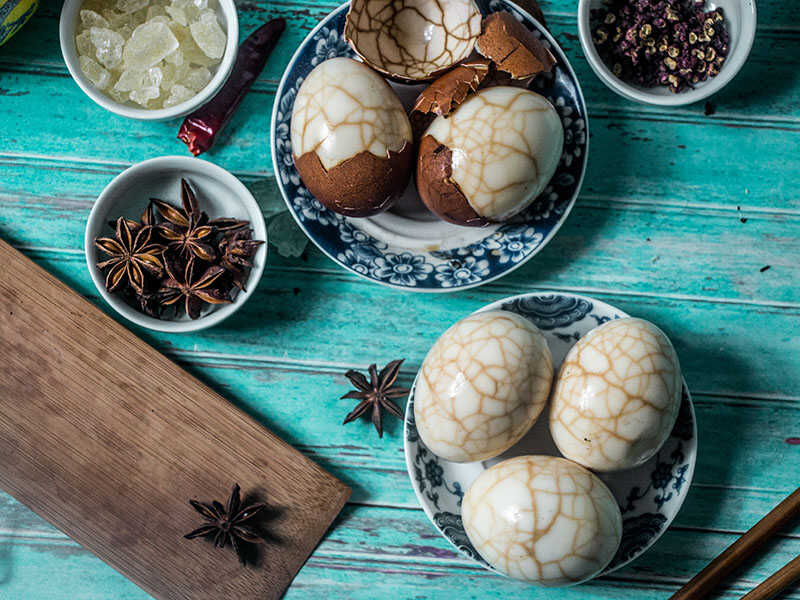
Tea eggs (or tea leaf eggs, marble eggs) are a beloved snack hailing from places such as Taiwan, Hong Kong, and regions of Sichuan and Guangdong.
Their creation involves an intriguing process: hard-boiling eggs, lightly cracking their shells, and then letting them steep in a fusion of tea, soy sauce, and different spices like anise, cinnamon, and fennel.
This method gives the egg whites a marbled appearance. Furthermore, these eggs are rich in protein. Varieties differ based on the type of tea – be it oolong, red, or black. For serving, it is best to pair tea eggs with noodles or rice.
They also hold symbolic significance in the Chinese New Year, representing prosperity, fertility, and wealth.
In Taiwan
45. Bubble Tea
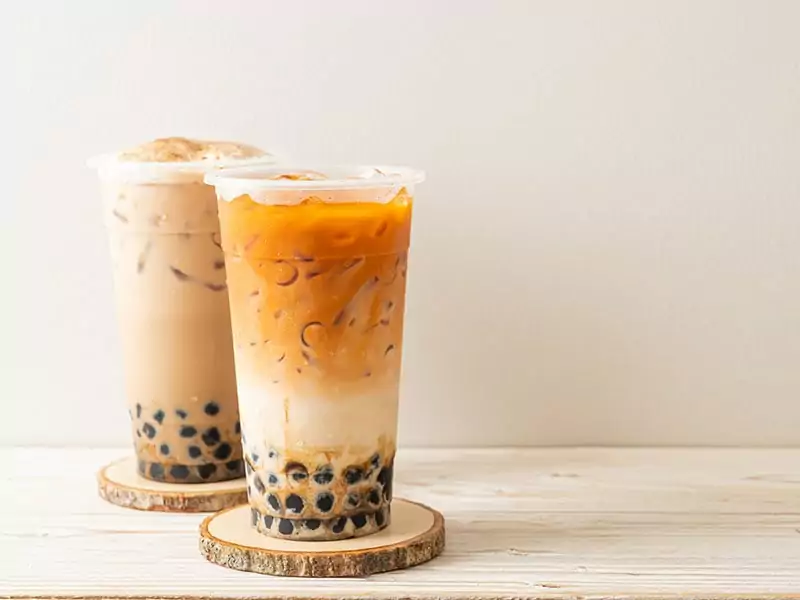
Bubble tea (boba or pearl milk tea) was invented in the 1980s by Chun Shui Tang in a teashop in Taichung, Taiwan. It’s now widely available in every corner of Taipei.
This delightful Asian-based drink combines green or black tea with milk and features chewy tapioca balls. Enjoyed through a fat straw, it comes in many flavors like Oreo, sweet potato, matcha, passion fruit, and taro.
A recent trend involves pouring brown sugar syrup into the cup before adding the tea and pearls. Bubble tea can be customized with sugar and ice levels and is never blended or made slushy like in the West.
46. Gua Bao (Pork Belly Buns)
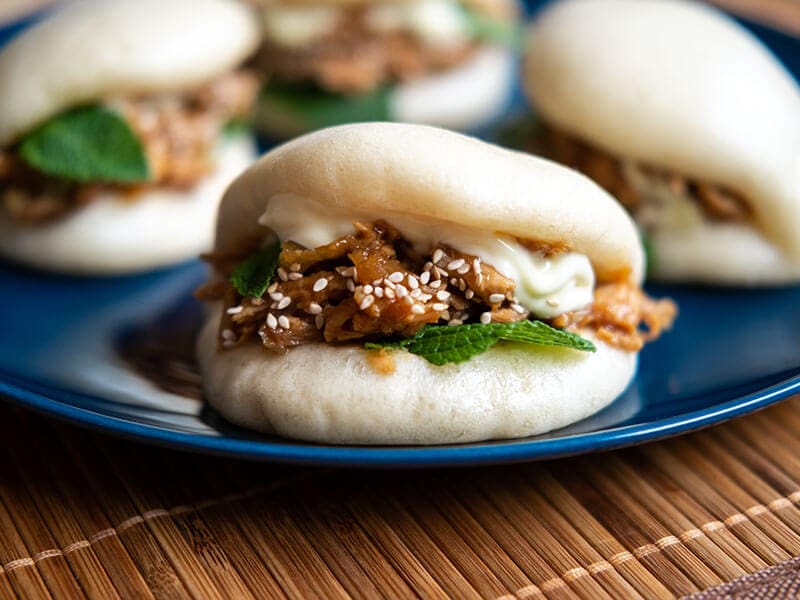
Gua Bao, originally from Fujian province in China, is a beloved Taiwanese street food in every market. These fluffy buns are filled with braised pork, creating a delightful combination of sweet, savory, fatty, and tender flavors.
Served with cilantro, pickled mustard greens, and ground peanuts, they balance freshness and crunch in every bite. Variations with roast duck, fried turkey, or tofu are also available.
Regarding its cultural significance, the Taiwanese often enjoy Gua Bao during New Year’s Eve celebrations as a symbol of wealth and prosperity. If you’re looking for a top-notch Gua Bao experience, the Michelin Guide recommends trying Lan Chia Guabao in the Gongguan Night Market.
47. Tie Dan (Iron Egg)
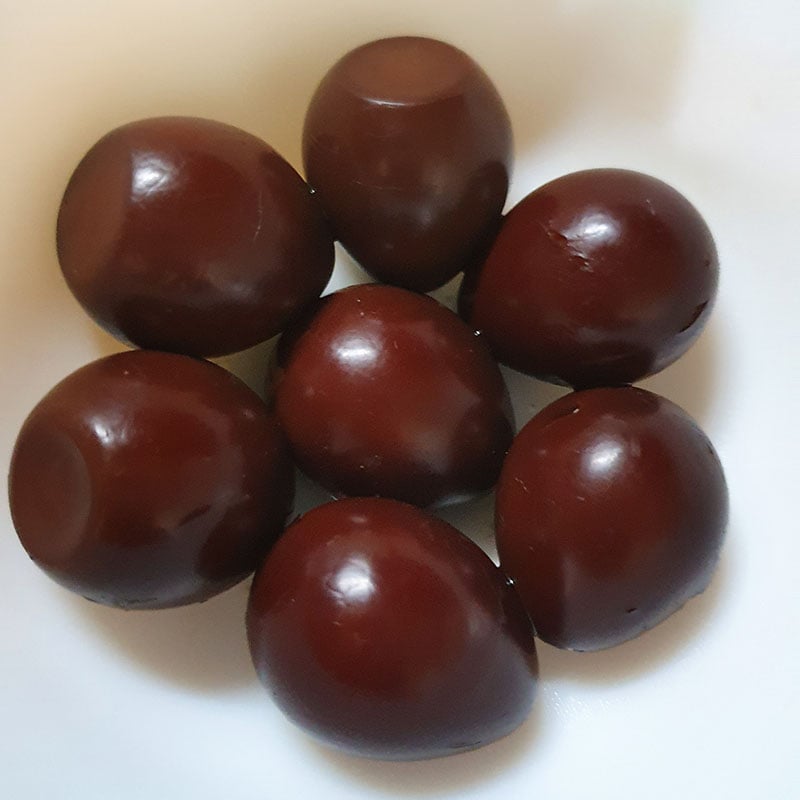
Tie Dan, or iron eggs, have their roots in the Tamsui district of Taipei. These are not your ordinary eggs. Hard-boiled chicken, pigeon, or quail eggs are stewed repeatedly (around eleven times) in a mix of tea, spices, and soy sauce before air-drying.
Their endearing, dark brown, nearly black hue comes from this distinctive preparation method. With a rubbery, chewy texture, they can be mistaken for century eggs but are pretty unique in taste.
They are a popular quick snack for on-the-go Taiwanese folks. Tie Dan is also available in different flavors, including spicy and non-spicy, and is normally sold packed in vacuum-sealed plastic packets.
In Turkey
48. Simit (Sesame Bread)
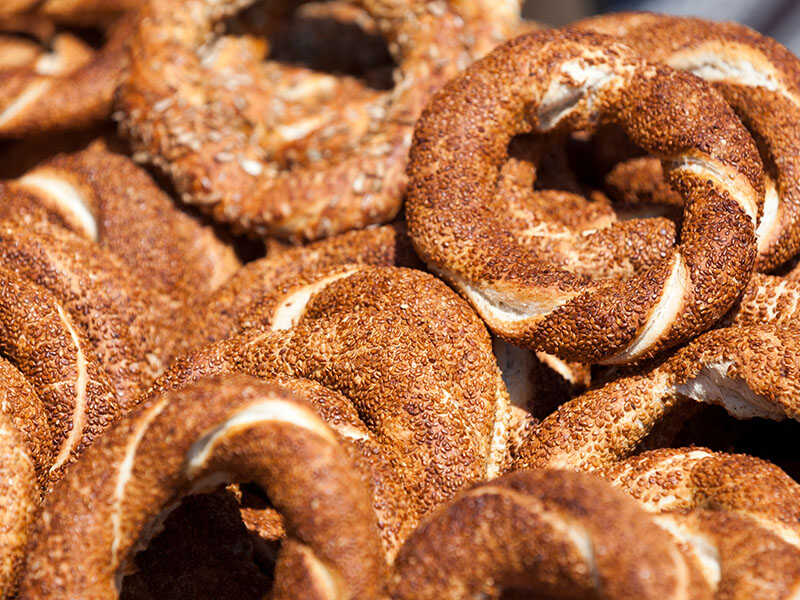
Simit, also known as Turkish sesame bread or Turkish bagel, has been an iconic breakfast food in Istanbul since the 1500s. The name “simit” comes from the Arabic word “samīd,” which means white bread or fine flour.
At first glance, they are circular bread covered with a generous coating of sesame seeds, though other seeds like poppy, flax, or sunflower may be used.
The dough is made with water, flour, yeast, and salt, similar to a bagel. It is shaped and dipped into a mixture of fruit molasses and water before being baked with a sesame seed coating. Interestingly, day-old Simit is sometimes used as feed for seagulls.
Simit is enjoyed in various ways: as a plain snack on the go, paired with tea, ayran (a salted yogurt drink), or fizzy beverages.
Turkish people usually consume it for breakfast with fruit preserves or chocolate spread. Or, they combine the bread with cheese (cream cheese, feta cheese), pastırma (salt-cured beef), and vegetables (parsley, tomatoes) for savory notesl
49. Lahmacun (Turkish Pizza)
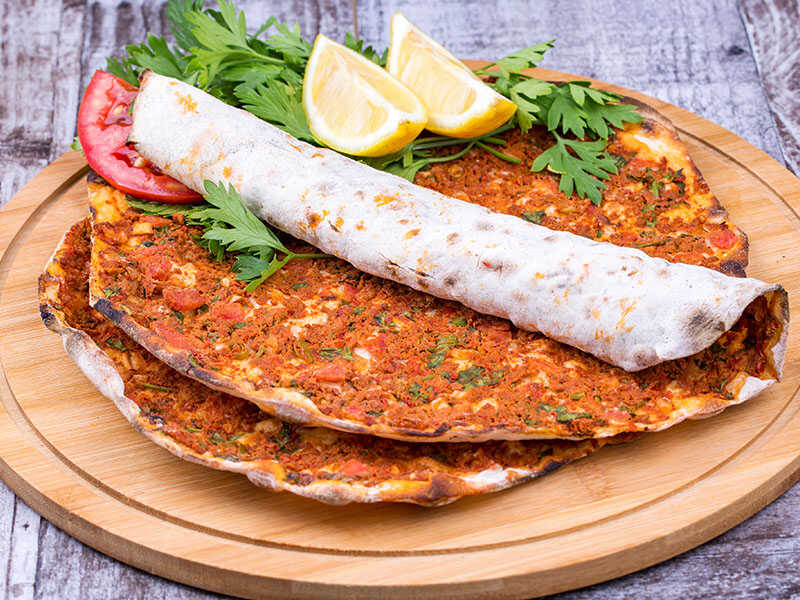
Lahmacun, or Turkish Pizza, hails from Urfa and Gaziantep in southwest Turkey. This delectable treat extends beyond Turkey, reaching the Middle East and some parts of the Ottoman Empire countries.
It’s a thin, crunchy semolina dough topped with spicy minced meat (lamb or beef), onions, chili pepper, and seasonings.
After baking, it’s garnished with parsley, lettuce, and lemon juice, rolled up, and enjoyed with cold ayran. Ideal for lunch or dinner, it’s commonly found at street stalls and Turkish restaurants. You will also find its mini versions in kebab eateries, which are popular as appetizers.
50. Kokoreç (Grilled Sheep Intestines)
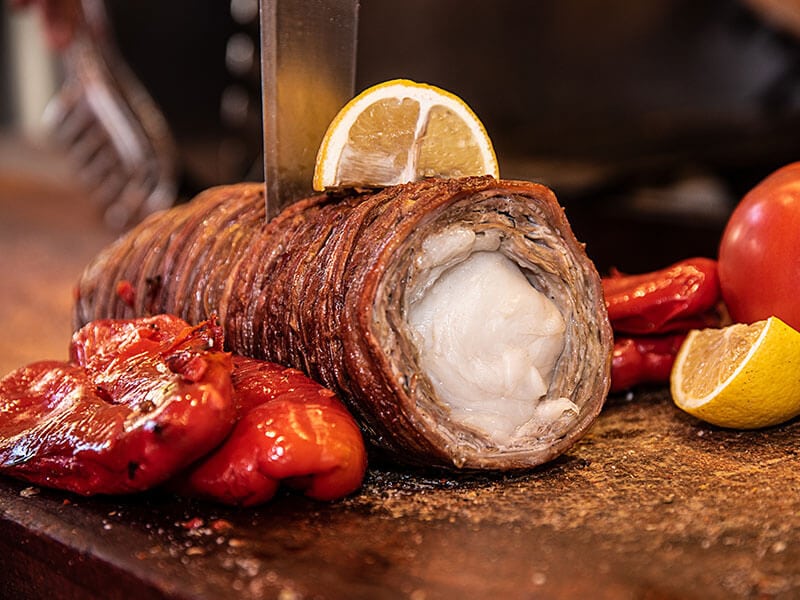
Kokoreç, with its ancient roots and heritage in Byzantine cuisine, is a beloved dish in Turkey and Greece. While both versions share similarities, there are notable differences.
In Greece, Kokoretsi includes lamb offal like lungs, kidneys, hearts, and liver, while Turkey includes small and large intestines and sweetbreads without additional ingredients.
The cleaned ingredients are threaded onto skewers and grilled over charcoal. They usually come with bread and are combined with flavorful spices and herbs of Asia, such as oregano, cumin, and chili flakes.
51. Gözleme (Turkish Stuffed Flatbread)
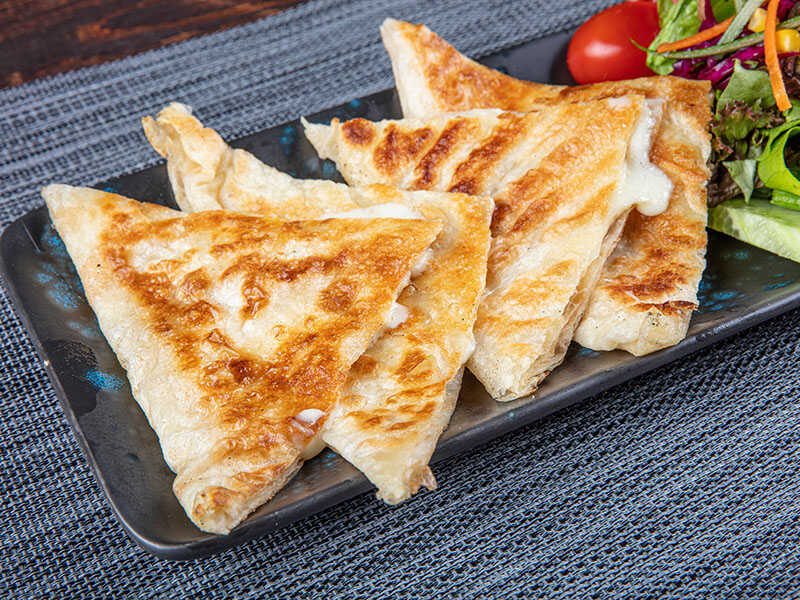
Gözleme is a delightful Turkish flatbread that’s attained fast-food stardom in Turkey. Crafted with a simple yet hearty mix of flour, water, and salt, this typically unleavened dough. However, some versions are yeast-based.
The dough is rolled thin, cooked on a sac griddle, and served flat. Locals also top it with various fillings, fold it into a tasty wrap, or slice it into bite-sized mini-rolls.
The fillings offer a delicious range of flavors, from spiced lamb or beef and seafood to various kinds of cheese, vegetables (like spinach, leek, and potatoes), and even eggs.
52. Döner Kebab
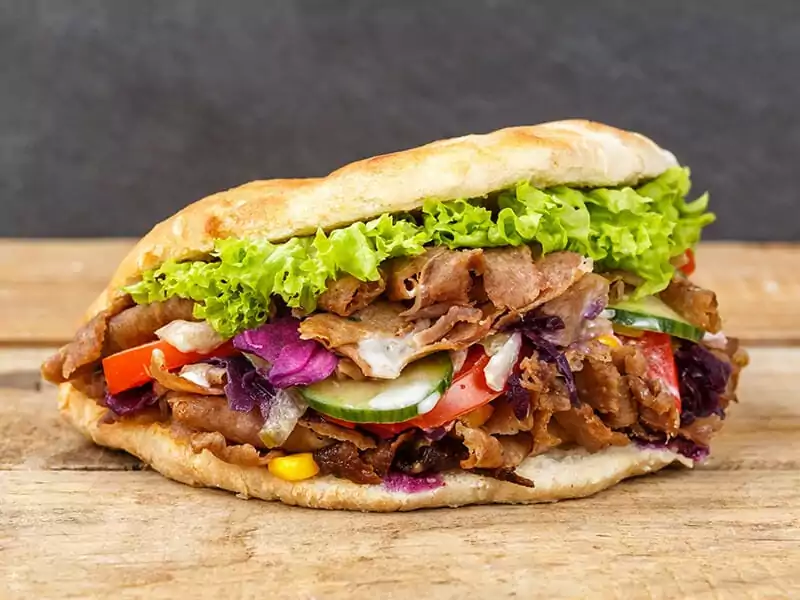
Döner Kebab is a famed Turkish takeaway food enjoyed worldwide. It’s a delicious kebab made with meat cooked on a vertical rotisserie and served in unleavened pita bread with vegetables and sauce.
You have choices of beef, lamb, or occasionally chicken for the meat, which is well seasoned and thinly cut after being cooked. Some versions even come stuffed with crispy french fries, adding an extra tastiness.
It’s a fulfilling and calorie-rich meal that can be enjoyed as a main course. In Turkey, you’ll find special variations like İskender Kebab, served on pide bread, and Dürüm Kebab, wrapped in grilled lavaş.
If you are confused between Doner Kebab and Gyro, these two have different roots. The former originated in Turkey, while the latter is Greek in origin.
53. Köfte (Meatball)
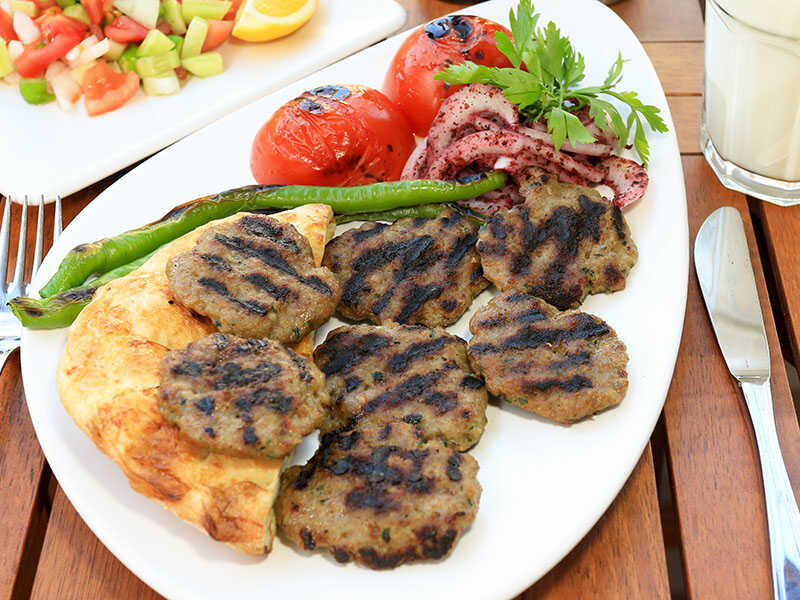
Prepare for a mouthwatering delight with Köfte meatballs (aka Kofta)! Made with ground lamb or beef, spices, and a touch of magic, Köfte offers endless possibilities. Steam, bake, grill, fry, or savor it raw – the choice is yours.
Some common varieties are the steamed Islama Köfte, grilled İnegöl Köfte (a specialty of Bursa), comforting Sulu Köfte (meatball stew with vegetables), or the tantalizing Shish Köfte (which is more like skewered kebabs than meatballs).
These versatile meatballs come in various sizes, from bite-sized to satisfyingly large. They also have many ways to consume, like enjoying Köfte as a mezze, solo with a toothpick, or soaking in a luscious broth. For a fulfilling feast, just pair it with rice or fluffy flatbread!
In Thailand
54. Som Tam (Green Papaya Salad)
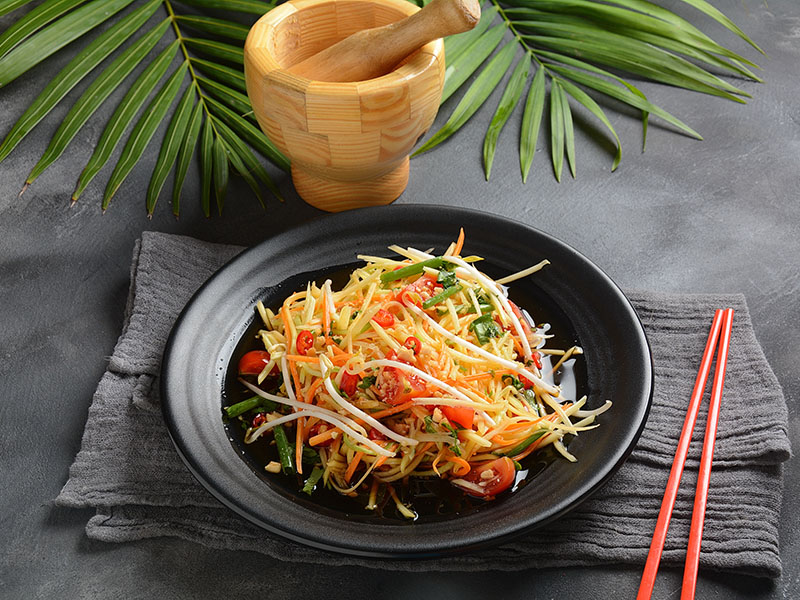
Som Tam is a delightful Thai green papaya salad. Hailing from the Isaan region of Thailand and with roots in Laos, this street food favorite can be found throughout the country.
Picture thinly sliced green papayas mingling with roasted peanuts, tomatoes, and dried shrimp. The dressing, a harmonious blend of lime juice, fish sauce, chili peppers, tamarind, and palm sugar, creates a symphony of flavors – salty, sour, sweet, and spicy.
Indeed, every bite takes me back to the bustling streets of Thailand, savoring the vibrant textures and irresistible taste. It’s an appetizer or snack that’s hard to resist.
55. Pad Thai (Thai-Style Fried Noodles)
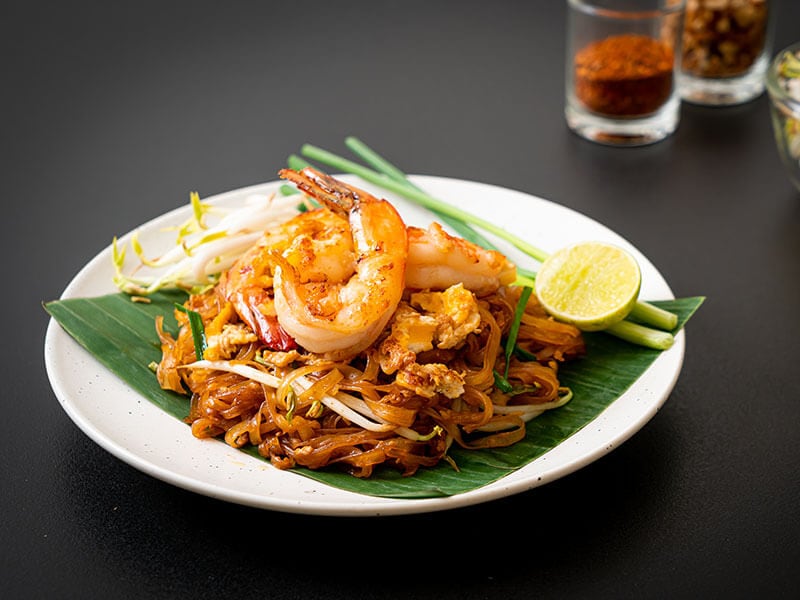
Pad Thai, Phat Thai, or Phad Thai, is a simple yet wonderful Thai-style fried noodle dish. Originating from China and developed in the 20th century, Pad Thai has become one of Thailand’s most beloved culinary treasures in this country and the world as well.
This stir-fry delicacy combines flat rice noodles, tofu, meat (if desired), dried shrimp, eggs, and fresh vegetables. However, the signature sauce steals the show, blending the perfect balance of sweetness, saltiness, sourness, and umami flavors.
Trust me! Its aromatic combination of ingredients and textures will leave you craving more. Just be mindful of its sodium and calorie content!
56. Khao Niaow Ma Muang (Mango Sticky Rice)
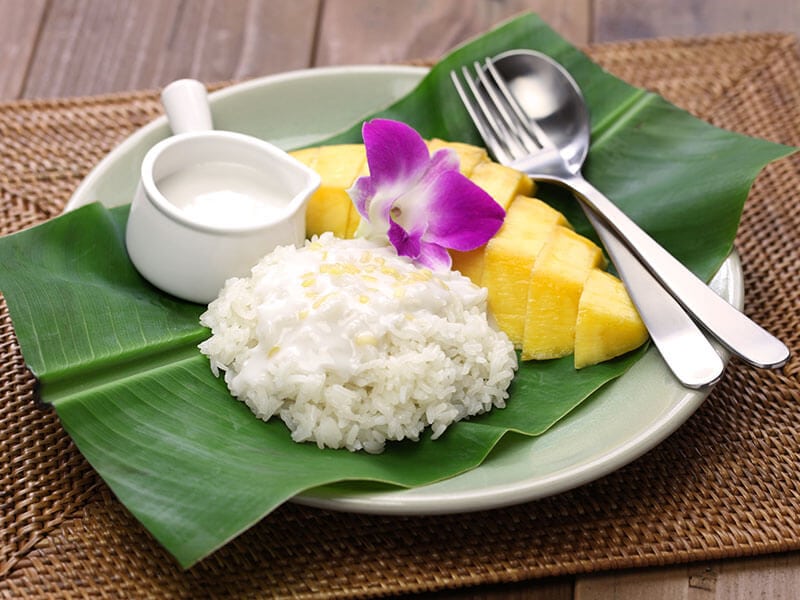
Khao Niaow Ma Muang is a classic Thai dessert that blends sweetness and creaminess perfectly. This delight features Thai sweet rice, coconut milk, grated coconut, and palm sugar or jaggery.
However, the recipe varies based on region. For instance, Northern and Northeastern variations may omit coconut milk.
For making this dessert, the rice is normally encased in a banana leaf, then steamed. This dessert is a heavenly treat, served alongside fresh mango slices and optional toasted sesame seeds.
The best mango cultivars for this treat are Nam Dok Mai and Ok Rong, which are sweet mango varieties. Moreover, Thailand’s peak mango season is from March to June, so it’s a must-try street food during this time.
57. Kai Foo Boo (Crab Omelette)
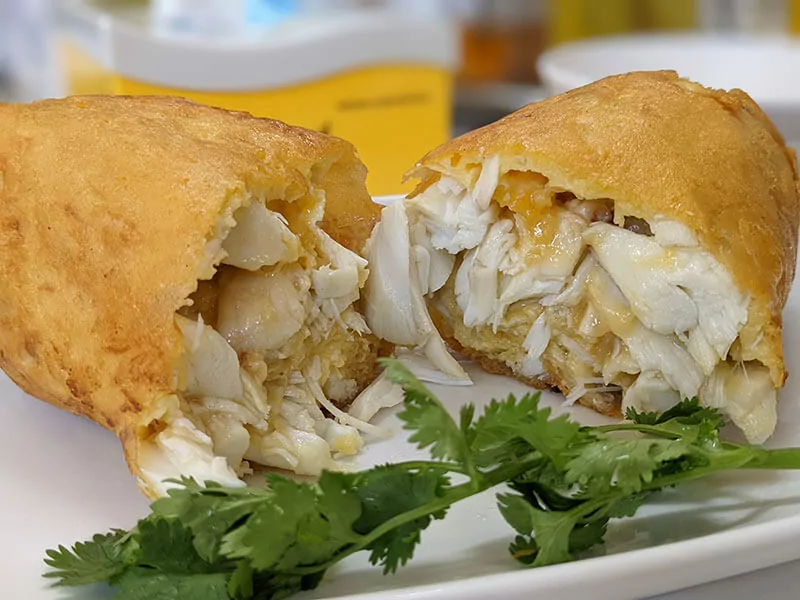
Kai Foo Boo is a popular rendition of Khai Jiao, a loved Thai-style omelette. The mixture of eggs is whisked and infused with spices and fish sauce, then deep-fried to achieve a delightful crispiness on the edges.
This variation boasts the addition of sweet and succulent crab meat, elevating the omelette to new heights. Whether savored with steamed rice or alongside a flavorful curry, this dish is a true indulgence.
For an extraordinary experience, you should visit Jay Fai in Thailand, renowned as one of the world’s rare Michelin-starred street food stalls. While it may have a higher price tag and a considerable wait, its generous and delicious crab omelette will leave you spellbound.
58. Khao Soi (Curry Noodle Soup)
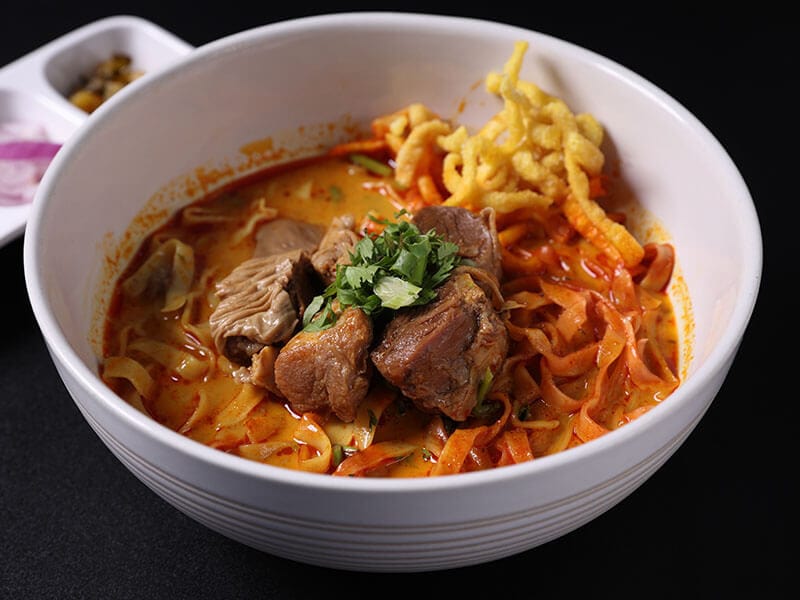
Khao Soi, a curry noodle soup, is a rich, spicy, and creamy delight. This Northern Thai specialty, also enjoyed in Laos and Myanmar, features egg noodles bathed in a coconut-based broth flavored with fresh herbs, spices, and your choice of beef or chicken.
With its fascinating history tracing back to the Chin Haw people, Khao Soi showcases the diverse culinary influences of Thai Chinese Muslims. But due to its Muslim origins, Khao Soi does not usually have pork, but some versions may include a tomato sauce with minced pork.
Finally, they are topped with crispy deep-fried egg noodles to offer a pleasant texture contrast.
59. Sai Krok Isan (Fermented Sausage)
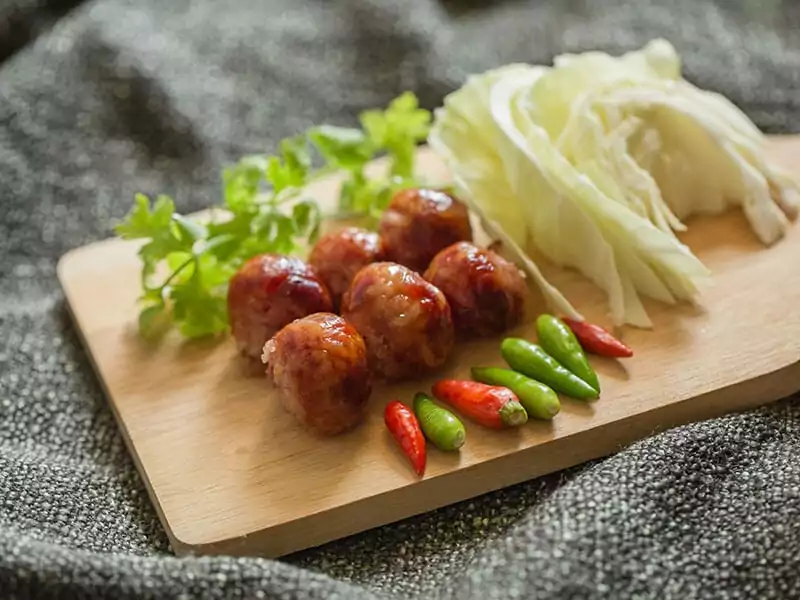
Sai Krok Isan, a specialty from northeastern Thailand, is a fermented sausage that you should take notice of. Crafted with ground pork, garlic, pepper, and sticky rice, it undergoes a sun-kissed fermentation, infusing it with a sour and garlicky flavor.
With this distinctive taste, Sai Krok Isan is great to pair with sweet or neutral fresh vegetables like cabbage and cucumber, or add a kick with spicy chili peppers or ginger. If you want to cook it, grilling or frying the sausages in a wok with oil is ideal.
For a complete meal, serve them with a side of sticky rice.
In Indonesia
60. Satay (Grilled Meat)
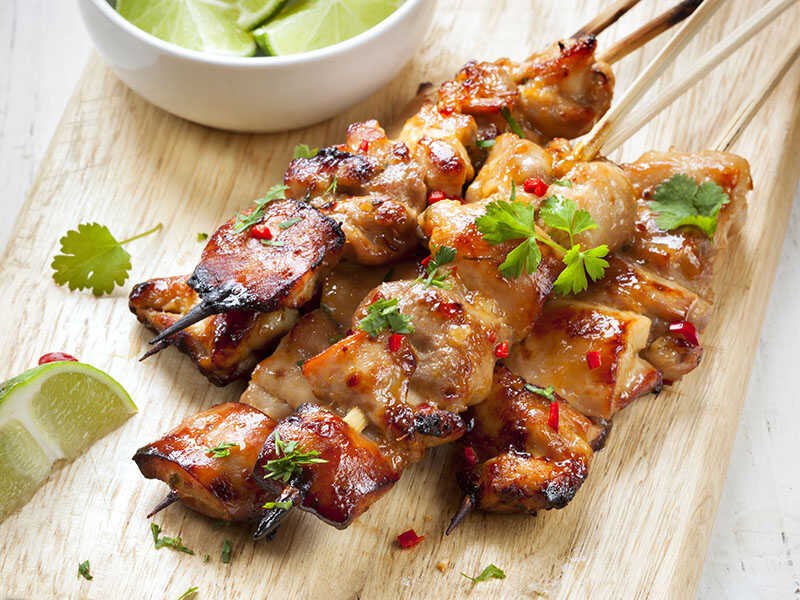
Satay, or Sate, originates from Java, Indonesia but is beloved throughout Southeast Asia, including Malaysia and Singapore. This grilled meat delight brings a BBQ-like experience with skewered and seasoned meat grilled to perfection.
The seasoning sauce, featuring sweet soy sauce and many spices, ensures an irresistible blend of salty, sweet, spicy, and umami flavors. Various types of meat like fish, mutton, beef, chicken, goat, and even pork are great for this case. For vegetarians, tofu satays are tasty, too!
They are mostly skewered on bamboo sticks, but you can also find them with lemongrass sticks, which also enhance the taste of the meat.
Ideally, peanut sauce (bumbu kacang) infused with lime juice and sambal chili paste is the best sauce to serve with satay. Don’t forget to relish it with traditional Lontong rice cake on the side.
61. Gado-gado (Mixed Salad)
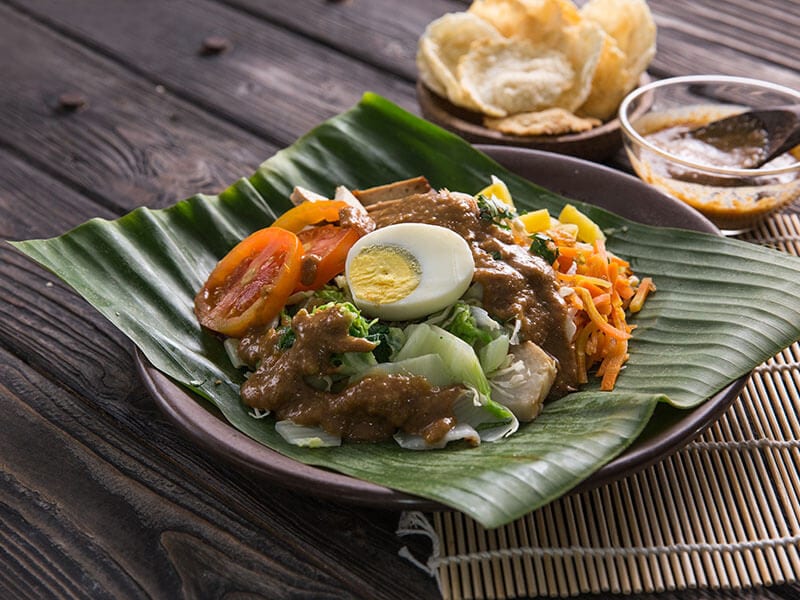
Gado-gado, meaning “mix-mix,” is a versatile mixed salad with various regional variations across Indonesia. The key ingredients are boiled or steamed vegetables, hard-boiled eggs, fried tofu, tempeh (food made from fermented soybeans), and Lontong rice cakes.
With a medley of starchy, leafy, and watery vegetables, the salad has various textures. The dressing, made from peanuts or kidney beans, tamarind juice, palm sugar, and salt, creates a beautiful blend of flavors.
Thanks to the diversity of components, this is a nutrient-rich dish with loads of proteins, carbs, fiber, healthy fats, etc.
Though Gado-gado’s origin is unclear, many believe it is influenced by Chinese, Portuguese, and native cuisines. But in 2018, it was chosen as one of Indonesia’s national dishes.,
62. Rendang (Slow-cooked Meat Dish)
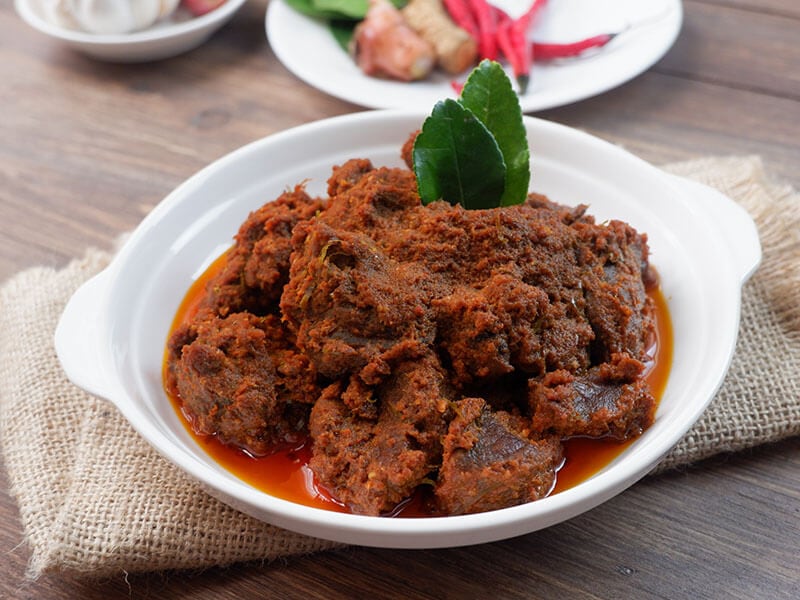
Rendang, a slow-cooked meat dish, is one of Indonesia’s national delicacies. Originating from Minangkabau, West Sumatra, it has become a culinary symbol of the region and is often served during important occasions.
Typically prepared with beef, the meat is braised in a heavenly blend of coconut milk, fragrant herbs, and spices like lemongrass, shallots, ginger, and garlic until the liquid evaporates, leaving behind a thick, spicy, and intensely flavorful coating.
The result is exquisitely tender meat melts like butter. Despite the lengthy cooking process, Rendang’s dryness and abundance of spices grant it a long shelf life, lasting for weeks when refrigerated. It is commonly enjoyed alongside steamed rice, boiled vegetables, and rice cakes.
63. Getuk (Cassava Dessert)
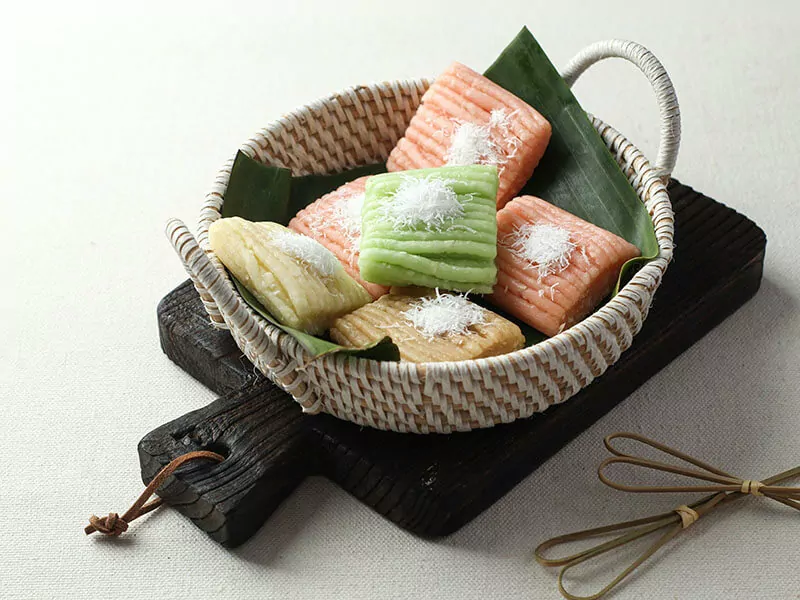
Getuk, a cassava-based dessert, is especially famous in Javanese cuisine. Made by boiling and mashing cassava, it is mixed with grated coconut and sugar. Other starchy vegetables like sweet potatoes or taro are used in some variations.
While some vendors enhance the flavor with butter, milk powder, or vanilla extract, classic Getuk delights everyone with its natural delicate sweetness and aroma. Plus, they have a vibrant color due to the food coloring.
64. Kerak Telor (Spicy Omelette)
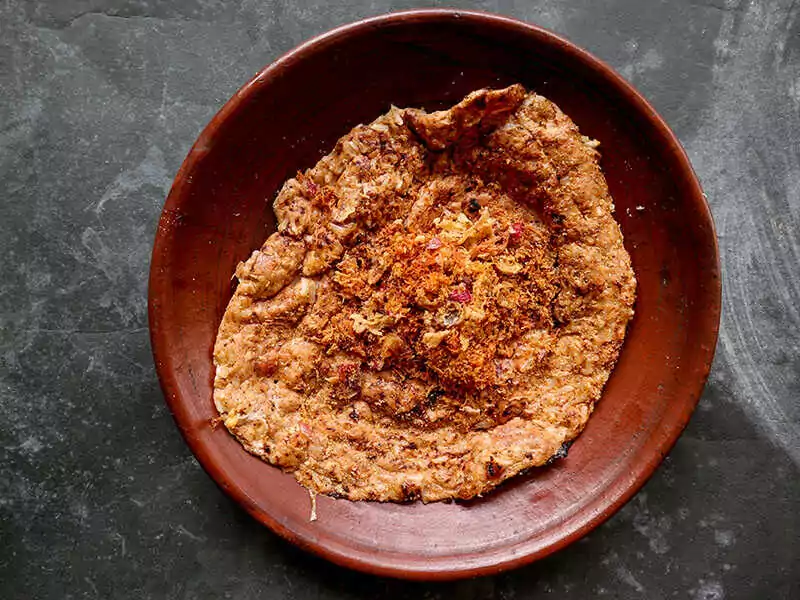
Kerak Telor (meaning “egg crust”) is a delectable treat that traces its roots back to Jakarta during the Dutch colonial era. Originally reserved for the elite, this dish has now become a beloved street snack found throughout the city.
Unlike your typical omelette, Kerak Telor incorporates sticky rice and a lot of exotic Indonesian spices, resulting in a pancake-like appearance and an unforgettable spicy flavor.
Topped with dried shrimp, fried shallots, and shredded coconut, this dish provides a delightful blend that you can’t forget.
65. Rojak (Fruit Salad)
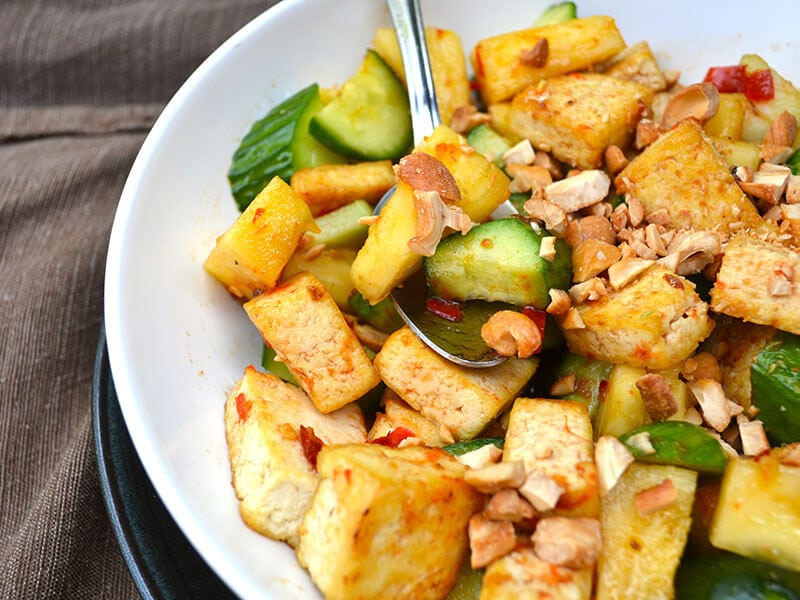
Rojak is a tangy salad originating in Java made from different Asian fruits and vegetables. This is also a beloved treat in Malaysia and Singapore. They are bite-sized fruits and vegetables mingled in a sweet, spicy palm sugar-red chili pepper dressing.
The ingredient options are endless, but the ideal choices are crunchy and have a sweet and/or sour flavor. Jicama, cucumbers, bean sprouts, mangoes, and pineapples are popular picks.
Some versions may include roasted peanuts, shrimp paste, or dried shrimp. With its diverse components, Rojak offers countless variations across Indonesia.
It is served on a plate with bamboo skewers, and for a perfect blend of flavors, just mix this salad thoroughly to ensure even coating on the pieces, then use a skewer to poke the food and enjoy!
66. Nasi Goreng (Fried Rice Dish)
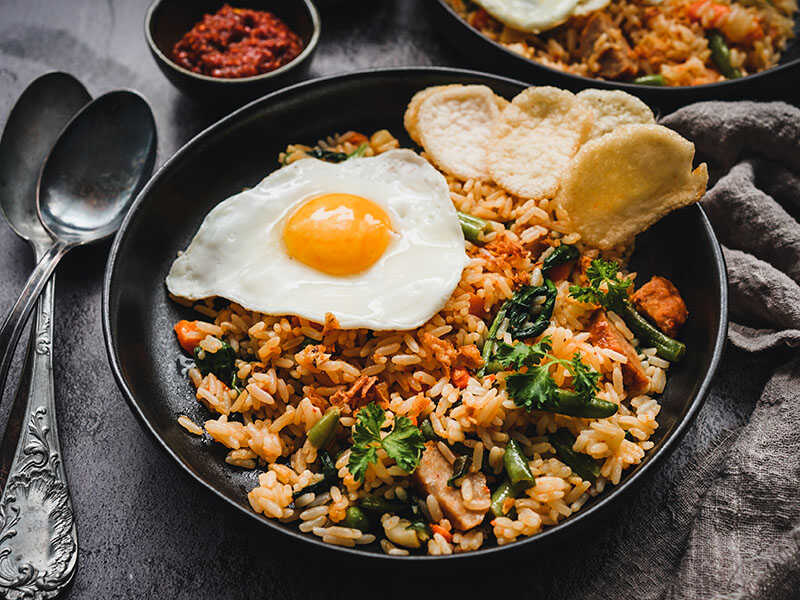
Nasi Goreng is one of Indonesia’s national specialties. This rice dish’s origins can be traced back to Southern China.
What makes Nasi Goreng special is its versatility in ingredients, often utilizing leftover rice (as freshly cooked rice isn’t dry enough), vegetables, and optional meat.
Topped with fried, sunny-side-up, or hard-boiled eggs, shrimp paste and kecap manis (sweet soy sauce) are the key condiments that give it an incredible flavor. The final result is a smoky, aromatic masterpiece.
It is perfect for breakfast, meals, or a tasty snack. Variations of this delectable dish can also be found in neighboring countries, particularly Malaysia.
67. Kwetiau Goreng (Stir-Fried Noodles)
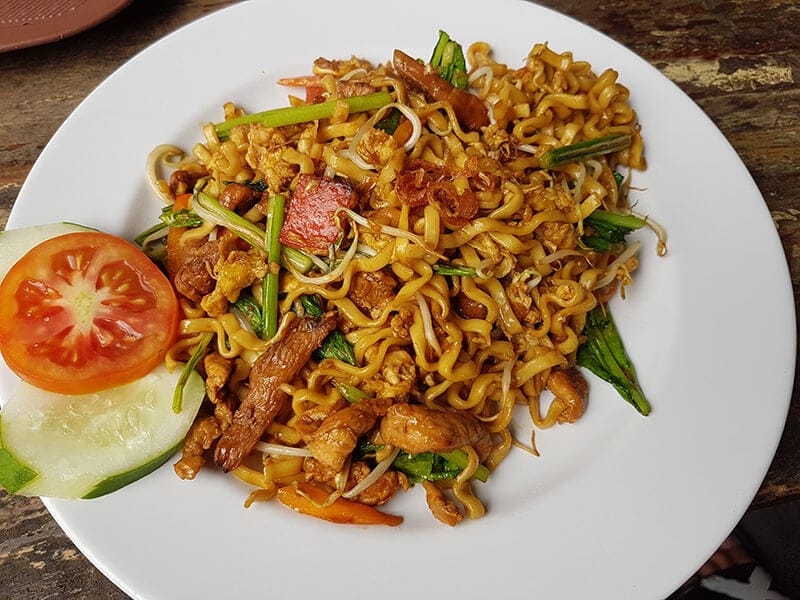
Kwetiau Goreng is a yummy stir-fried noodle dish that can also be enjoyed at dine-in restaurants, let alone from street vendors. The star of this dish is the flat noodles, known as Kwetiau, which are wok-fried with other proteins such as succulent prawns, crab, eggs, beef, or chicken.
Adding a burst of freshness, a colorful combination of vegetables (like cabbage and tomatoes) is tossed in. And for authentic Indonesian flavor, locals use a generous amount of kecap manis soy sauce to impart a depth of flavor.
With its sweet, savory, and smoky notes, this dish is a true crowd-pleaser.
In Singapore
68. Hainanese Chicken Rice
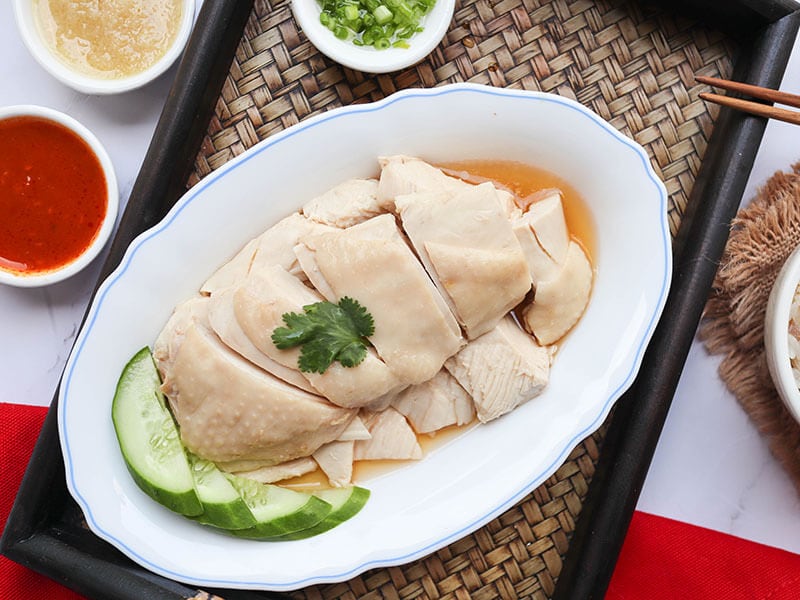
Hainanese Chicken Rice, also known as Singapore chicken rice in some places, carries the flavors of Hainan Island but is not of Chinese origin. It was created by Hainanese immigrants in Singapore, drawing inspiration from the traditional Hainanese dish called Wenchang chicken.
Although its birthplace is disputed between Singapore and Malaysia, there’s no denying its status as one of Singapore’s most beloved dishes since the 1940s.
Tender poached chicken, fragrant seasoned rice, cucumbers, and chili sauce make for a decadently rich culinary experience.
69. Char Kway Teow (Stir-Fried Noodles)
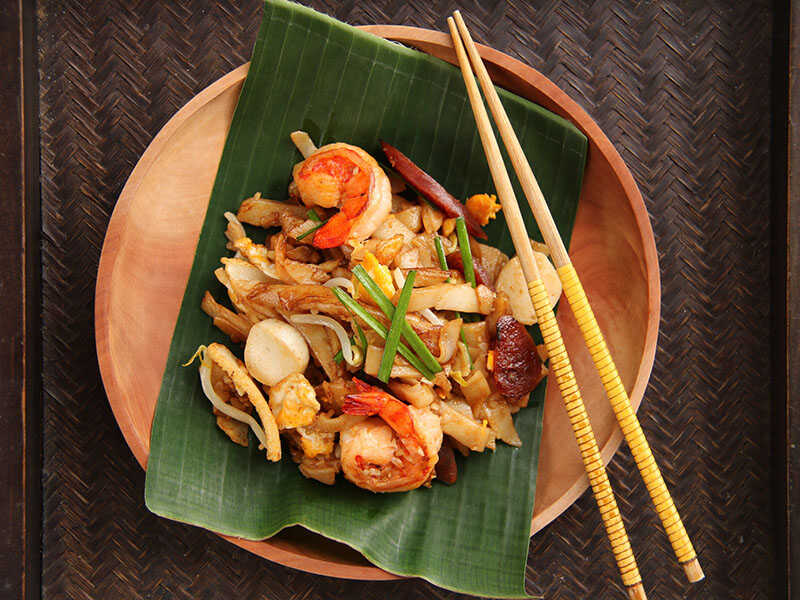
Char Kway Teow is a popular stir-fried noodle dish pronounced ‘cha-gway tee-ow’ that originated in China’s Guangdong province. It has gained popularity in Malaysia and Singapore.
The dish consists of rice noodles, bean sprouts, soy sauce, lard, chili paste, chives, and various proteins like Chinese sausage, prawns, and shelled blood clams. It is a satisfying, affordable street food with a distinct smoky aroma.
Compared to other Southeast Asian noodle stir-fries, such as Pad Thai, Char Kway Teow is more savory. It is important to consume it in moderation due to its high sodium and fat content, although you can request the omission of lard for a healthier version.
70. Kaya Toast (Toast And Coconut Yam)

Kaya Toast, Kaya, or Serikaya, is a staple breakfast dish in Singapore, combining toast and a fragrant, creamy spread known as kaya, made from coconut cream, sugar, eggs, and pandan.
Believed to be crafted by Hainanese cooks, this aromatic treat is served with hard or soft-boiled eggs, available in cafes and hawker stalls. They are best to relish with a cup of tea or coffee.
71. Chili Crab
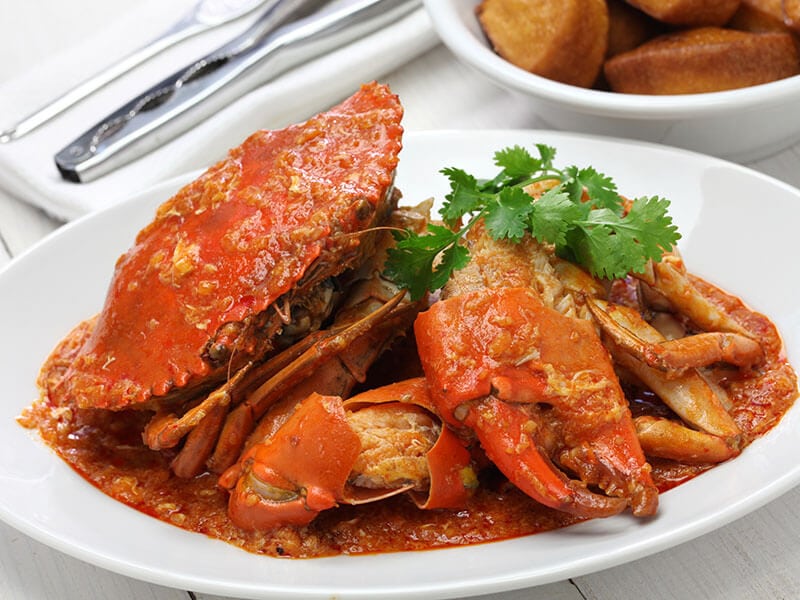
Chili crab is a dish that originated in the 1950s. This features mud crabs stir-fried or deep-fried in a flavorful tomato-and-chili sauce. Steamed buns called Mantou are its common accompaniment to scoop the sauce up.
Eating this dish with your hands is the traditional way. The tender and fluffy crab meat makes it easy to do so. To enjoy the tougher parts of the shell, just use nutcrackers or mallets. While mildly spicy, the chili crab mainly possesses irresistible sweetness and savoriness.
72. Roti Prata
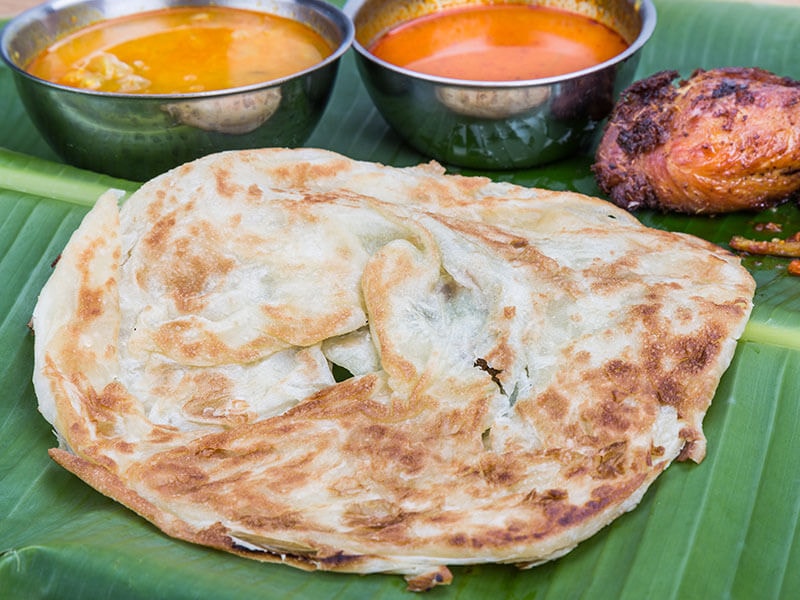
Roti Prata, aka Roti Canai, is commonly found in Singapore’s restaurants, cafes, and street food stalls. It is a round flatbread made from ghee, flour, and water, cooked on a flat grilling pan. It has different textures, ranging from chewy to crispy on the outside and soft on the inside.
The flatbread is great to eat with curries or savory dishes like fish, cheese, ham, eggs, mushrooms, and more. Additionally, it pairs well with sweet treats such as fruits, ice cream, and chocolate.
In Hong Kong
73. Cheung Fun (Rice Noodle Roll)
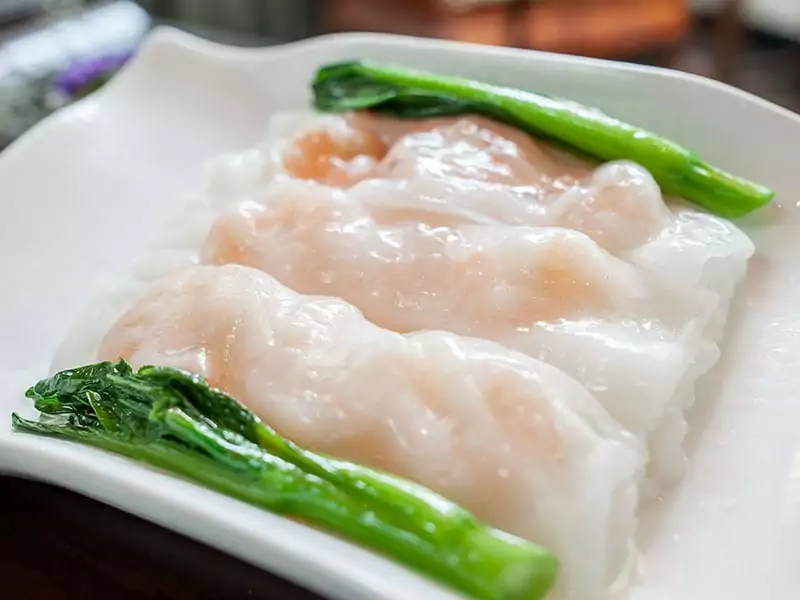
Cheung Fun, meaning “intestine noodles” in Cantonese, is a popular street food and dim sum roll in Cantonese cuisine. Despite its name, it doesn’t actually contain entrails. Cheung Fun is commonly enjoyed for breakfast or lunch.
This delight is a thin and translucent rice roll prepared by mixing rice flour, tapioca flour, and water, then steamed and folded. It has a smooth texture, distinct al dente chew, and a mildly bland taste.
These rice noodle rolls are also filled with ingredients like Char Siu, dried shrimp, beef, or vegetables. It is served with accompanying sauces, such as soy, sweet, hoisin, peanut, or chili sauce. For more flavor, sprinkle some roasted sesame seeds on the top.
There are other variations for vegans and vegetarians as well!
74. Gaa Lei Yu Dan (Curry Fish Balls)
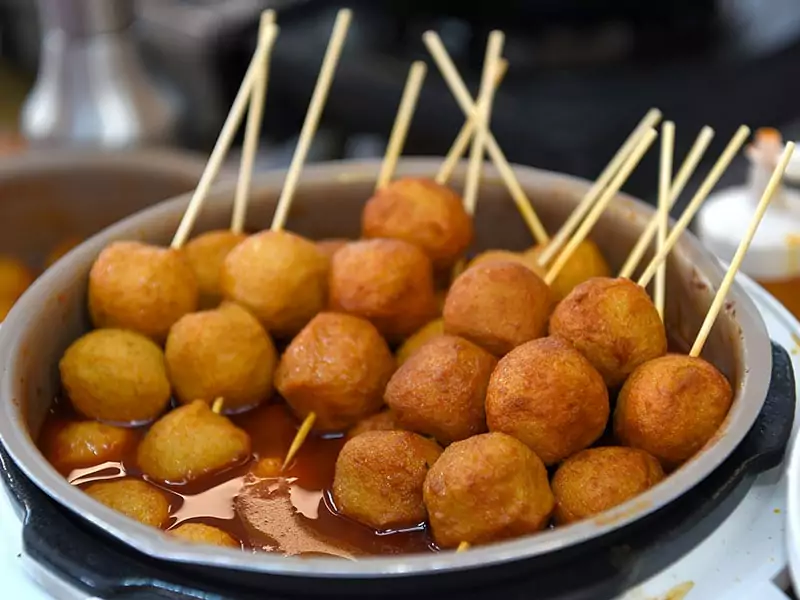
Yu Dan, a Hong Kong delicacy popular throughout Asia, consists of ping-pong-sized balls made from shredded and pounded fish. These savory morsels are deep-fried and then simmered in a fragrant curry sauce infused with garlic, ginger, sugar, and chili.
Therefore, it has a robust flavor. Whether on bamboo skewers, a plate, or in a Styrofoam cup with a sharp stick, these delicious fish balls are served alongside curry sauce, spicy dipping sauce, and soy sauce.
For an extra kick, top them with chili oil and savor them for a flavorful lunchtime treat.
75. Gai Daan Jai (Egg Waffles)
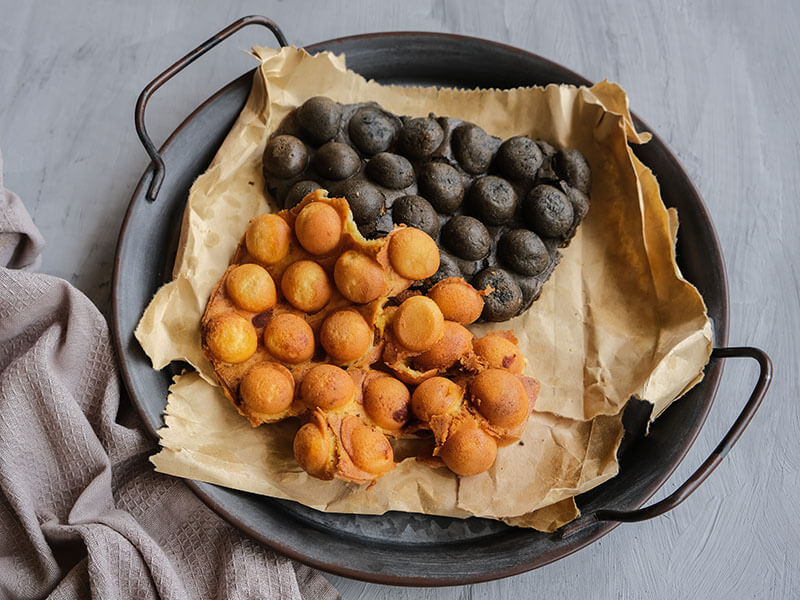
Gai Daan Jai, also known as egg waffles, egg puffs, or eggettes, originated in Hong Kong in the 1950s. This egg waffle is also popular in Macau!
This one-handed snack is a great way to utilize unsold broken eggs. The batter is made from a light and slightly sweet mixture of flour, sugar, and evaporated milk.
It is cooked in a special waffle maker with round cells over a charcoal flame, resulting in a texture resembling large bubble wrap.
Gai Daan Jai can be enjoyed plain or rolled into a cone and paired with fresh fruit, ice cream, syrup, or toppings like chocolate sauce, Nutella, green tea, desiccated coconut, chocolate chips, sprinkles, or stuffed with banana.
For a savory twist, salted egg yolk, bacon, or seaweed are good additions.
76. Dan Tat (Egg Tarts)

Dan Tat, or egg tarts, has a fascinating history originating from British chefs in Guangzhou’s tea houses after coming to Hong Kong in the 1950s due to the cultural revolution.
Reminiscent of English egg custard tarts and Portuguese pastel de nata, they were even cherished by Chris Patten, the last British governor of Hong Kong. These delightful treats can be found in local cha chaan tengs (tea restaurants), street bakeries, and dim sum restaurants.
There are two types available: one with a soft and flaky meringue crust and the other with a cookie-like butter crust, both equally irresistible. With a smooth, glassy surface and a luscious egg custard filling made with egg, milk, and sugar, they are baked to golden-yellow perfection.
In addition, egg tarts’ taste resembles a crème brulée. Locals enjoy them for breakfast, and they are best when fresh out of the oven.
In Malaysia
77. Nasi Lemak (Coconut Milk Rice)
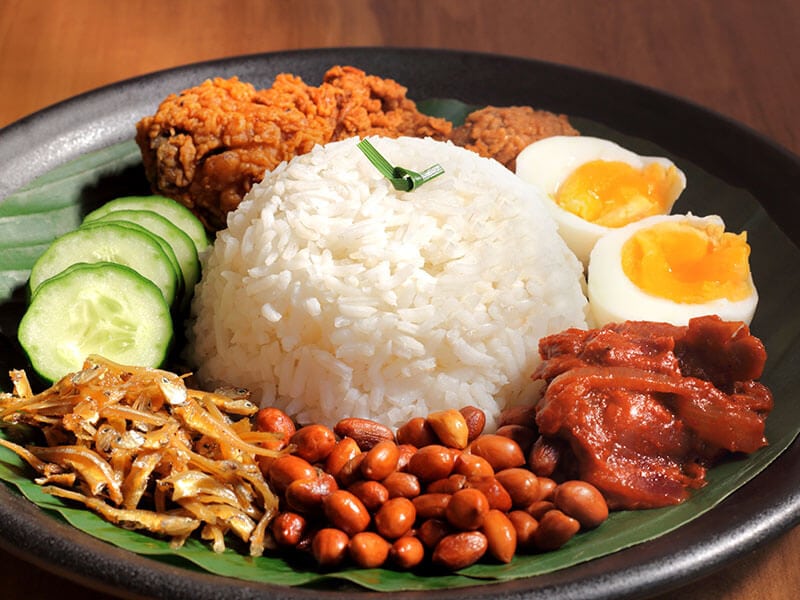
Nasi Lemak is a national dish of Malaysia, which is also popular in Singapore. It features coconut milk-infused rice cooked with fragrant pandan leaves.
This vibrant dish is served on a banana leaf, accompanied by fried anchovies, hard-boiled eggs, cucumber, toasted peanuts, and sambal (chili paste).
With different varieties influenced by cultures and chefs, the fluffy and aromatic rice pairs perfectly with the spicy sambal and other components. Plus, it is not similar to Nasi Goreng, which is made with fried rice.
In general, Nasi Lemak is a must-try street food you can easily find at small stalls in the country.
78. Asam Laksa (Fish-based Sour Noodle Soup)
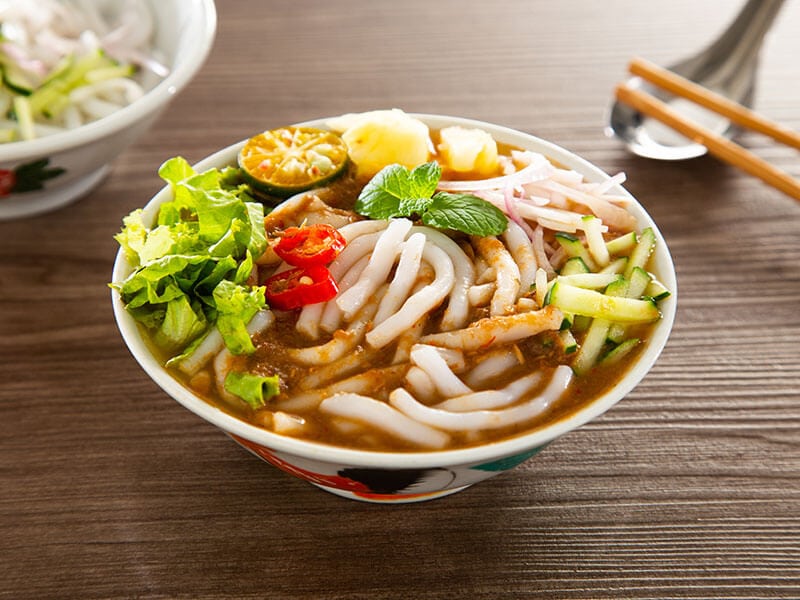
Asam Laksa is a fish-based sour noodle soup believed to have originated in the coastal areas of Malaysia, where fishermen typically use fish and other available ingredients to make it.
It is a must-try dish in Penang, which is also known as Penang Laksa in this area. FYI, the dish’s name, “Asam,” means sour in Malay, reflecting the dish’s tangy profile.
The main ingredients are thick rice noodles, tamarind paste (asam jawa), shredded fish, galangal, lemongrass, and chili. The best fish, in this case, is mackerel (ikan kembung).
The soup has a hearty fish broth with a sweet and sour flavor, distinct from the coconut milk-based Laksa.
79. Rojak
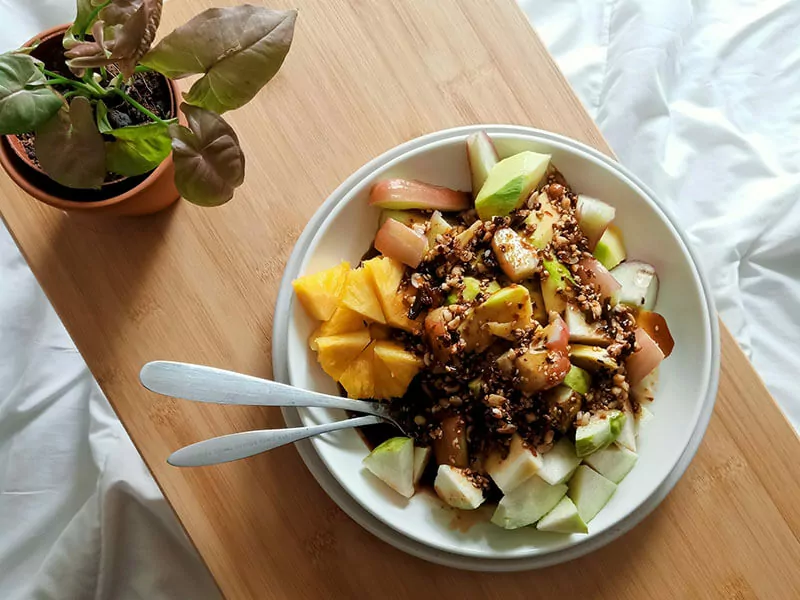
In Malaysia, there are two main types of Rojak: Rojak Mamak and fruit Rojak. Rojak Mamak is sold in Muslim Malaysian-Indian food stalls and includes tofu, prawn fritters, eggs, dough fritters, and cucumber, all mixed with a thick peanut sauce.
Fruit rojak, on the other hand, is a mixture of sliced fruit and vegetables with a spicy dressing. Common fruits used are pineapple and jícama, while cucumber and bean sprouts are common vegetables.
The thick dressing of the fruit Rojak is made from chili, lime juice, sugar, and belacan (shrimp paste). Overall, its ingredients may vary based on the sellers, but they are all cut into small pieces for better absorption of the dressing.
80. Roti Canai (Flatbread)
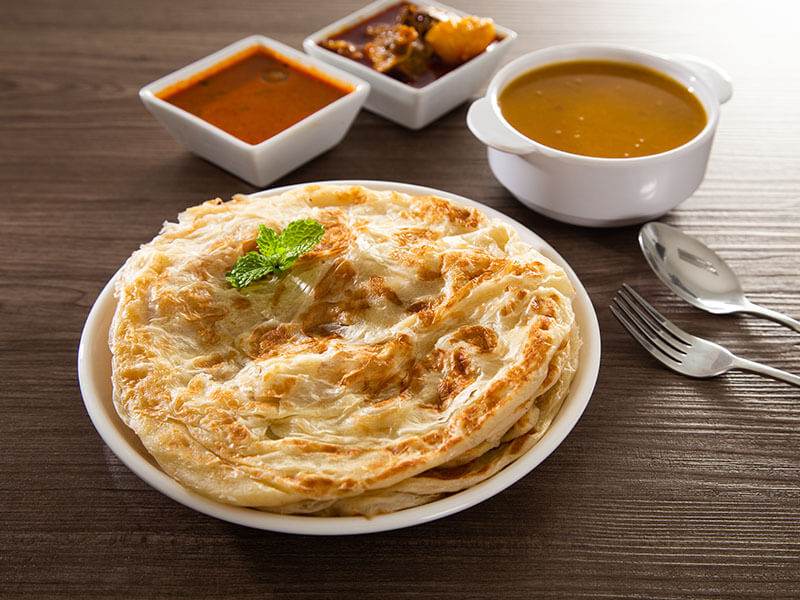
As mentioned above, Roti Canai (Roti Paratha or Roti Prata) is a popular flatbread in both Malaysia and Singapore.
In Malaysia, you can buy them from street mamak stalls across rural and urban areas. With a slightly buttery flavor and a warm, tear-apart texture, it is a delightful treat that can be enjoyed on its own or paired with savory accompaniments.
Therefore, locals traditionally enjoy it with dhal curry and a cup of Teh Tarik (Malaysian pulled tea).
In Korea
81. Tteokbokki (Spicy Rice Cakes)
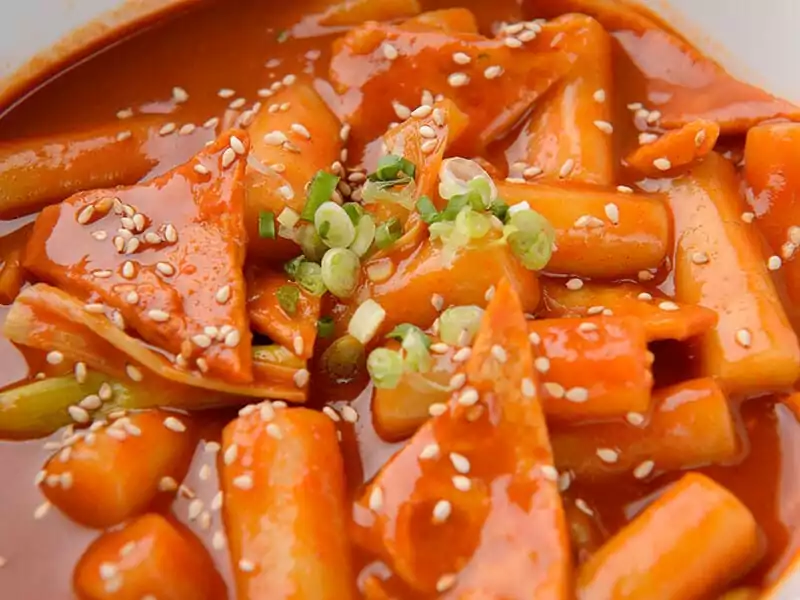
Tteokbokki is one of the most popular Korean street foods found at street stalls (pojangmacha). At first glance, it is a dish of stir-fried rice cakes in a spicy red sauce. The sauce, predominantly made from chili paste (gochujang), gives it a spicy kick.
Alongside the simmered rice cakes, you’ll find boiled eggs, fish cake (eomuk), and green onions. The dish features many variations, including cream sauce-tteokbokki, seafood-tteokbokki, and Gungjung-tteokbokki.
It can also be served in soup or hot pot style. Commonly found at street stalls (pojangmacha). For homemade Tteokbokki, you can purchase semi-dehydrated rice cakes from the supermarket for easier preparation.
82. Jeon (Savoury Pancake)
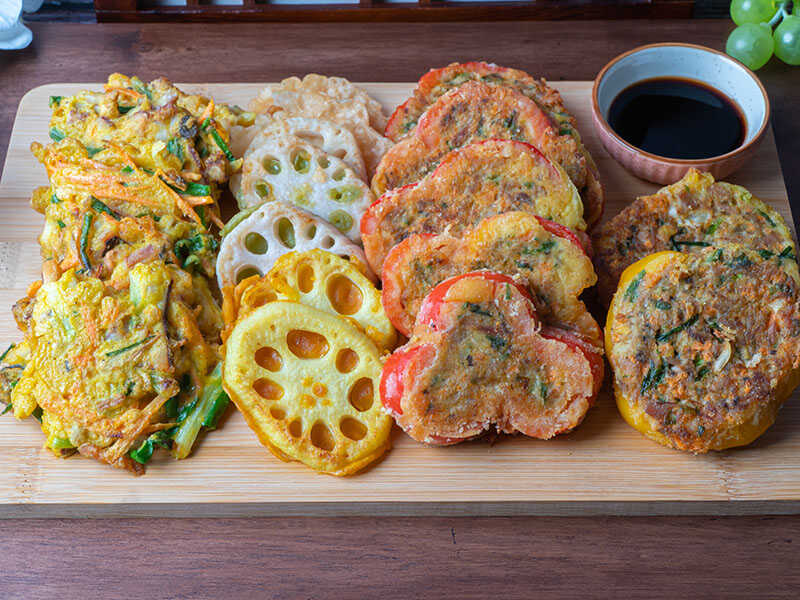
Jeon is a savory pancake that is pan-fried to a flat, chewy, and crispy texture. It is made with a combination of vegetables, flour, seafood, meat, and eggs. Traditionally, it is prepared during the Korean Lunar New Year and Korean Harvest Festival.
Jeon is a versatile dish, suitable for breakfast, appetizer, side dish (banchan), or snack. There are various types of Jeon, including kimchijeon (with kimchi), pajeon (with green onions), and guljeon (with oysters).
To enhance the flavors, I love to eat it with a spicy soy-based dipping sauce.
83. Kimbap
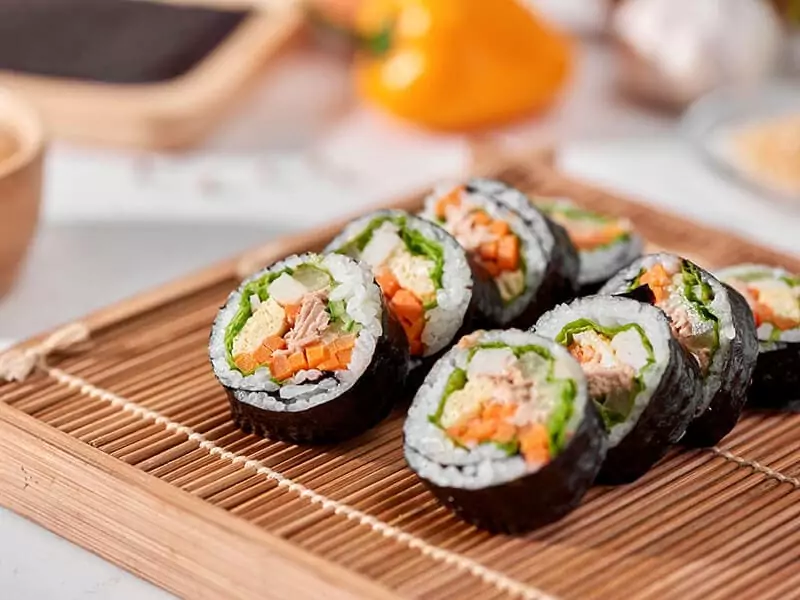
Kimbap (or gimbap) is a Korean dish consisting of rice, meat, or crab stick, and vegetables (like carrot, cucumber, spinach, or pickle daikon radish) rolled in seaweed sheets.
These rolls are then sliced into bite-sized pieces. Unlike sushi, which often features raw fish and vinegar-seasoned rice, kimbap offers a different taste profile based on its ingredients and the satisfying crunch of the vegetables.
While most Korean kimbap is served without dipping sauce, feel free to savor it with soy sauce or mayonnaise if desired.
84. Sundae / Soondae (Blood Sausages)
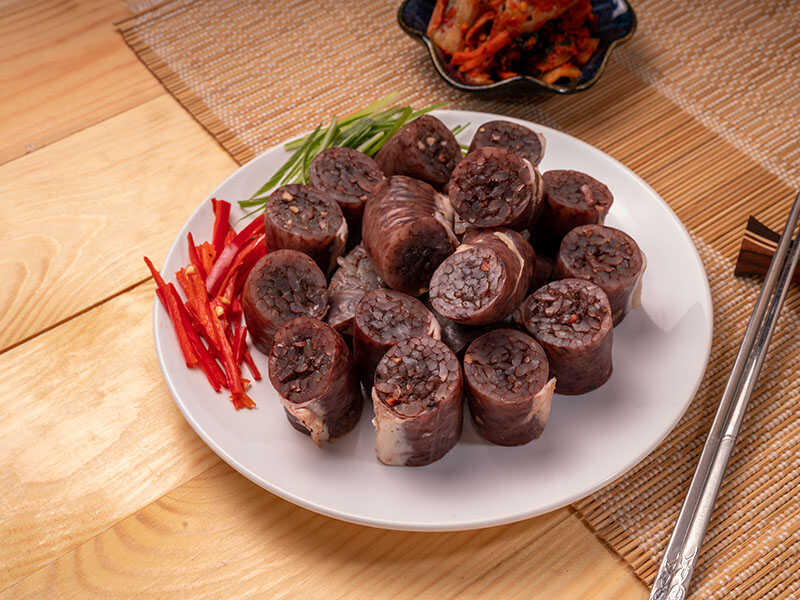
Sundae, in Korean cuisine, is not an ice cream. In fact, this is a renowned blood sausage enjoyed in both South and North Korea.
This inexpensive street snack is made from cow or pig’s intestines stuffed with blood (seonji), rice, minced meat, and vegetables. It is often steamed with other offals like lung and liver.
To eat Sundae properly, you must enjoy it warm. And the sausage pairs well with a dip of salt and pepper or gochujang. For an added touch, consume Sundae wrapped in lettuce or with steamed rice.
85. Odeng (Fish Cake)
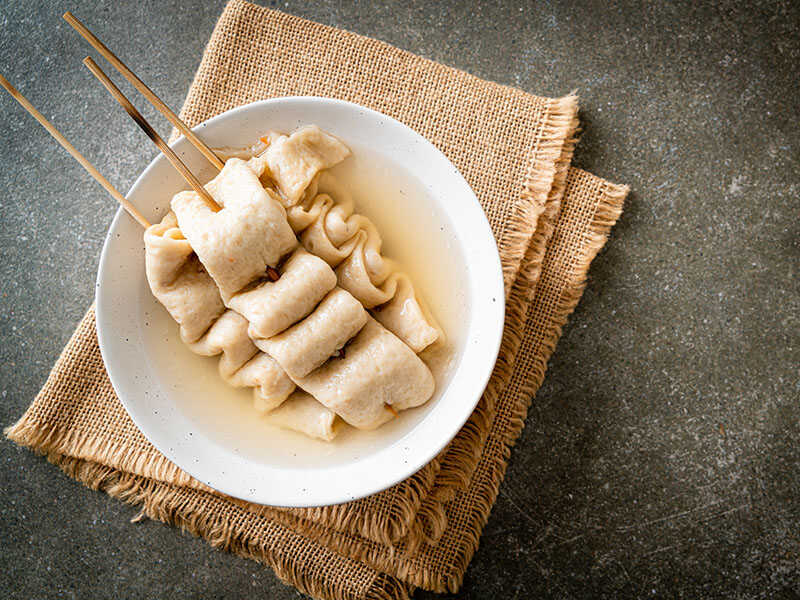
Odeng (eomuk) is a fish cake made from ground white fish and wheat flour. It is a popular street food item, often found alongside Tteokbokki at street stalls.
Odeng is typically skewered with bamboo sticks and served in a small cup with hot broth made from light dashi.
In Korea, locals usually stand in front of the vendors to enjoy it. Odeng is also sold per skewer, allowing you to eat as much as you want. With its mildly salty and fishy taste and slightly chewy texture, Odeng is best consumed warm.
In The Philippines
86. Halo-Halo (Shaved Ice Dessert)
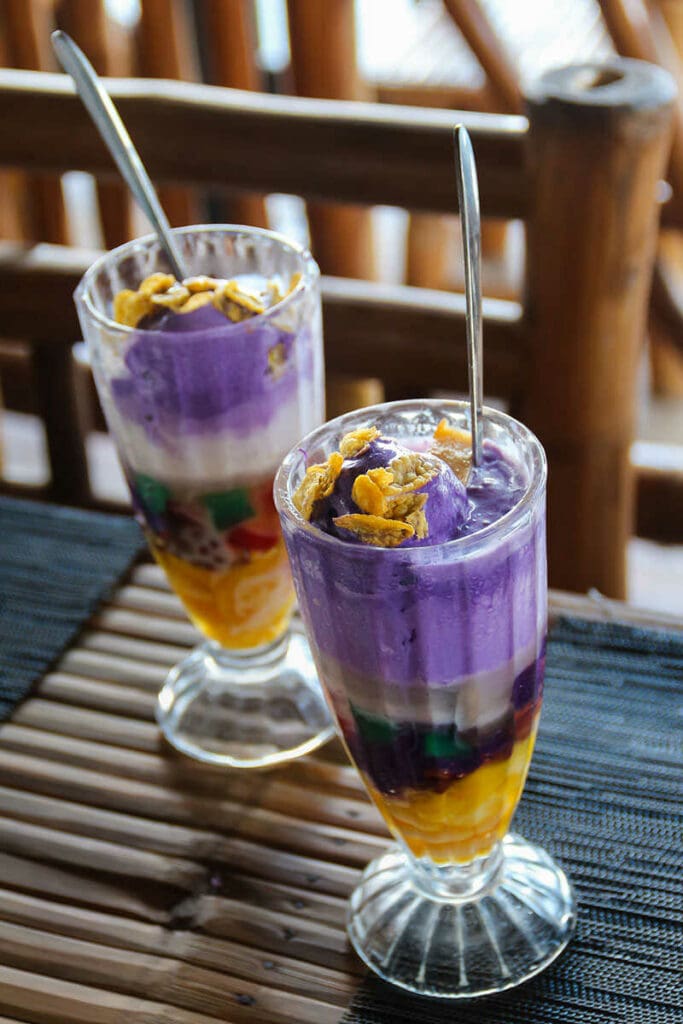
Speaking of must-try Filipino street food, Halo-Halo is a refreshing shaved ice dessert that is perfect for summertime. Its name, which means “mix-mix” in Tagalog, reflects the unlimited combination of ingredients based on personal preference.
It typically includes beans, agar jellies (gulaman), tapioca pearls, fruit, and, most importantly, shaved ice. A scoop of ube ice cream with its vibrant purple color is commonly placed on top.
Halo-Halo is traditionally served in a clear glass with a long spoon to scoop it. However, some variations are even served in coconut shells.
87. Kwek Kwek (Fried Orange Quail Eggs)

Kwek Kwek, a classic and visually amazing street food, is deep-fried hard-boiled quail eggs coated in orange batter. It is typically served with a savory-and-sweet sauce made from sugar, soy sauce, onions, and garlic, or a spiced vinegar dip with a tangy twist.
This delectable treat is sold by street food vendors in bustling areas, often alongside fish balls and squid balls.
88. Tokneneng (Fried Orange Chicken Eggs)
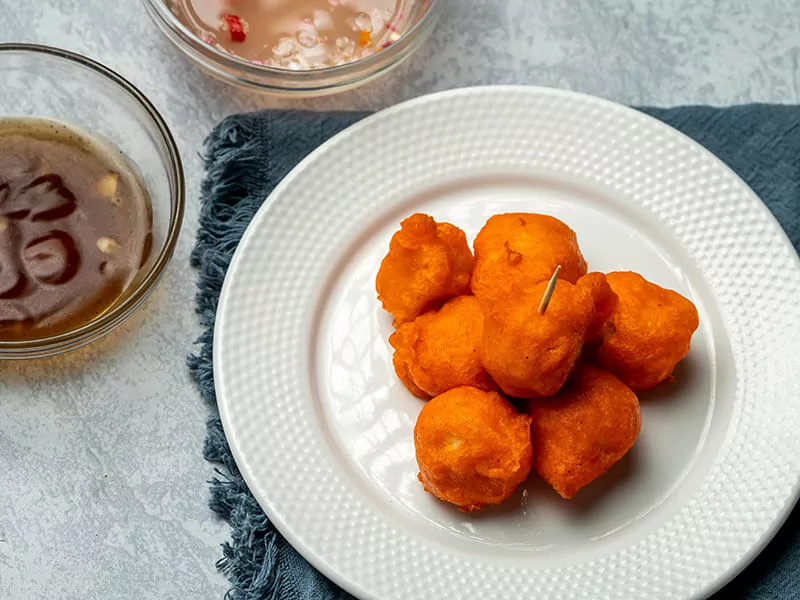
Tokneneng (meaning “egg”) is a bigger cousin of Kwek Kwek. Made using chicken or duck eggs rather than the quail eggs used in Kwek Kwek, Tokneneng shares a similar joy of flavors but in a bigger size.
With the crispy outer shell and a soft, delectable inside, these treats keep you coming back for more!
In Myanmar
89. Lahpet Thoke (Fermented Tea Leaf Salad)
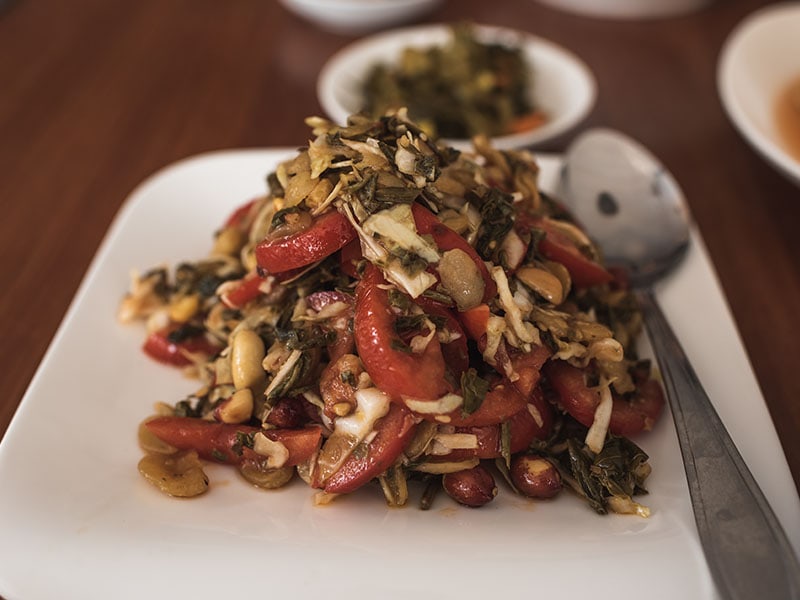
Lahpet Thoke, or fermented tea leaf salad, is a common dish in Myanmar. It can be found as a street food or in the haute cuisine of this nation.
Interestingly, it was historically used as a symbol of peace offering. Today, it is considered the national dish.
The salad features fermented or pickled tea leaves as the main ingredient, along with roasted/fried legumes, vegetables like cabbage and tomato, fish sauce, dried shrimp, and more. Grab a bite, and then you will feel this salad’s tangy, savory, and umami flavor profile.
90. Mohinga (Fish-based Soup With Rice Noodles)
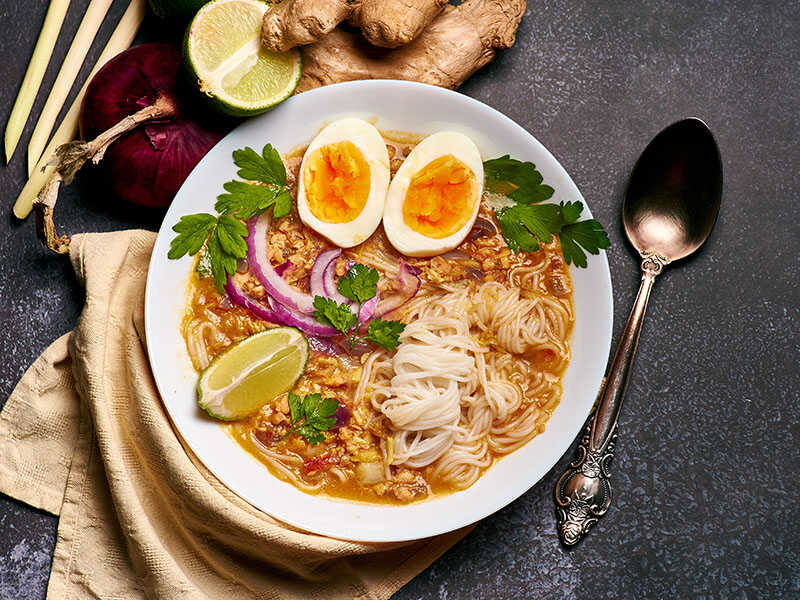
Mohinga is another gem of Myanmar found at street stalls and local eateries nationwide. This iconic dish includes rice noodles swimming in a fragrant fish-based broth, traditionally crafted with catfish or snakehead fish.
Also infused with aromatic spices like lemongrass, ginger, and garlic, the broth is thickened with gram flour for a luscious texture.
Mohinga has various delightful toppings, such as crispy fritters, boiled eggs, fresh herbs, and a splash of lime juice. With its comforting flavors and hearty nature, Mohinga is cherished as a go-to meal any time of the day.
In Laos
91. Khao Jee (Sticky Rice Pancake)
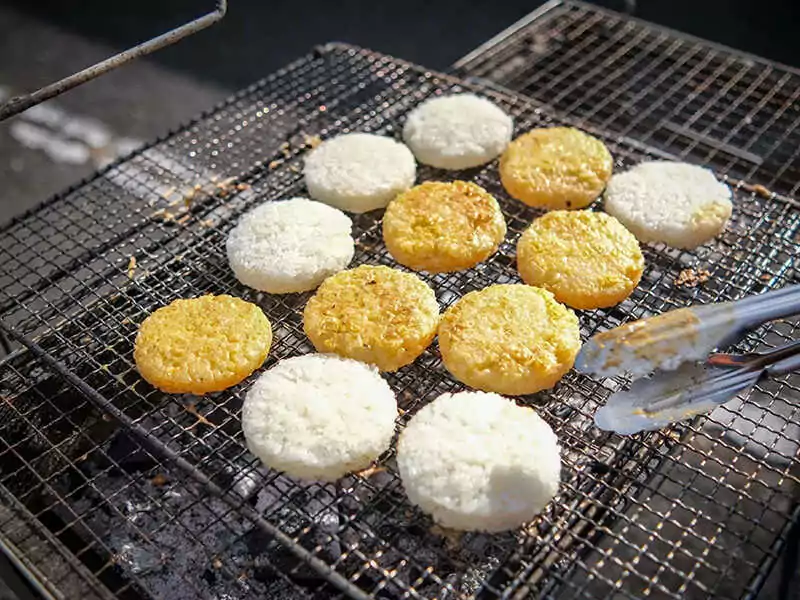
Khao Jee is simply a sticky rice pancake. Sticky rice is a staple food in Lao cuisine, with the highest per capita consumption worldwide at 171 kg per year (2). You can find it at street stalls throughout Laos, and it is also popular in Northeastern Thailand.
This specialty is formed into patties, which are then skewered and grilled over a fire. With skewers, they allow sellers to flip the food without burning their hands.
Khao Jee owns a crispy and nutty exterior with a fluffy center, making it a perfect choice for breakfast or a tasty snack. To enjoy it like the natives, you can add egg coating, a sprinkle of salt, or a padeak coating (Lao fish sauce).
92. Nam Khao (Crispy Rice Salad)
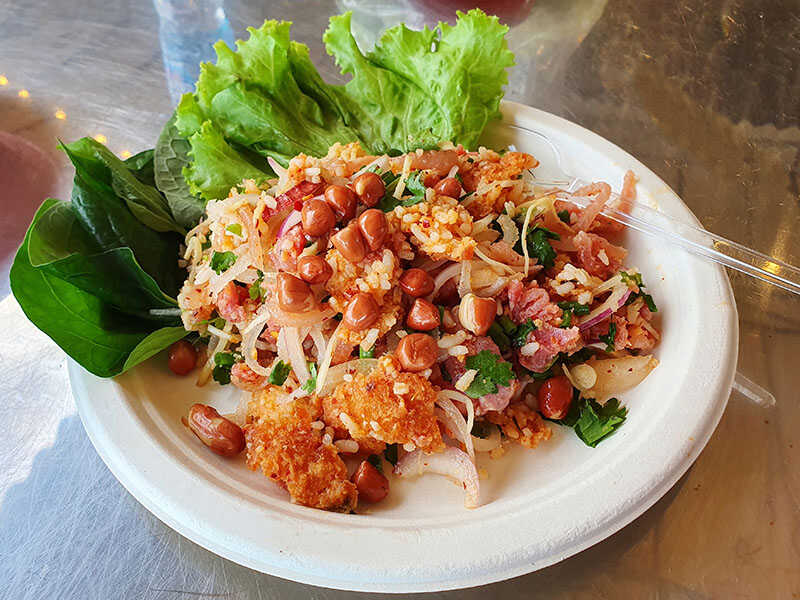
Nam Khao, also known as Yam Naem, is a refreshing and lively salad originating from Tha Deua village in Vientiane, Laos. It features crispy deep-fried rice, Lao fermented pork sausage (som moo), dried coconut, fish sauce, lime juice, and fragrant herbs.
The rice is shaped into balls and then broken to mix with the other salad ingredients. To enjoy, you just simply fill a lettuce leaf with a spoonful of this flavorful salad for a delightful wrap.
In Pakistan
93. Pakora (Deep-Fried Fritter)
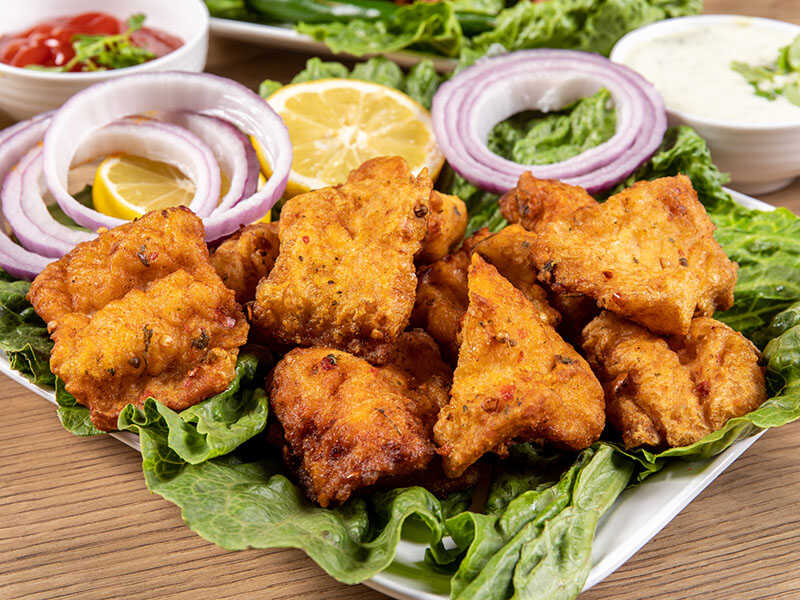
In Indian, Bangladeshi, and Pakistani cuisine, Pakora is a common deep-fried fritter made with vegetables dipped in a besan batter (made from chickpea flour). It is especially loved during Ramadan as pakoras are particularly popular for breaking the fast at iftar time.
They have a golden appearance with a crispy texture due to the deep-frying. Pakoras are enjoyed as snacks from street vendors, appetizers, or side dishes in restaurants.
There are different types, such as aloo pakoras (potato fritters), palak pakoras (spinach fritters), and vegetable pakoras (mixed vegetable fritters). But regardless of which variety you choose, ketchup or chutney is perfect to pair with Pakora.
What’s more, you can enjoy it with a cup of chai.
94. Bun Kebab (Bun With Kebab)
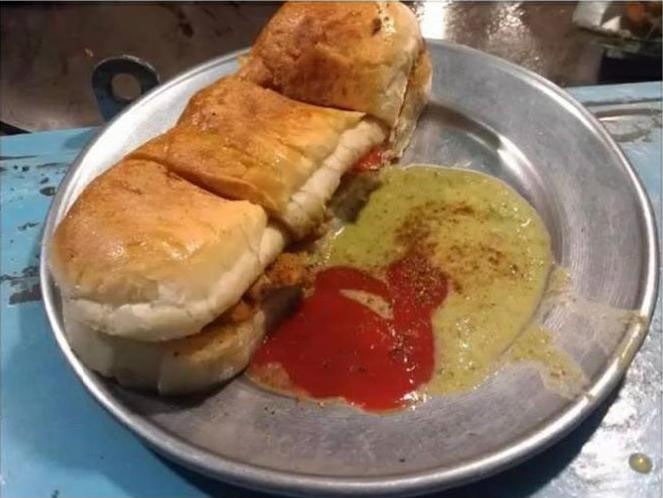
Bun Kebab consists of a flavorful kebab patty sandwiched between seared buns, resembling a burger. If you travel to Karachi and Lahore, you can easily buy them from roadside stalls.
Bun Keband has various patty varieties, including chicken, mutton, beef, potato, and lentil chickpea. The buns are seared on a griddle until crisp and golden brown.
Red onions, tomatoes, cucumber, raita (spicy yogurt dip), and tamarind chutney are classic choices for the topping. However, some vendors even add an egg omelet inside the bun for extra indulgence.
95. Falooda
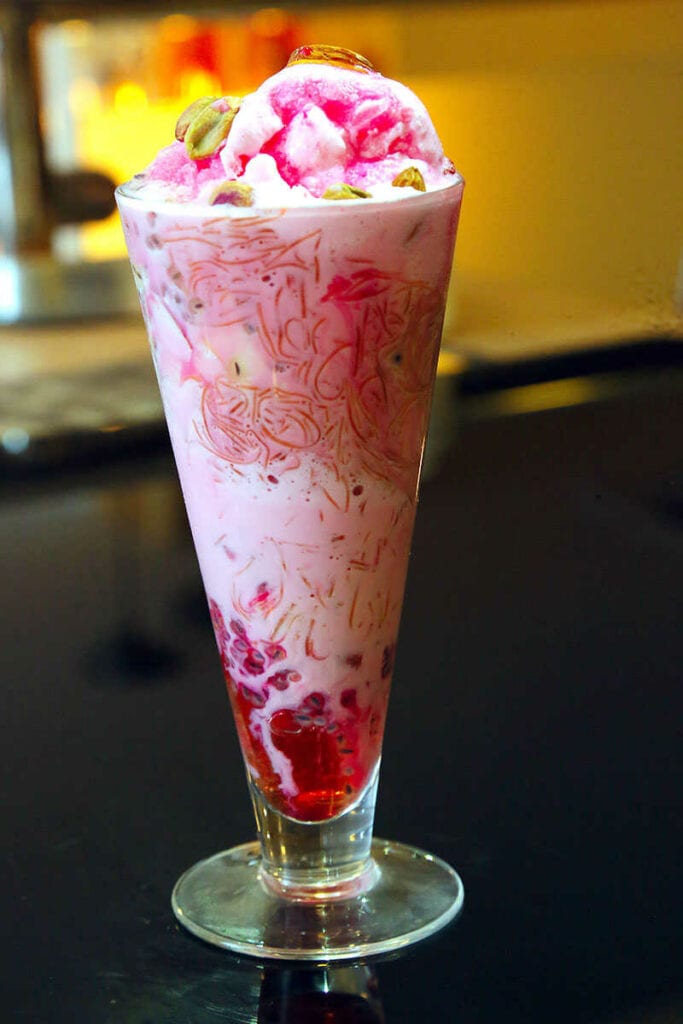
Falooda, with Persian origins, found its way to the Indian subcontinent through trade routes. This milk-based drink is akin to an ice cream sundae, showcasing a perfect combination of Kulfa (gelato-like ice cream), milk, condensed milk, jelly cubes, noodles, and basil seeds.
Sometimes, a touch of rose water syrup lends it a vibrant pink hue. Finally, it’s a feast for the senses if you top it with crushed pistachios or dried fruit.
In Sri Lanka
96. Achcharu
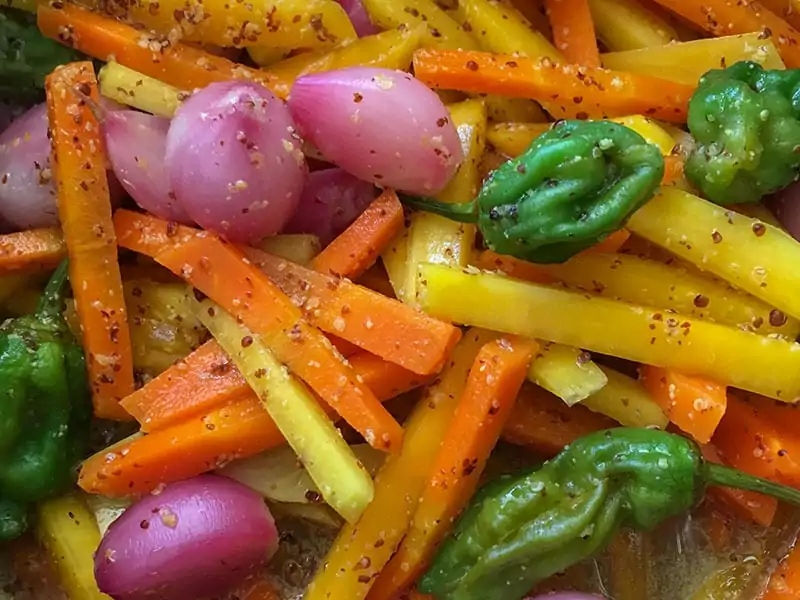
Achcharu refers to pickled fruits and vegetables, commonly made with onion, shallot, carrot, radish, capsicum, or young papaya.
They are mixed with vinegar, sugar, black mustard seeds, chili, and turmeric powder, resulting in a sweet and spicy flavor.
Achcharu is easy to make. Remember to store these pickles in a clean bottle and keep them in the fridge so they can last for months. In order to eat it, you simply enjoy it with curry and rice.
97. Hoppers
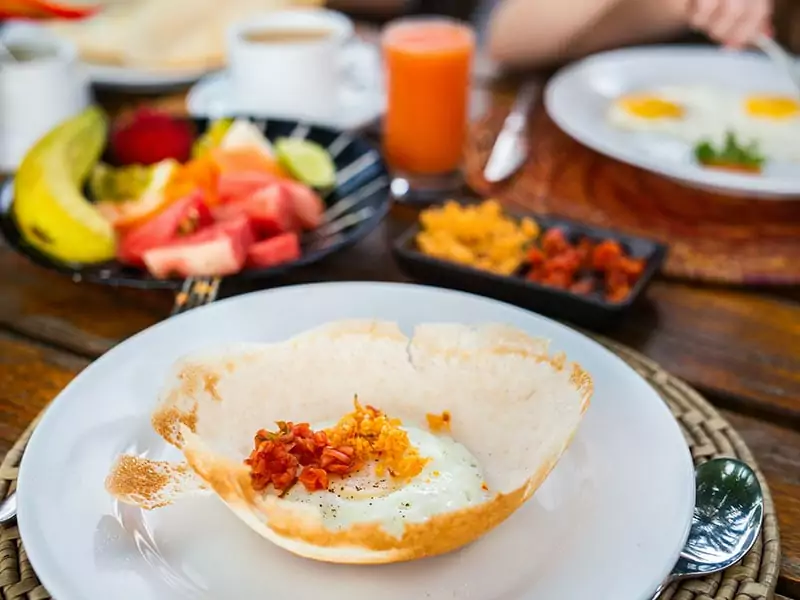
Hoppers, a beloved breakfast variant of Appam in South India, are thin, bowl-shaped pancakes resembling small nests. Named after the pan they are cooked in, hoppers are a delightful and flavorful treat to start the day.
They are made from a fermented batter of rice and coconut milk, with the option of adding an egg on top. Hoppers have crispy edges and a soft center, perfect for scooping up sambol condiment or chili chutney.
In Bhutan
98. Jasha Maroo (Chicken Stew)
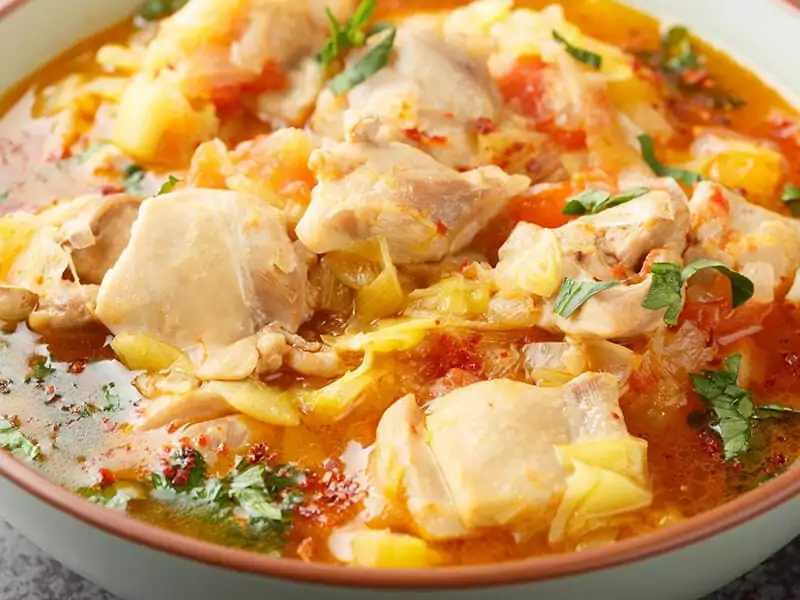
Jasha Maroo is an iconic Bhutanese chicken stew made with chicken, chiles, garlic, ginger, leeks, and tomato. It has a spicy taste with a broth-like texture.
If you are not a big fan of spicy food, you can remove the chile seeds to reduce the heat. This flavorful stew is traditionally served with rice, making it an ideal choice for a hearty meal, particularly for dinner. It is especially enjoyed during the wintertime in Bhutan.
99. Ema Datshi (Spicy Stew)
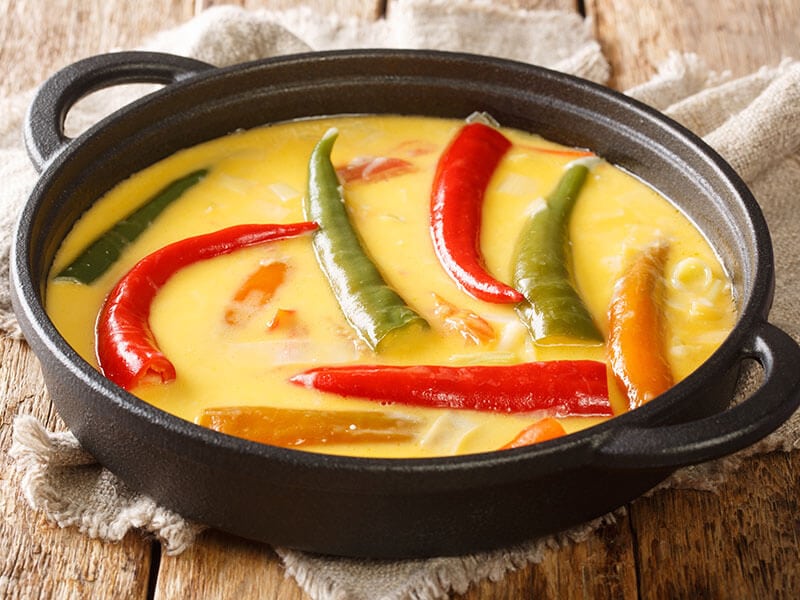
Ema Datshi is the national dish of Bhutan. It is a simple yet flavorful stew, including chili peppers (ema) and cheese (datshi). As a result, it has a spicy and creamy profile.
Whether dried or fresh, suitable chili varieties are red, white, and green. The datshi cheese, made from cow or yak milk, has a texture similar to cottage or ricotta cheese. On the other hand, onion, tomato, and a bed of rice complete this delicious dish.
If authentic datshi is unavailable, you can use any melting cheese. Remember to avoid stringy varieties like mozzarella.
100. Laping (Tibetan Chilled Spicy Noodles)
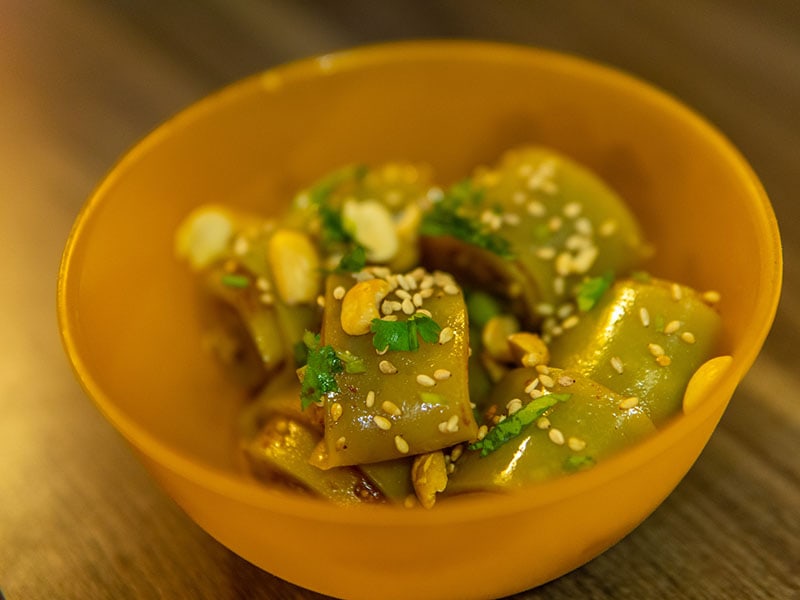
The world of Tibetan cuisine can offer you amazing Laping, a summer specialty that never fails to impress. Commonly served chilled, Lapping features thick noodles with a jelly-like texture crafted from mung beans.
The real magic happens when you combine these noodles with a zesty sauce made from red pepper chili, coriander, and green onion. To elevate the experience, soy sauce gravy adds a rich and savory element.
101. Momo – Nepal, Tibet, Bhutan, and India
(Steamed Filled Dumpling)
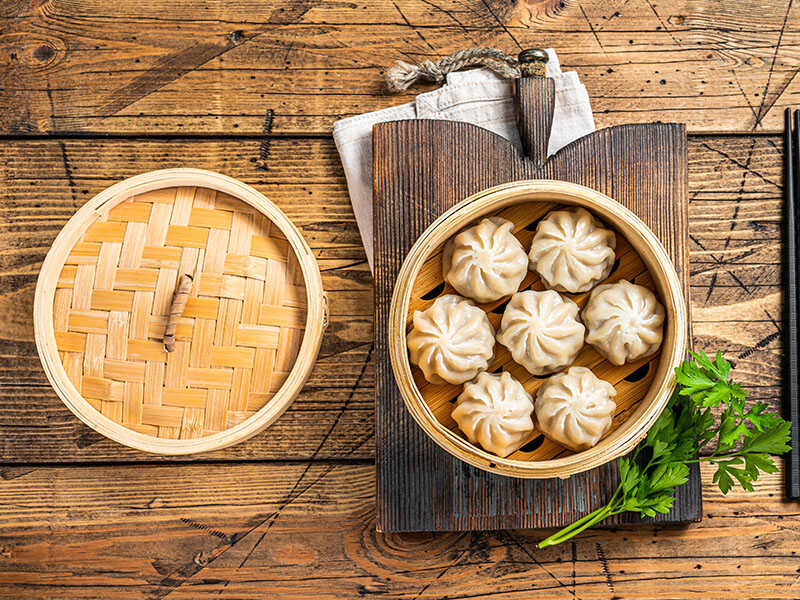
Momo is a steamed filled dumpling popular in Nepal, Tibet, Bhutan, and India. It originated in the Himalayan region and is considered the national dish of Nepal. In this country, they are easy to buy from street vendors and restaurants.
The dumplings have a dough covering filled with ground/minced meat (commonly chicken, pork, or goat) or finely chopped vegetables. They are shaped into half-moons, round pockets, or crescents.
Cooking Momo is diverse, including steaming, pan-frying, or deep-frying. Of course, it is incomplete without various sauces alongside. So stick with tomato chutney or achar sauce (made from soybean) in Nepal, or chili garlic sauce and daikon pickle if they are sold in Tibet.
102. Fuchka or Phuchka – Bangladesh
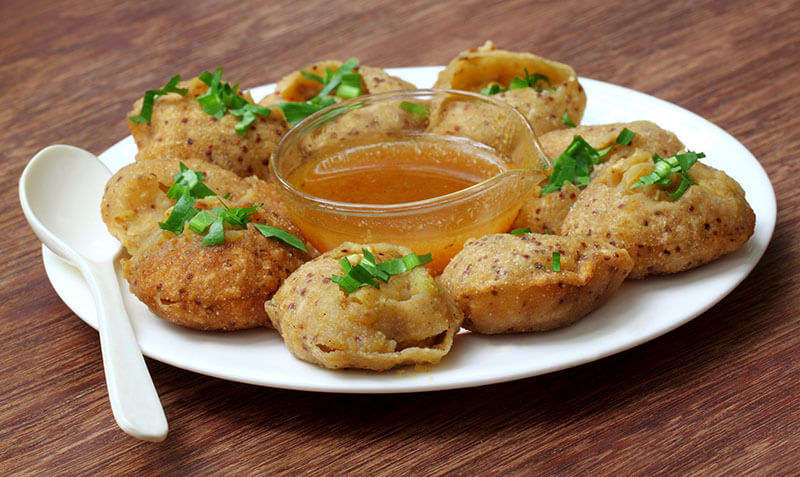
Fuchka (or Phuchka) is a popular street food in Bangladesh with origins in the Indian subcontinent. This delightful snack consists of a hollow puri, a deep-fried round bread, stuffed with a flavorful combination of water, chili powder, boiled potato, and tamarind chutney.
In India, it is called Panipuri or Golgappa, but Fuchka differs by using mashed potatoes as the filling instead of chickpeas masala.
Regarding its taste, the tangy filling with spicy water creates a burst of flavors. To enjoy, you take it all in one bite and savor it immediately, as the puri can quickly become soggy because of the filling.
103. Kavaabu – Maldives
Kavaabu is a traditional snack in the Maldives. These fish fritters are made from flour, smoked tuna, grated coconut, turmeric, onion, curry leaves, and other seasonings. They are shaped into balls with a crispy outside with a soft inside.
If smoked tuna is not available, canned tuna is a suitable substitute. Making Kavaabu at home is straightforward as you only mix the ingredients in a bowl, add flour, and roll into bite-size balls. Remember to squeeze the balls a bit to tighten them.
Finally, fry them until golden brown and place these snacks on a paper towel to absorb excess oil.
104. Kuih Cincin – Brunei
(Ring Cake Snack)
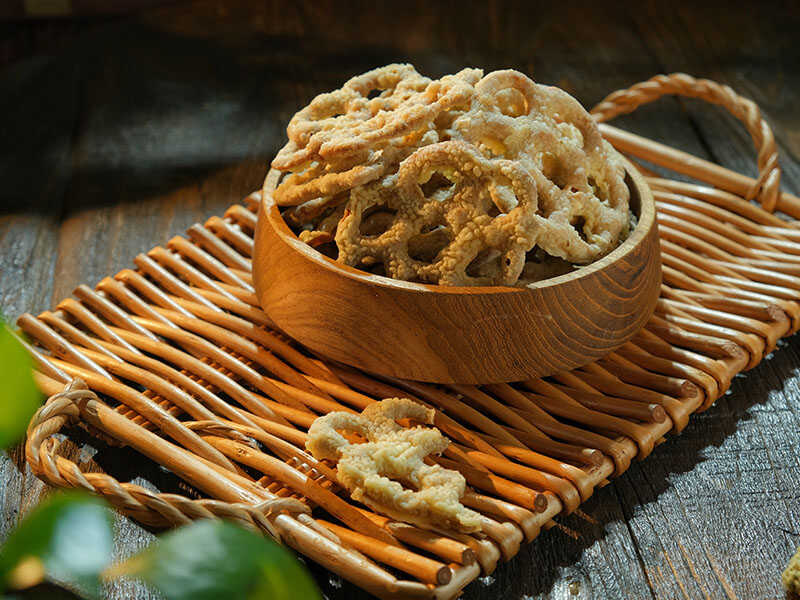
Kuih Cincin, meaning “ring cake,” is a classic snack from Brunei that is also popular among the Bajau community in Malaysia’s Sabah State.
Made with rice flour, red palm, water, palm sugar, and oil, this snack is very special due to its flower-like shape with holes in the middle. Besides its appealing shape, it boasts a nice aroma, sweet and nutty flavor, and crunchiness.
105. Lort Cha – Cambodia
(Stir-Fried Rice Pin Noodles)
Lort Cha is a popular Cambodian dish consisting of stir-fried short rice noodles. Found in local markets, the fresh noodles are stir-fried with a sweet and savory sauce, bean sprouts, and chives.
What’s more, they also have various toppings, such as crushed peanuts, fried egg, fried garlic, green onions, and chili sauce. As the noodles are fresh, it does not require prior cooking, making it a fast and convenient stir-fried dish to enjoy on the street.
106. Shawarma – Middle Eastern Countries
(Roasted Meat On Spit)
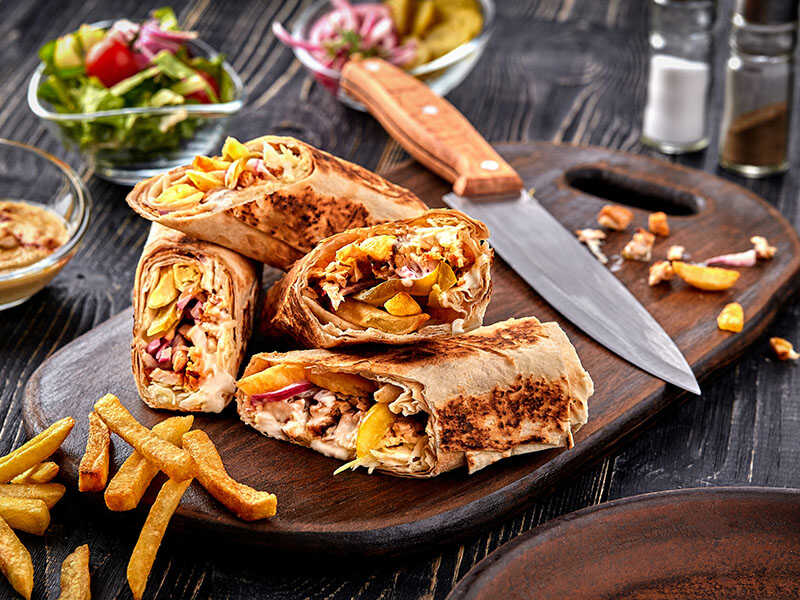
Shawarma, which originated in the Ottoman Empire, is well-loved street food in Middle Eastern countries like Egypt, Lebanon, and Iraq. The key ingredient is meat, such as lamb, mutton, beef, veal, or chicken, stacked on a vertical spit and slowly roasted.
Once cooked, the marinated meat will be thinly sliced and wrapped in a heated pita flatbread or sandwich. It is typically served with pickles, garlic sauce, vegetables, and sometimes fries. Shawarma’s sauce can vary by region. Some classic sauces for it are tahini and hummus.
In addition, Shawarma and Gyro are quite different in terms of flavor. In fact, Shawarma has a more complex and spicy flavor than Gyro.
107. Murtabak – Yemen, Malaysia, Indonesia, Brunei, and Arabian Peninsula
(Stuffed Pancake)
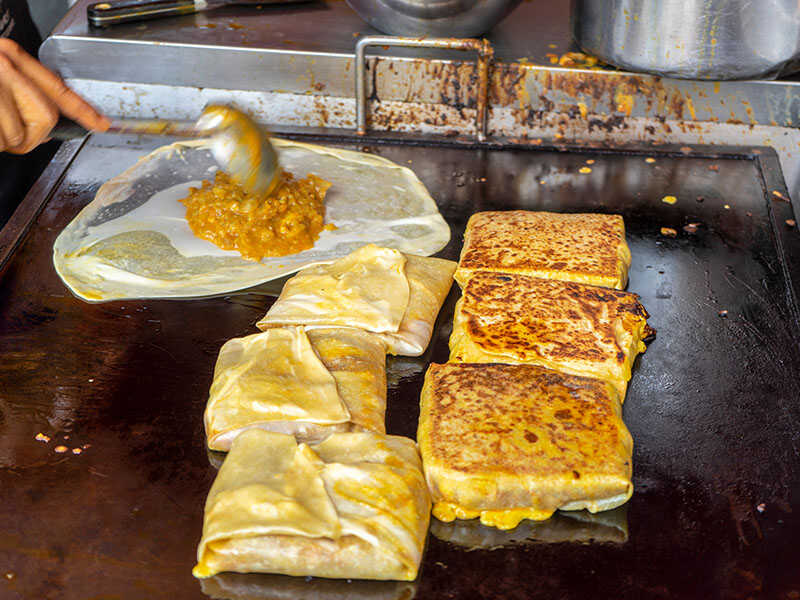
Murtabak is a multi-layered stuffed pancake or pan-fried bread popular in Yemen, Malaysia, Indonesia, Brunei, and the Arabian Peninsula. In terms of its history, it was brought to Southeast Asia by Tamil Muslim traders.
The main ingredients include a bread base, eggs, chili, and onion, but the specific fillings and spices vary across countries. Moreover, this treat goes by different names in various regions.
In Yemen, it often contains minced mutton or goat meat, while in Brunei, it is made with dough only.
In Indonesia, Murtabak is seasoned with turmeric, coriander, cumin, garlic, etc., which is known as Martabak. In Malaysia and Singapore, it is served with curry sauce and onion pickles,
108. Manti (Dumpling) – West Asia and Central Asia
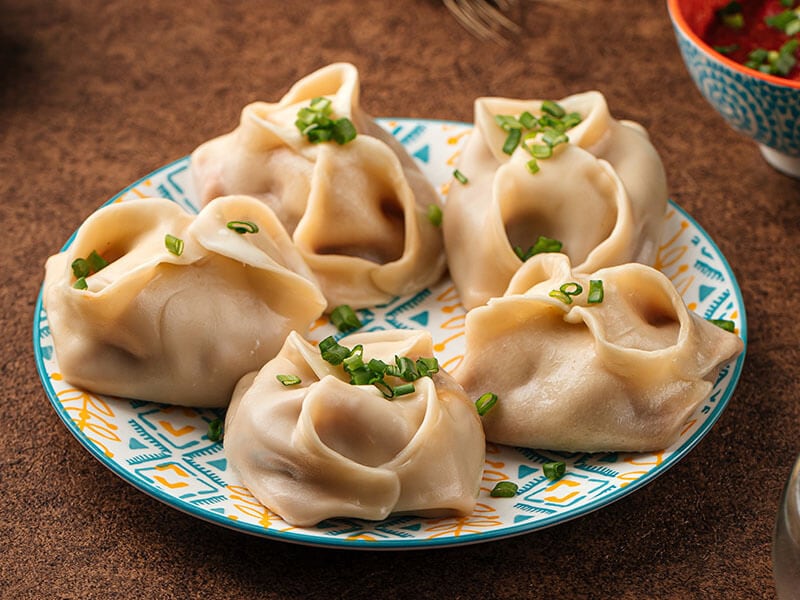
The last delight I’d love to share is Manti, a type of dumpling. Found in West and Central Asian countries, it consists of a thin dough wrapper filled with seasoned ground meat, such as lamb or beef.
In Central Asia, the filling may include black pepper and pumpkin or potato. In Tajik and Uzbek cuisine, butter is a common topping, and ketchup or plain yogurt is the favorite side order.
Furthermore, Central Asian Manti is typically larger and steamed, while Turkish and Armenian versions are often boiled or baked. But no matter the Manti variations, they are all savory and tasty dumplings.
History of Asian Street Food
The Evolution and Origin Of Street Food In Asia
Street food in Asia spans thousands of years, originating from the region’s diverse cultures, traditions, and economic conditions. It is also essential to Asian cuisine’s history and culture.
With the growth of urban centers in ancient civilizations, the need for affordable and accessible food for city dwellers gave rise to the concept of street food.
The preparation methods and ingredients have been influenced significantly by migrations, wars, and trade routes, making the food as diverse as the region’s history itself.
The Role Of Street Food In Historical Times
Historically, street food played a crucial role in Asian societies. It provided sustenance for laborers and other working-class individuals who could not afford to dine at restaurants or cook at home.
Street food vendors also contributed significantly to local economies, creating many micro-entrepreneurs. Moreover, these food stalls became important social spaces where people from different walks of life could interact and engage daily.
Impact On Society And Economy
Street food has made a significant economic and social impact in Asia. Economically, it has offered employment opportunities for many individuals, contributing to poverty reduction.
Socially, it has created gathering spots and encouraged community interaction, and played a critical role in preserving local and regional cuisines in Asia, thereby sustaining cultural heritage.
Common Characteristics of Asian Street Food
Freshness and Local Ingredients
From vegetables, meats, and herbs to spices, the common ingredients in Asia are often procured daily from local markets, guaranteeing their freshness.
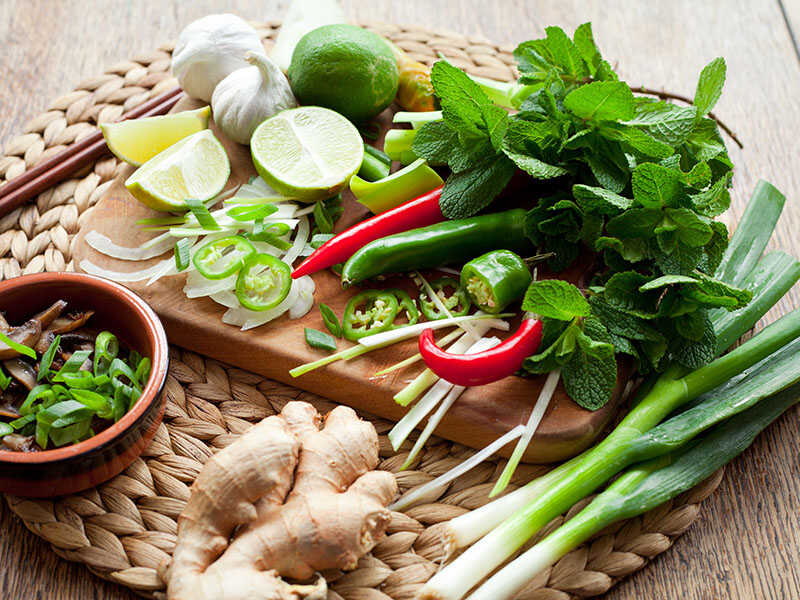
Speed of Preparation and Service
Asian street food is typically known for its quick preparation and fast service. This reflects the busy lifestyle of many Asians, especially in bustling cities. Chefs often demonstrate remarkable skill and efficiency, creating delightful dishes in minutes.
Affordability
Another vital characteristic of Asian street food is its affordability, making it accessible to all, regardless of social class. This affordability doesn’t compromise the taste or quality. It is a reflection of the simplicity and ingenuity of street food culture.
Variety and Uniqueness
Asian street food is celebrated for its remarkable variety and uniqueness. Each country, city, and even neighborhood offers its special street food.
Street Food Markets And Festivals
Famous Street Food Markets In Asia
Asia is home to several renowned street food markets. Bangkok’s Chatuchak Weekend Market, Beijing’s Wangfujing Snack Street, Tokyo’s Tsukiji Fish Market, and Penang’s Gurney Drive Hawker Centre are among the most famous.
Street Food Festivals And Events
Various street food festivals and events are held throughout Asia to celebrate this food culture. These festivals not only showcase a vast array of foods but also often include live music, entertainment, and cultural performances, adding to the overall experience.
The Impact Of Street Food On Tourism
The Role Of Street Food In Attracting Tourists
Street food plays a significant role in attracting tourists to Asia. It offers them a chance to delve into the local culture with exotic dishes often not found in formal dining establishments.
As a result, food tourism has become a considerable part of the travel industry, with many tourists explicitly aiming to explore the street food scene.
Food Tours And Culinary Tourism
Food tours and culinary tourism have grown in popularity in recent years. These organized tours take participants to popular food stalls and markets, and introduce them to local chefs and vendors, providing an unforgettable experience combining food and culture.
These tours are an excellent way for visitors to experience a destination’s culinary scene, as local guides can share their knowledge and offer suggestions that tourists may need help to discover.
For instance, if you are going to Vietnam, make sure to book a foodie tour on a motorcycle to explore the thrill of sitting on a bike and enjoying authentic Vietnamese food with locals.
Stories Of Travelers And Their Street Food Experiences
There are countless stories of travelers being captivated by their experiences with Asian street food. These tales range from sampling exotic dishes for the first time, forming connections with local vendors, or even learning to cook traditional street food.
Asian Street Food In Global Perspective
Spread Of Asian Street Food Around The World
Asian street food has grown substantially globally, spreading far beyond the region’s borders. This is largely due to the increasing interest in global cuisines and the movement of people across continents.
Cities around the world now host a variety of Asian food trucks and stalls, serving dishes such as dumplings, ramen, satay, and bao buns, to name a few.
Influence On Global Food Culture And Fusion Cuisines
The influence of Asian street food on global food culture is undeniable. It has sparked culinary creativity, resulting in fusion cuisines blending Asian street food elements with local dishes.
This can be seen in the explosion of Korean-Mexican fusion food trucks in the USA or the incorporation of elements of Thai street food in Western fine dining.
FAQs
The Colorful Palette of Asian Street Cuisine: A Conclusion
After experiencing the rich tapestry of Asian street foods, I am left fascinated and hungry for more. These delicacies are not just meals but a testament to the region’s deep-rooted cultural diversity and culinary prowess.
I urge you to plunge into the enticing world of Asian street foods and share your thoughts and experiences in the comments. Like and share if you love them too! Thank you!

